.
THE
BIRDS OF AUSTRALIA.
LIST OF PLATES.
VOLUME III.
| Erythrodryas rhodinogaster | Pink-breasted Wood-robin | 1 |
| —— rosea, Gould | Rose-breasted Wood-robin | 2 |
| Petroica multicolor | Scarlet-breasted Robin | 3 |
| —— erythrogastra | Norfolk Island Robin | 4 |
| —— Goodenovii | Red-capped Robin | 5 |
| —— phœnicea, Gould | Flame-breasted Robin | 6 |
| —— bicolor, Swains | Pied Robin | 7 |
| —— fusca, Gould | Dusky Robin | 8 |
| —— superciliosa, Gould | White-eyebrowed Robin | 9 |
| Drymodes brunneopygia, Gould | Scrub Robin | 10 |
| Eöpsaltria Australis | Yellow-breasted Robin | 11 |
| —— griseogularis, Gould | Grey-breasted Robin | 12 |
| —— leucogaster, Gould | White-bellied Robin | 13 |
| Menura superba, Dav. | Lyre-Bird | 14 |
| Psophodes crepitans | Coach-whip Bird | 15 |
| —— nigrogularis, Gould | Black-throated Psophodes | 16 |
| Sphenostoma cristata, Gould | Crested Wedge-bill | 17 |
| Malurus cyaneus | Blue Wren | 18 |
| —— longicaudus, Gould | Long-tailed Wren | 19 |
| —— melanotus, Gould | Black-backed Wren | 20 |
| —— splendens | Banded Wren | 21 |
| —— elegans, Gould | Graceful Wren | 22 |
| —— pulcherrimus, Gould | Beautiful Wren | 23 |
| —— Lamberti, Vig. & Horsf. | Lambert’s Wren | 24 |
| —— leucopterus, Quoy & Gaim. | White-winged Wren | 25 |
| —— melanocephalus, Vig. & Horsf. | Black-headed Wren | 26 |
| —— Brownii, Vig. & Horsf. | Brown’s Wren | 27 |
| Amytis textilis | Textile Wren | 28 |
| —— striatus, Gould | Striated Wren | 29 |
| —— macrourus, Gould | Large-tailed Wren | 30 |
| Stipiturus malachurus | Emu Wren | 31 |
| Dasyornis Australis, Vig. & Horsf. | Bristle-Bird | 32 |
| —— longirostris, Gould | Long-billed Bristle-Bird | 33 |
| Atrichia clamosa, Gould | Noisy Brush-bird | 34 |
| Sphenœacus galactotes | Tawny Sphenœacus | 35 |
| —— gramineus, Gould | Grass-loving Sphenœacus | 36 |
| Acrocephalus Australis, Gould | Reed Warbler | 37 |
| —— longirostris, Gould | Long-billed Reed Warbler | 38 |
| Hylacola pyrrhopygia | Red-rumped Wren | 39 |
| —— cauta, Gould | Cautious Wren | 40 |
| Cysticola magna, Gould | Great Warbler | 41 |
| —— exilis | Exile Warbler | 42 |
| —— lineocapilla, Gould | Lineated Warbler | 43 |
| —— isura, Gould | Square-tailed Warbler | 44 |
| —— ruficeps, Gould | Rufous-headed Warbler | 45 |
| Sericornis citreogularis, Gould | Yellow-throated Sericornis | 46 |
| —— humilis, Gould | Sombre-coloured Sericornis | 47 |
| —— osculans, Gould | Allied Sericornis | 48 |
| —— frontalis | White-fronted Sericornis | 49 |
| —— lævigaster, Gould | Buff-breasted Sericornis | 50 |
| —— maculatus, Gould | Spotted Sericornis | 51 |
| Sericornis magnirostris, Gould | Large-billed Sericornis | 52 |
| Acanthiza pusilla | Little Brown Acanthiza | 53 |
| —— Diemenensis, Gould | Tasmanian Acanthiza | 54 |
| —— Ewingii, Gould | Ewing’s Acanthiza | 55 |
| —— uropygialis, Gould | Chestnut-rumped Acanthiza | 56 |
| —— apicalis, Gould | Western Acanthiza | 57 |
| —— pyrrhopygia, Gould | Red-rumped Acanthiza | 58 |
| —— inornata, Gould | Plain-coloured Acanthiza | 59 |
| —— nana, Vig. & Horsf. | Little Acanthiza | 60 |
| —— lineata, Gould | Striated Acanthiza | 61 |
| —— Reguloïdes, Vig. & Horsf. | Regulus-like Acanthiza | 62 |
| —— chrysorrhœa | Yellow-rumped Acanthiza | 63 |
| Ephthianura albifrons | White-fronted Ephthianura | 64 |
| —— aurifrons, Gould | Orange-fronted Ephthianura | 65 |
| —— tricolor, Gould | Tri-coloured Ephthianura | 66 |
| Xerophila leucopsis, Gould | White-faced Xerophila | 67 |
| Pyrrholæmus brunneus, Gould | Brown Red-throat | 68 |
| Origma rubricata | Rock-Warbler | 69 |
| Calamanthus fuliginosus | Striated Reed-Lark | 70 |
| —— campestris, Gould | Field Reed-Lark | 71 |
| Chthonicola minima | Little Chthonicola | 72 |
| Anthus Australis, Vig. & Horsf. | Australian Pipit | 73 |
| Cincloramphus cruralis | Brown Cincloramphus | 74 |
| —— cantillans, Gould | Black-breasted Cincloramphus | 75 |
| —— rufescens | Rufous-tinted Cincloramphus | 76 |
| Mirafra Horsfieldii, Gould | Horsfield’s Mirafra | 77 |
| Estrelda bella | Fire-tailed Finch | 78 |
| —— oculea | Red-eared Finch | 79 |
| —— Bichenovii | Bicheno’s Finch | 80 |
| —— annulosa, Gould | Black-rumped Finch | 81 |
| —— temporalis | Red-eyebrowed Finch | 82 |
| —— Phaëton | Crimson Finch | 83 |
| —— ruficauda, Gould | Red-tailed Finch | 84 |
| Amadina modesta, Gould[1] | Plain-coloured Finch | 85 |
| —— Lathamii | Spotted-sided Finch | 86 |
| —— castanotis, Gould | Chestnut-eared Finch | 87 |
| —— Gouldiæ, Gould[2] | Gouldian Finch | 88 |
| Poëphila mirabilis, Homb. & Jacq. | Beautiful Grass Finch | 89 |
| —— acuticauda, Gould | Long-tailed Grass Finch | 90 |
| —— personata, Gould | Masked Grass Finch | 91 |
| —— leucotis, Gould | White-eared Grass Finch | 92 |
| —— cincta, Gould | Banded Grass Finch | 93 |
| Donacola castaneothorax, Gould | Chestnut-breasted Finch | 94 |
| —— pectoralis, Gould | White-breasted Finch | 95 |
| —— flaviprymna, Gould | Yellow-rumped Finch | 96 |
| Emblema picta, Gould | Painted Finch | 97 |
1. For Amadina modesta read Estrelda modesta.
2. For Amadina Gouldiæ read Poëphila Gouldiæ.
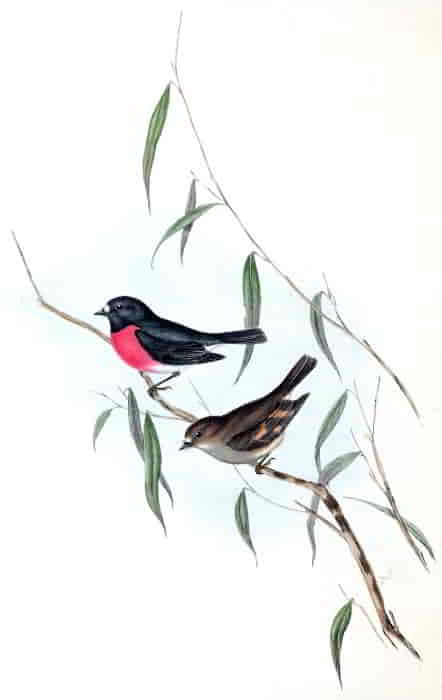
ERYTHRODRYAS RHODINOGASTER.
J. Gould and H. C. Richter delt. C. Hullmandel Imp.
ERYTHRODRYAS RHODINOGASTER.
Pink-breasted Wood-Robin.
Saxicola rhodinogaster, Drap. Ann. Gén. des Sci. Phys. de Bruxelles.
Muscicapa Lathami, Vig. in Zool. Journ., vol. i. p. 410. pl. 13.—Jard. and Selb. Ill. Orn., vol. i. pl. 8.
Petroica rhodinogaster, Jard. and Selb. Ill. Orn. Add., vol. ii.
Erythrodryas rhodinogaster, Gould in Proc. of Zool. Soc., August 9, 1842.
Pink-breasted Robin, Colonists of New South Wales.
The great stronghold of this species is Van Diemen’s Land, particularly the western parts of the island. I feel assured that it is rarely seen on the main land of Australia, from the circumstance of the total absence of skins in collections from those parts. In one instance only did I meet with it on the continent, and that was in a deep ravine under Mount Lofty in South Australia; I shot the specimen, which on dissection proved to be a young male.
In habits and disposition this and the following species are very dissimilar to the Red-breasted Robins (Petroica), being much less spirited in all their actions. They prefer the most secluded and remote parts of the forest, particularly the bottoms of deep gullies, the seclusion of which is seldom broken by the voice or presence of any living being, and where animal life is almost confined to aphides and other minute insects, upon which they exist. There are times, however, especially in winter, when they leave these quiet retreats and even enter the gardens of the settlers; but this is of so rare occurrence, that few persons can have had opportunities of observing this bird in a state of nature, except those who have visited the localities above described. I shot several specimens in the gullies under Mount Wellington in Van Diemen’s Land; and on visiting, in company with the Rev. T. J. Ewing, the enchanting spot selected by my ever-esteemed friend Lady Franklin as a site for a Botanic Garden, I observed it to be tolerably numerous there. Through the kindness of Ronald C. Gunn, Esq., who liberally placed the whole of his collection at my disposal, I was enabled to obtain examples of many species, in every stage from youth to maturity; among others, of the present bird, which Mr. Gunn informed me had been collected on the Hampshire Hills, a locality where it is very abundant.
The food of the Pink-breasted Wood-Robin consists solely of insects, which it procures by darting out in pursuit of them while passing by in the air, and also on the ground.
It exhibits the peculiar actions and manners of the Robins by sitting about on stumps and stones at the bottom of the gullies, presenting its full breast like the Robin of Europe.
Its nest is formed of narrow strips of soft bark, soft fibres of decaying wood, and fine fibrous roots matted and woven together with vegetable fibres, and old black nests of spiders. The eggs are three in number, smaller but very similar to those of Petroica multicolor; of a greenish white thickly sprinkled with light chestnut and purplish brown; eight lines and a half long, by six lines and a half broad.
Like the true Petroicas, the sexes present considerable differences in their colouring.
The male has the head, neck, throat and back sooty black; a small spot of white in the centre of the forehead; wings brownish black; a few of the primaries and secondaries with an oblong spot of reddish brown on the outer web near the base and another near the tip, forming two small oblique bands when the wing is spread; breast and abdomen rose-pink, passing into white on the vent and under tail-coverts; irides and bill black; feet black, with the soles orange.
The female has an indication of the white spot on the forehead; all the upper surface brown; wings and tail brown, with the markings on the primaries and secondaries larger and of a more buffy colour than in the male; throat brownish buff; chest and abdomen brownish grey; vent and under tail-coverts buff.
The young male during the first autumn closely resembles the female; for the first two months after they have left the nest, they have the centre of each feather striated with buff.
The Plate represents the male and female of the natural size.
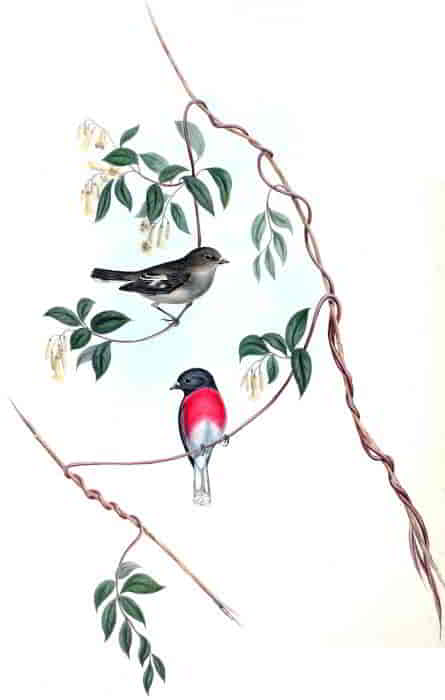
ERYTHRODRYAS ROSEA: Gould.
J. Gould and H. C. Richter delt. C. Hullmandel Imp.
ERYTHRODRYAS ROSEA.
Rose-breasted Wood-Robin.
Petroica rosea, Gould in Proc. of Zool. Soc., Part VII. p. 142.
Erythrodryas rosea, Gould in Ibid., August 9, 1842.
This pretty little Robin inhabits all the brushes which skirt along the south-eastern coast of New South Wales. I also observed it to be numerous in the cedar brushes of the Liverpool range, and it doubtless frequents similar situations in all other parts of the country. It penetrates to the very depths of the forest, and chooses as its favourite abode the most secluded spots. It is a solitary species, more than a single pair being rarely seen at one time, is excessively quiet in its movements, and so tame, that in the course of my wanderings through the woods of Illawarra and in the neighbourhood of the Hunter, it frequently perched within two or three yards of me while resting my wearied limbs under a dense canopy of foliage, and listening to the songs of the various species surrounding me. What has been said respecting the habits and manners of the Pink-breasted Robin is equally descriptive of those of the present bird; its food is also precisely of the same kind, and is captured in a similar manner.
Although it is by no means rare in the localities I have mentioned, but few specimens yet adorn our Museums, and it certainly had not received any scientific appellation until I proposed the one given above, in a letter addressed to the Zoological Society of London during my residence in New South Wales.
Of its nidification and the number and colour of its eggs nothing is at present known.
It has a cheerful inwardly uttered song, the strain of which is very like that of the other Robins, but is much more feeble.
The male has the forehead crossed by a very narrow band of white; crown of the head, throat and all the upper surface dark slate-grey; chest rich rose-red, inclining to scarlet; lower part of the abdomen and under tail-coverts white; wings and the six central tail-feathers blackish brown; the three outer ones on each side tipped with white, the white predominating over the inner webs, particularly on the two lateral feathers; bill and feet blackish brown; gape and soles of the feet yellow.
The female differs considerably from her mate, having the forehead crossed by a narrow band of buff; all the upper surface greyish brown; wings brown; secondaries crossed by two obscure bands of greyish buff; tail of a browner tint, but otherwise marked like that of the male.
The figures are those of a male and a female of the natural size.
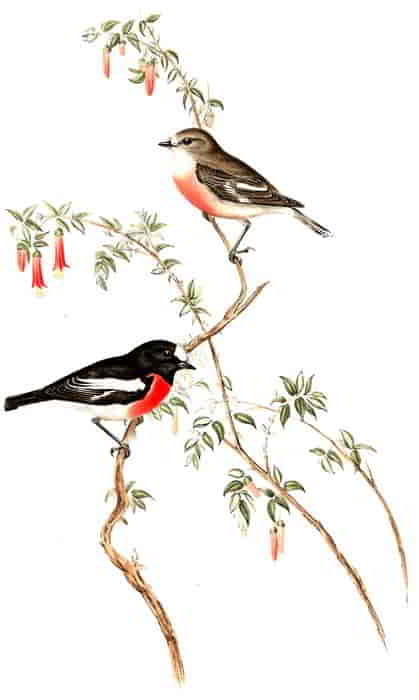
PETROICA MULTICOLOR: Swains.
J. Gould and H. C. Richter delt. C. Hullmandel Imp.
PETROICA MULTICOLOR, Swains.
Scarlet-breasted Robin.
Muscicapa multicolor, Vig. & Horsf. in Linn. Trans., vol. xv. p. 243.
Red-breasted Warbler, Lewin, Birds of New Holl., pl. 17.
Petroica multicolor, Swains. Zool. Ill., 2nd Ser. pl. 36.—Gould in Syn. of Birds of Australia, Part I.—G. R. Gray, List of Gen. of Birds, 2nd Edit., p. 30.
Goȍ-ba, Aborigines of Western Australia.
Robin, Colonists.
This beautiful Robin is a denizen of the wide extent of country reaching from New South Wales on the east to Swan River on the west, including Van Diemen’s Land and all the small islands lying off the southern coast. In Van Diemen’s Land it is much less common than on the continent, and is also far less numerous than its near ally, the Petroica phœnicea. I have not been able with any degree of certainty to trace how far it proceeds northwards. I believe, however, that a few degrees from the latitude of Sydney is the limit of its range in that direction.
Although closely allied to the Petroica phœnicea, its structure on examination will be found to present some trifling modification, which better adapts it for arboreal existence; and although frequently on the ground, where it has much of the habits and actions of the Saxicolinæ, the low bushes and woods skirting the open plains and sterile districts are its favourite places of resort.
Its food consists solely of insects of various orders, its modified structure enabling it to capture both aphides and swift-flying insects as well as the less agile Coleoptera.
When far removed from our native land, recollections and associations are strong incentives to attachment for any object that may remind us of our home; hence this beautiful Robin, which enters the gardens and even the windows of the settlers, is necessarily a great favourite; its attractiveness is moreover much enhanced by its more gay attire, the strong contrasts of scarlet, jet-black and white rendering it one of the most beautiful to behold of any of the birds of Australia. After a careful comparison of a large number of specimens, I feel fully satisfied that the scarlet breast of this species, like that of the Robin of Europe, is assumed during the first autumn, and that it is never again thrown off; but, as might be expected, it is much more brilliant and sparkling during the breeding-season than at any other period of the year. I have remarked that a slight difference exists in the depth of the colouring of specimens from the western and eastern coasts, those from the former, particularly the females, having the scarlet more brilliant and of greater extent than those from New South Wales and Van Diemen’s Land; the difference is, however, too trivial to be regarded otherwise than as indicative of a mere variety.
Its song and call-note much resemble that of the European Robin, but are more feeble, and uttered with a more inward tone.
The nest is a very compact structure of dried grasses, narrow strips of bark, mosses and lichens, all bound firmly together with cobwebs and vegetable fibres, and warmly lined with feathers and wool or hair; in some instances I have seen it lined entirely with opossums’ hair; it is generally placed in the hollow part of the trunk of a tree, or in a slight cavity in the bark six or seven feet from the ground, but I have found it placed in a fork of a small upright tree more than thirty feet from the ground. The eggs, which are three or four in number, are greenish white, slightly tinged with bluish or flesh-colour, rather minutely freckled with olive-brown and purplish grey, the latter more obscure than the former; these freckles are very generally dispersed over the surface of the shell, but in some instances they also form a zone near the larger end; the medium length of the eggs is nine lines, and breadth seven lines.
It usually rears two or three broods in the year, the period of nidification commencing in August and ending in February.
The male has the head, throat and upper surface black; forehead snowy white; a longitudinal and two oblique bands of white on the wings; breast and upper part of the belly scarlet; lower part of the belly dull white; irides very dark brown; bill and feet black.
The female has all the upper and under surface brown, with the breast strongly tinged with red.
The Plate represents a male and female of the natural size, perched on a sprig of a species of Corea, which I found growing on Kangaroo Island.
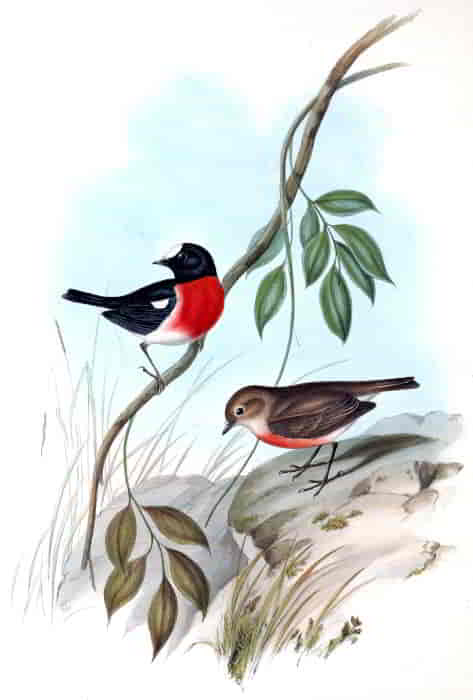
PETROICA ERYTHROGASTER.
J. Gould and H. C. Richter del et lith. Hullmandel & Walton Imp.
PETROICA ERYTHROGASTRA.
Norfolk Island Robin.
Muscicapa erythrogastra, Lath. Ind. Orn., vol. ii. p. 479.—Gmel. Syst. Nat., vol. i. p. 944.
—— multicolor, Gmel. Syst. Nat., vol. i. p. 944.
Red-bellied Flycatcher, Lath. Gen. Syn., vol. iii. p. 343. pl. 50.—Ib. Supp., vol. ii. p. 216.—Shaw, Gen. Zool., vol. x. p. 400. pl. 32.—Lath. Gen. Hist., vol. vi. p. 209. pl. C.—Shaw, Nat. Misc., pl. 147.
Petroica pulchella, Gould in Proc. of Zool. Soc., Part VII. p. 142, male.
—— modesta, Gould in Proc. of Zool. Soc., Part V. p. 147, female.
I have been induced to give a figure of this Robin, which I believe to be strictly confined to Norfolk Island, in order to clear up the confusion which has hitherto existed respecting it and the Petroica multicolor, with which it has been confounded. Under the impression that the two birds were identical, and that the terms erythrogastra and multicolor were synonymous, I was induced some years ago to characterize the male of the present bird under the name of pulchella, and the female under that of modesta, believing as I then did that it was a distinct species; subsequent research has however enabled me to perceive the errors into which I had fallen, and I now proceed to point out the differences between the two species, and to restore to the Norfolk Island bird the term erythrogastra, originally applied to it by Latham. The P. erythrogastra may be distinguished then from its near ally by the greater size of the bill; by the greater extent and more silvery hue of the white feathers on the forehead; by the tail being wholly black, while in the P. multicolor the lateral feathers are white; by the white on the wing forming a large spot near the shoulder, instead of a line as long as the secondaries; and by the scarlet of the breast and abdomen being much more intense in colour: the females of the two birds also differ from each other, the tail of the P. erythrogastra being wholly brown, while that of the P. multicolor has the lateral tail-feathers marked with white.
The male has the forehead silvery white; a small patch on the wings near the shoulder, under wing-coverts, the flanks and under tail-coverts white; chest and abdomen very rich scarlet, the remainder of the plumage deep black; bill black; feet brown.
The female has the crown of the head, all the upper surface, wings and tail reddish brown; throat white, tinged with brown; chest and centre of the abdomen washed with scarlet; lower part of the abdomen and under tail-coverts white; flanks brown; bill blackish brown; feet yellowish brown.
The figures represent the two sexes of the natural size.
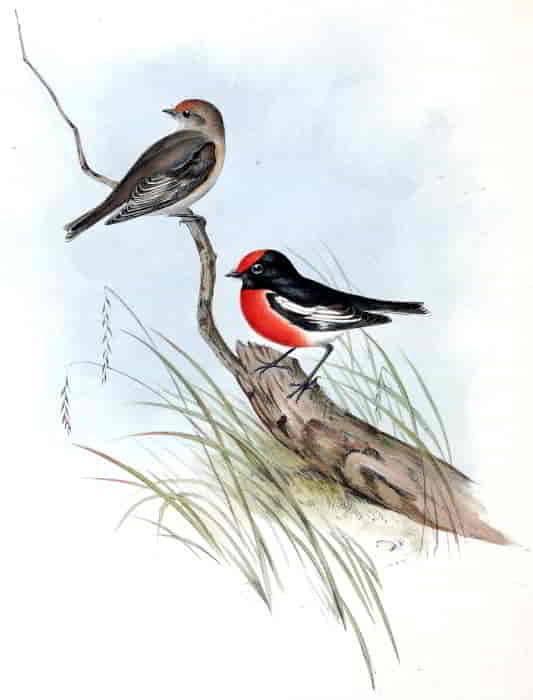
PETROICA GOODENOVII: Jard. and Selb.
J. Gould and H. C. Richter delt. C. Hullmandel Imp.
PETROICA GOODENOVII, Jard. and Selb.
Red-capped Robin.
Muscicapa Goodenovii, Vig. & Horsf. in Linn. Trans., vol. xv. p. 245.—Jard. and Selb. Ill. Orn., vol. i. pl. 8, fig. 2.
Petroica Goodenovii, Jard. and Selb. Ill. Orn., Add., vol. ii.—Gould, Syn. Birds of Australia, Part I.
Mȅ-ne-gȅ-dang, Aborigines of the mountain districts of Western Australia.
Red-capped Robin of the Colonists.
The red crown and much smaller size of this beautiful Robin at once distinguishes it from every other species of the genus yet discovered. Although not plentiful in any part I have visited, it is very generally distributed over the whole of the southern portion of Australia. I have observed it myself in South Australia and in New South Wales, and Mr. Gilbert killed it in Western Australia, where, however, it is very local, for he only met with it in two spots, one in the York district and the other at Kojonup, about one hundred miles towards the interior from King George’s Sound. I have not yet heard of its being an inhabitant of the northern portion of the country.
I generally observed it either singly or in pairs, and it appeared to give a decided preference to the beds of dry rivulets, and to thinly timbered plains, the dense brushes near the coast never being visited by it; it would seem therefore to be a species peculiar to the interior of the country.
The whole of the actions and economy of this bird so closely assimilate to those of the Petroica multicolor, that it is unnecessary to repeat a description of them here; of its nidification no information has yet been obtained; but in this respect also it doubtless closely resembles the same species.
It possesses a peculiarly sweet and plaintive song, very much like that of the European Robin, but more weak and not so continuous.
Its food consists of insects of various kinds.
The male has the upper surface, neck, upper part of the breast and wings brownish black; wing-coverts and secondaries edged with white, forming a broad stripe along the wings; middle of the outer web of the quills with a narrow white margin; forehead, crown, and lower part of the breast bright scarlet, passing into white on the vent; irides, bill and feet blackish brown; soles of the feet yellow.
The female, as is the case with the females of the other species, differs much from her mate in the colouring of the plumage, which difference will be more clearly perceived in the accompanying illustration than by the most minute description.
The Plate represents the two sexes of the natural size.
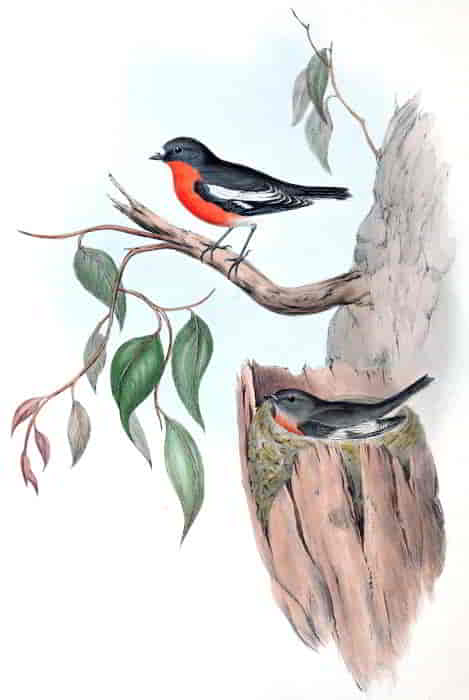
PETROICA PHŒNICEA: Gould.
J. Gould and H. C. Richter delt. C. Hullmandel Imp.
PETROICA PHŒNICEA, Gould.
Flame-breasted Robin.
Petroica phœnicea, Gould in Proc. of Zool. Soc., Part IV. p. 105; and in Syn. Birds of Australia, Part I.
Van Diemen’s Land and the south-eastern portion of the Australian continent constitute the natural habitat of this species; in the former country it is very common, but in New South Wales and South Australia it is not so numerous, and is very local. It is far less arboreal than the Petroica multicolor, giving a decided preference to open wastes and cleared lands rather than to the woods: in many of its actions it much resembles the Wheatears and other true Saxicoline birds, often selecting a large stone, clod of earth or other substance, on which to perch and show off its flame-coloured breast to the greatest advantage. As the season of nidification approaches it retires to the forests for the purpose of breeding, building its cup-shaped nest in the chink of a tree, in the cleft of a rock, or any similar situation. It is a very familiar species, seeking rather than shunning the presence of man, and readily taking up its abode in his gardens, orchards, and other cultivated grounds. It is to be found in the neighbourhood of Hobart Town at all seasons of the year, and I have even taken its nest from a shelving bank in the streets of the town.
Its food consists of insects of various kinds, which are principally procured on the surface of the ground.
It has a pretty cheerful song, uttered somewhat low and inwardly; the male generally sings over or near the female while she is sitting upon her eggs.
The nest, which is thick and warm, is formed of narrow strips and thread-like fibres of soft bark, matted together with cobwebs and sometimes wool, and lined with hair and feathers, or occasionally with fine hair-like grasses. The general colour of the eggs is greenish white, spotted and freckled with purplish and chestnut-brown: much variety occurs in these markings, some assuming the form of large bold irregular spots and blotches, while in others they are merely minute freckles; the eggs are three in number; their medium length nine lines, and breadth seven lines.
I have not yet satisfied myself respecting the changes which this species undergoes, or what time elapses before it assumes the red garb; some individuals certainly breed while in the brown dress, and they may frequently be heard singing while clothed in this sombre-coloured plumage; the Petroica multicolor, on the contrary, would appear to obtain its red breast during the first autumn, as I have a specimen killed on the 8th of February with a fine red breast, while the colouring of the other parts of its plumage is indicative of immaturity.
The male has the crown of the head and all the upper surface sooty grey, except a small white spot across the forehead, a patch of the same colour on the shoulders and the anterior edges of the tertials; primaries and tail-feathers greyish black, except the outer feathers of the latter, which are nearly all white; the second tail-feather on each side is also tinged with white; upper part of the throat sooty grey, the rest of the under surface rich scarlet; under tail-coverts white; irides, bill and feet black.
The female is uniform brown above; wings dark brown; tertials and wing-coverts edged with reddish grey; tail brown; the outer tail-feathers on each side almost wholly white; all the under surface reddish grey; irides, bill and feet black.
The young resembles the female, but has the centre of the feathers lighter, and the corners of the mouth yellow; bill and feet blackish brown.
The Plate represents the male, female and nest of the natural size.
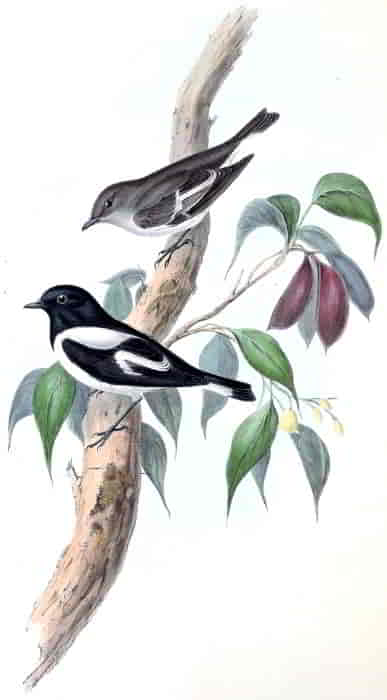
PETROICA BICOLOR: Swains.
J. Gould and H. C. Richter delt. C. Hullmandel Imp.
PETROICA BICOLOR, Swains.
Pied Robin.
Muscicapa cucullata, Lath. Ind. Orn. Supp., p. 51?
Hooded Flycatcher, Lath. Gen. Syn., Supp., vol. ii. p. 223? and Gen. Hist., vol. vi. p. 216?
Petroica bicolor, Swains. III. Zool., 2nd Ser., pl. 43.
Jil-but, Aborigines of the mountain districts of Western Australia.
Goȍ-ba-mȍgin, Aborigines around Perth, Western Australia.
Black Robin of the Colonists.
If we consider the Pied Robins from Swan River and the north-west coast of Australia as identical with, or mere varieties of, those killed in New South Wales, from which they differ only in being smaller in all their admeasurements, then the range of the present bird will be very extensive, and in fact its dispersion over the Australian continent almost universal. The Petroica bicolor has never been found in Van Diemen’s Land, nor is it probable that it proceeds so far south. It loves to dwell in the open parts of the country rather than in the thick brushes. I have always found it most numerous on such flats as were studded here and there with large trees, among the lower branches of which, as well as on the ground immediately beneath them, it might be observed darting about for insects in the most bold and active manner; the jet-black colouring of its upper surface, contrasted with the whiteness of the other parts, rendering it very conspicuous, particularly when its wings and tail are displayed to their full extent.
Its food consists solely of insects of various kinds, particularly coleoptera and their larvæ.
The breeding-season commences in September and continues during the four following months; in this period two broods at least are reared. The nest, which is rather small and shallow, is formed of dried grasses, strips of bark and fibrous roots, bound together and partly smoothed over with cobwebs, the inside being lined with fine wire-like fibres, and generally a little wool at the bottom; it is placed on the dried branch of a small tree, resting against the trunk, or in the fork of a fallen branch within two or three feet of the ground. The eggs, which are three in number and of a rather lengthened form, are light olive green without any spots or markings, but occasionally washed with brown, particularly at the larger end; their medium length is ten lines and a half, and breadth seven lines and a half.
This species possesses a simple call-note, so feeble and weak as only to be heard at the distance of a few yards.
The male has the head, throat, neck, back, rump, upper tail-coverts and the two centre tail-feathers deep velvety black; the next tail-feather on each side black on the inner web, white on the outer web, and largely tipped with black, the remainder of the tail-feathers white, largely tipped with black; feathers covering the insertion of the wing white; wings dull black, the secondaries edged with white; an oblique band of white across all but the two first primaries near their base; under surface of the shoulder, breast, abdomen and under tail-coverts white; irides brownish black; bill black; feet blackish brown.
The female has the upper surface dark brownish grey; wings brown, with the oblique band less prominent than in the male; under surface light brownish grey, passing into white on the vent and under tail-coverts; tail brown, the lateral feathers white at the base, the white continuing to near the tip on the external web of the outer feather.
The young immediately after leaving the nest is dark brown, with a stripe of light brown down the centre of each feather, the markings of the wings and tail resembling those of the adult; under surface like the upper, but becoming white as it proceeds towards the vent.
The Plate represents the male and female on a branch of the Currijong, all of the natural size.
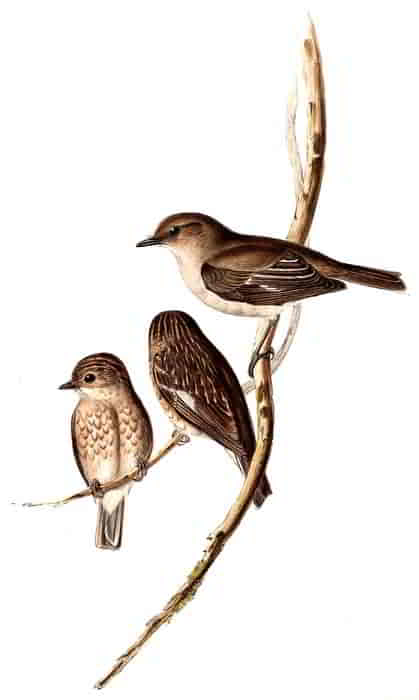
Petroica Fusca: Gould.
J. Gould and H. C. Richter delt. C. Hullmandel Imp.
PETROICA FUSCA, Gould.
Dusky Robin.
This unadorned species of Robin is very abundantly distributed over all those parts of Van Diemen’s Land that are suitable to its habits; it gives preference to thinly-timbered hills, and all such plains and low grounds as are sterile and covered here and there with thickets and stunted brushwood. In its manners and whole economy it closely assimilates to the Red-breasted Robins; I frequently observed it sitting on the stumps of dead and fallen trees, on the railings of inclosures, gardens and other similar situations. Its food appeared to consist solely of insects, which it swallows entire, even coleoptera of a large size.
Its nest, which is rather large and of a cup-shape, is formed of coarse fibrous roots, small twigs, strings of bark and dried grasses intermixed with very fine hair-like fibrous roots, wool, and the soft seed-stalks of mosses. The size and form of the nest depend upon the nature of the situation chosen for a site; if a ledge or fissure of a rock, it is much spread out, but with the inside and top very neatly finished; the opening measures on an average about two inches and a half, and the nest is about one inch and a quarter in depth.
The eggs, which are three or four in number, differ in colour from those of every other member of the genus, but more nearly assimilate in tint and markings to those of Petroica bicolor than of any other. They are of a light greenish blue, freckled and spotted with minute indistinct markings of brown; their medium length is ten lines, and breadth seven and a half lines.
Although I have paid considerable attention to the distribution of this species, I have never been able to meet with it on the continent of Australia, or in any other country than Van Diemen’s Land; still I cannot positively assert that it is not an inhabitant of the Australian continent. It is very numerous about Hobart Town, both in the gulleys under Mount Wellington, and on the opposite side of the Derwent towards Clarence Plains.
Its note is low and monotonous, without any peculiar character.
The sexes differ from all the other members of the genus in being alike in colour, and cannot possibly be distinguished without the aid of dissection.
Head, and all the upper surface reddish brown tinged with olive; wings and tail brown; primaries and secondaries crossed by a narrow line of white at the base; the outer tail-feather on each side margined externally, and at the tip with white; under surface pale brown, passing into buffy white on the vent and under tail-coverts; irides, bill and feet blackish brown.
The young is very dark brown above, striated with deep buff; beneath mottled brown and buffy white; the latter colour occupying the centre of the feathers.
The Plate represents a male and two young birds of the natural size.
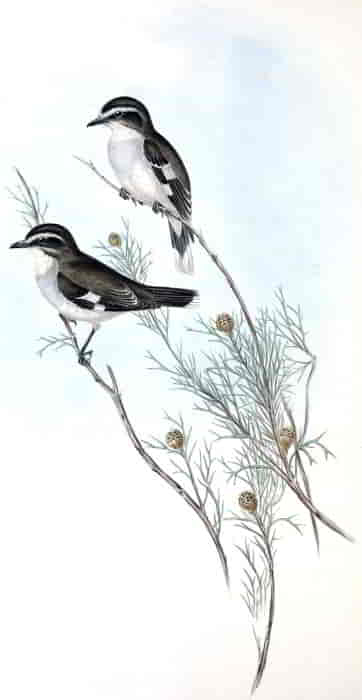
PETROICA SUPERCILIOSA: Gould.
J. Gould and H. C. Richter del et lith. Hullmandel & Walton Imp.
PETROICA SUPERCILIOSA, Gould.
White-eyebrowed Robin.
Petroica superciliosa, Gould in Proc. of Zool. Soc., Part XIV. p. 106.
For our knowledge of this new species of Petroica we are indebted to the researches of Mr. Gilbert, who while in company with Dr. Leichardt, during his adventurous expedition from Moreton Bay to Port Essington, discovered it in the neighbourhood of the Burdekin Lakes towards the Gulf of Carpentaria. The following remarks in Mr. Gilbert’s Journal comprise all that is at present known respecting it:—“May 14th. In a ramble with my gun I shot a new bird, the actions of which assimilate to those of the Petroicæ and the Eöpsaltriæ; like the former it carries its tail very erect, but is more retiring in its habits than those birds; on the other hand, its notes resemble those of the latter. It inhabits the dense jungle-like vegetation growing beneath the shade of the fig-trees on the banks of the Burdekin. I succeeded in procuring two specimens.”
Superciliary stripe, throat, abdomen, under surface of the shoulder, and the bases of the primaries and secondaries white; lores, ear-coverts, wing-coverts, and the primaries and secondaries for some distance beyond the white deep black; all the upper surface, wings and tail sooty brown; all but the two central tail-feathers largely tipped with white; bill and feet black; irides reddish brown.
The Plate represents the two sexes of the natural size.
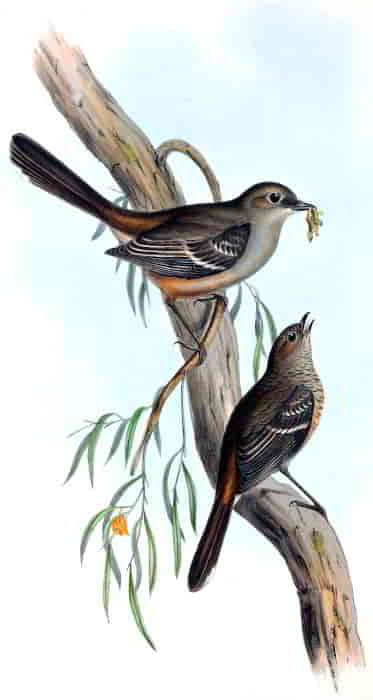
DRYMODES BRUNNEOPYGIA: Gould
J. Gould and H. C. Richter del et lith. C. Hullmandel Imp.
DRYMODES BRUNNEOPYGIA, Gould.
Scrub Robin.
Drymodes brunneopygia, Gould in Proc. of Zool. Soc., Part VIII. p. 170.
I discovered this singular bird in the great Murray Scrub in South Australia, where it was tolerably abundant; I have never seen it from any other part of the country, and it is doubtless confined to such portions of Australia as are clothed with a similar character of vegetation. It is a quiet and inactive species, resorting much to the ground, over which and among the underwood and low stunted bushes it passes with great ease; it appeared rarely to take wing, but to depend for security upon its dexterity in hopping away under the dense underwood of the most scrubby parts; I have, however, occasionally observed it to mount to the most elevated part of a low bush, and there pour forth a sharp monotonous whistling note, not very unlike that of some of the Pachycephalinæ; indeed it was its note that first attracted my attention and led to its discovery. When on the ground, and sometimes when perched on a twig, it elevates its tail considerably, but not to the extent of the Maluri.
This new form evidently belongs to the Saxicolinæ, and has many habits in common with the members of the genus Petroica.
The sexes are alike in colouring, but the female is much smaller than her mate; the young, as will be seen in the accompanying Plate, resembles the immature Petroicas in the character of its plumage.
Head and all the upper surface brown, passing into rufous brown on the upper tail-coverts; wings dark brown, the coverts and primaries edged with dull white; primaries and secondaries crossed near the base on their inner webs with pure white; tail rich brown, all but the two middle feathers tipped with white; under surface greyish brown, passing into buff on the under tail-coverts; irides, bill and feet blackish brown.
The Plate represents an adult male and a young bird of the natural size.
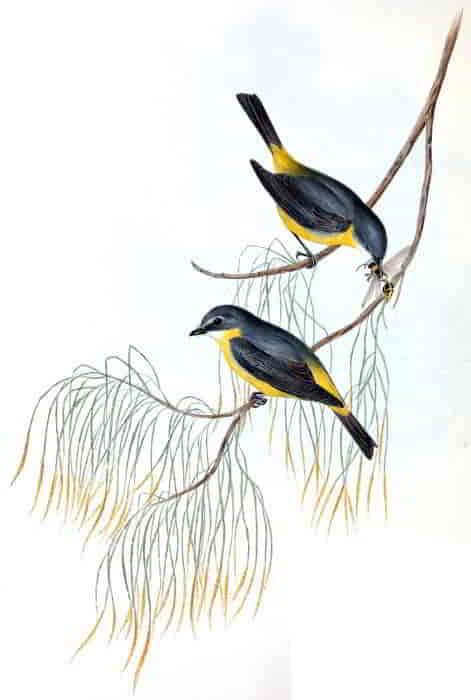
EÖPSALTRIA AUSTRALIS: Swains.
J. Gould and H. C. Richter del et lith. C. Hullmandel Imp.
EÖPSALTRIA AUSTRALIS.
Yellow-breasted Robin.
Muscicapa Australis, Lath. Ind. Orn. Supp., p. li.
Southern Motacilla, Motacilla Australis, White’s Journ., pl. in p. 239.
Southern Flycatcher, Lath. Gen. Syn. Supp., vol. ii. p. 219.—Shaw, Gen. Zool., vol. x. p. 369.—Lath. Gen. Hist., vol. vi. p. 216.
Pachycephala Australis, Vig. & Horsf. in Linn. Trans., vol. xv. p. 242.
Muscipeta, sp. 15, Muscicapa Australis, Less. Traité d’Orn., p. 385.
Eöpsaltria flavicollis, Swains. Class, of Birds, vol. ii. p. 250.
—— Australis, G. R. Gray, List of Gen. of Birds, 2nd edit. p. 45.
Yellow-breasted Thrush, Lewin, Birds of New Holl., pl. 23.
Eöpsaltria parvula, Gould in Proc. of Zool. Soc., Part V. p. 144. female?
Yellow Robin, Colonists of New South Wales.
This is a very common species in all the brushes of New South Wales; I also observed it in most of the gardens in the neighbourhood of Sydney, as well as in those of the settlers in the interior. It is very Robin-like in its actions, particularly in the habit of raising its tail at the moment of perching, and in the sprightly air with which it moves about. It is by no means shy, and may often be seen crossing the garden walks, perching on some stump or railing, regardless of one’s presence, at which time the fine yellow mark on its rump is very conspicuous. Its powers of flight are but feeble, and are seldom employed to do more than enable it to flit from bush to bush or from tree to tree, in a peculiarly quiet Robin-like manner; never displaying the restless activity of the Pardalotes, Acanthizas, and many other tribes of birds. Its food consists entirely of insects, which are more frequently taken on the ground than on the trees.
It breeds in September and October. The nest is a beautiful, compact, round, cup-shaped structure, about three inches in diameter and an inch and a half deep, composed of narrow strips of bark, wiry fibrous roots, and in some instances grasses; the outside held together with cobwebs, and sparingly speckled over with mouse-eared lichen and small pieces of bark, hanging loosely about it; the inside of the nest is generally lined with leaves, but occasionally with portions of the broad blades of grasses. It is generally placed in the fork of some low tree in an open or exposed part of the brush, is a neat structure, and sometimes so nearly resembles the bark of the tree upon which it is constructed, that it is almost impossible to detect it, so extraordinary is the instinctive power of imitation with which the bird has been endowed. The eggs are usually two in number, of a bright apple-green, speckled and spotted all over with chestnut-brown and blackish brown, the latter tint being much less conspicuous than the former; they are nine lines long by seven and a half lines broad.
It is not migratory, and so far as is known, is confined to the southern and eastern portion of the country.
The sexes are alike in colour, but the female is somewhat smaller in size: the young on leaving the nest has the plumage streaked and spotted very similar to that of young Robins, but obtains the plumage of the adult at an early period.
Head and all the upper surface, wings and tail, with the exception of the rump, very dark grey; chin white; all the under surface and rump wax-yellow; irides, bill and feet black.
The figures are of the natural size.
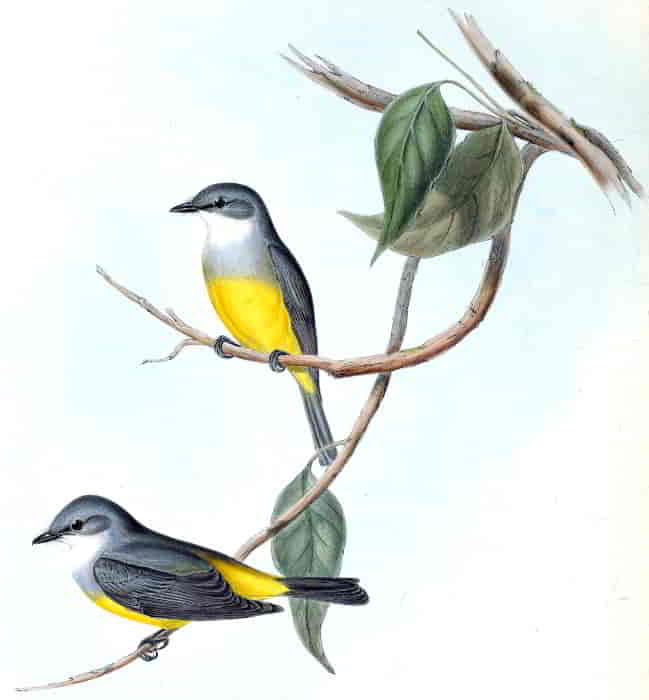
EÖPSALTRIA GRISEOGULARIS, Gould.
J. Gould and H. C. Richter del et lith. C. Hullmandel Imp.
EÖPSALTRIA GRISEOGULARIS, Gould.
Grey-breasted Robin.
Eöpsaltria griseogularis, Gould in Proc. of Zool. Soc., Part V. p. 144; and in Syn. Birds of Australia, Part IV.
Bȁm-boore, Aborigines of the lowland districts of Western Australia.
The fact of one species representing another, as they are frequently found to do, on opposite sides of large continents, is in no instance more clearly exemplified than in the two species of the genus Eöpsaltria inhabiting Australia, which, although closely allied in size, structure and colouring, as well as in habits and economy, inhabit very different countries, one being confined to the eastern, and the other to the western portion of the continent.
The Eöpsaltria griseogularis is abundant in every part of the colony of Swan River, inhabiting thickets and all spots clothed with vegetation of a brush-like character. “In its actions,” says Mr. Gilbert, “this bird is very like the Robins, being much on the ground, and when feeding constantly flying up and perching on a small upright twig. It does not appear to be capable of great or continued exertion on the wing, as it is rarely seen to do more than flit from bush to bush. Its most common note much resembles the very lengthened and plaintive song of the Estrelda bella, but differs from it in being a double note often repeated; it also utters a great variety of single notes, and during the breeding-season pours forth a short but agreeable song.
“The nest is very difficult to detect, the situations chosen for it being the thickly wooded gum-forests of the mountain districts and the mahogany forests of the lowlands; from the forks of the younger of these trees a great portion of the bark generally hangs down in strips; and in the fork the bird generally makes its nest of narrow strips of the bark bound together with cobwebs, while around the outside a quantity of dangling pieces are suspended, giving it the exact appearance of other forks of the tree; the inside of the nest has no other lining than a few pieces of bark laid across each other, or a single dried leaf, large enough to cover the bottom. It breeds in September and October, and lays two eggs, which are more lengthened in form than those of Eöpsaltria Australis, and are of a wood-brown obscurely freckled with yellowish red, ten lines long by seven lines and a half broad.
“Its stomach is muscular, and its food consists of insects of various kinds.”
The sexes are precisely similar in outward appearance.
It is stationary in Western Australia, but the extent of its range over the continent is not yet known.
Crown of the head, ear-coverts, sides and back of the neck, and back grey; throat and chest greyish white; abdomen, rump, upper and under tail-coverts rich yellow; wings and tail greyish brown, the extreme tips of the latter edged with white; bill dark horn-colour; irides very dark reddish brown; legs and feet dark olive-brown.
The figures are male and female, of the natural size.
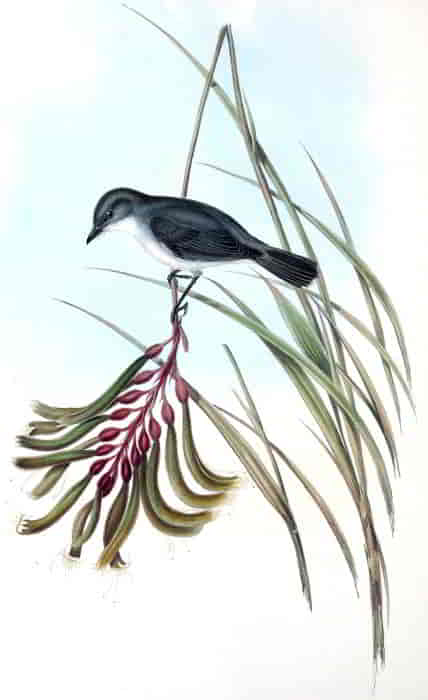
EÖPSALTRIA LEUCOGASTER: Gould.
J. Gould and H. C. Richter del et lith. Hullmandel & Walton Imp.
EÖPSALTRIA LEUCOGASTER, Gould.
White-bellied Robin.
Eöpsaltria leucogaster, Gould in Proc. of Zool. Soc., February 24, 1846.
The White-bellied Robin is a native of Western Australia, but is only to be met with in the hilly portions of the country. Mr. Gilbert states that the first specimen he procured was killed on the Darling range, near the gorge of the River Murray, at an elevation of about seven or eight hundred feet, and that he afterwards met with it on the southern extremity of the same range, between Vasse and Augusta, but that he never observed it on the lower grounds between the mountain range and the coast. Like the other species of the genus, it was constantly seen clinging to the bark of large upright trees, or straight and small stems, in search of its insect food. It is extremely quiet and secluded in its habits, is almost exclusively confined to the neighbourhood of small mountain streams, where scarcely any other sound is heard than the rippling and gurgling of the water over the rocks, and on the slightest approach it immediately secretes itself among the thick scrub or brushwood. Its song very closely resembles that of the Petroicæ.
Immediately before the eye a small triangular-shaped spot of black; above the eye a faint line of greyish white; crown of the head, all the upper surface, wings and tail dark slate-grey; the lateral tail-feathers largely tipped with white on their inner webs; all the under surface white; irides dark brown; bill and feet black.
The Plate represents the bird of the natural size, on one of the beautiful and rare plants of Western Australia, a species of Anigozanthus, the distinctive appellation of which I have not been able to ascertain.
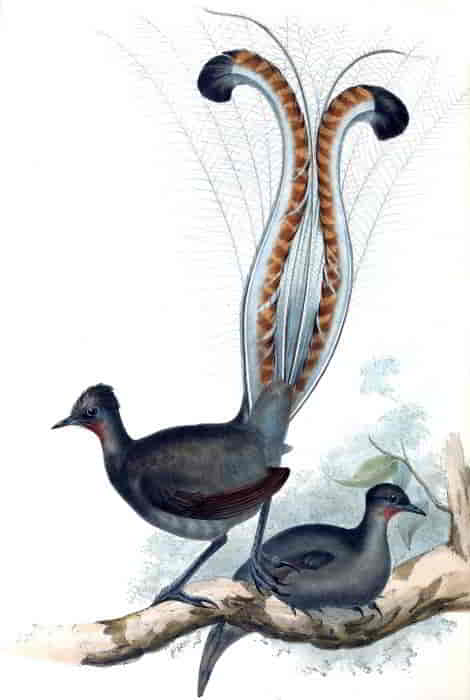
MENURA SUPERBA: Shaw.
J. & E. Gould delt. C. Hullmandel Imp.
MENURA SUPERBA, Davies.
Lyre-Bird.
Menura superba, Davies in Linn. Trans., vol. vii. p. 207. pi. 22.—Lath. Ind. Orn. Supp., p. lxi.—Collins, New South Wales, vol. ii. pl. in p. 93.—Shaw, Gen. Zool., vol. xiv. p. 313.
Le Parkinson, Vieill. (Ois. Dor.) Ois. de Parad., pls. 14, 15, 16.
Megapodius menura, Wagl. Sys. Av., sp. 1.
Menura Lyra, Shaw, Nat. Misc., pl. 577.—Vieill. Gal. des Ois., pl. 192.—G. R. Gray, List of Gen. of Birds, p. 71.
Menura Novæ-Hollandiæ, Lath. Ind. Orn. Supp., p. lxi.—Temm. Man., tom. 1. p. lvii.—Less. Traité d’Orn., p. 478. pl. 88.
Parkinsonius mirabilis, Bechst.
Menura vulgaris, Flem.
Menura paradisea, Swains. Class. of Birds, vol. ii. p. 351.
Superb Menura, Lath. Gen. Syn. Supp., vol. ii. p. 271.—Ib. Gen. Hist., vol. viii. p. 159. pl. cxxiv.
Pheasant of the Colonists.—Beleck, Beleck and Balangara of the Aborigines.
Were I requested to suggest an emblem for Australia among its birds, I should without the slightest hesitation select the Menura as the most appropriate, being not only strictly peculiar to Australia, but, as far as is yet known, to the colony of New South Wales.
Perhaps no bird has more divided the opinion of ornithologists, as to the situation it should occupy in the natural system, than the one here represented; and although more than fifty years have now elapsed since the bird was first discovered, little or no information has been hitherto published respecting its economy and habits, as ornithologists have had only its external structure to guide them in their opinions. Aware of this fact, I paid considerable attention to the subject while in Australia; and after a minute observation of the bird in a state of nature, I am decidedly of opinion, that it has not, as has been very generally considered, the most remote relationship to the Gallinaceæ; but that it forms, with the American genera Pteroptochos, Scytalopus, and their allied groups, a family of the Insessorial Order, to which Troglodytes, Amytis, Stipiturus, Malurus, Dasyornis and Psophodes closely assimilate in their habits, and of which they will in all probability be hereafter found to form a part. Notwithstanding the great size of Menura and the extraordinary form of its tail, in almost every other point it presents a striking resemblance to its minute congeners: like them, it possesses the bristles at the base of the bill, but to a less extent, the same unusual mass of loose, flowing, hair-like feathers on the back and rump, the same extraordinary power of running, the like feebleness of flight; all which will, I trust, render it evident that there are sufficient grounds for the opinion I have here expressed. Many intervening genera will, doubtless, yet be discovered to complete the series of affinities: at all events, if, as I am informed is the case, the young of Menura are helpless and blind when hatched, it cannot with propriety be placed with the Gallinaceæ.
In the structure of its feet, in its lengthened claws, and in its whole contour, the Lyre-bird presents the greatest similarity to the Pteroptochos megapodius of Kittlitz. Another singular circumstance by which their alliance is rendered still more evident, is the fact that Pteroptochos differs from the other families of the Insessorial Order in having fourteen feathers in its tail, and that Menura also differs in the same particular in possessing sixteen. The immense feet and claws of these two birds admirably adapt them for the peculiar localities they are destined to inhabit; and the same beautiful modification of structure is observable in the other genera, equally adapting them for the situations they are intended to fulfil. Thus Menura passes with ease over the loose stones and the sides of rocky gullies and ravines, while the Maluri trip over the more open and even ground, and the Dasyorni with equal facility thread the dense scrubs and reed-beds.
As I have before stated, the great stronghold of the Lyre-bird is the colony of New South Wales, and from what I could learn, its range does not extend so far to the eastward as Moreton Bay; neither have I been able to trace it to the westward of Port Philip on the southern coast; but further research can alone determine these points. It inhabits equally the brushes on the coast, and those that clothe the sides of the mountains in the interior; on the coast it is especially abundant at Western Port and Illawarra, and in all probability over a great portion of the unexplored intervening country: in the interior the cedar brushes of the Liverpool range, and according to Mr. George Bennett, the Mountains of the Tumat country are among the places of which it is a denizen. Of all the birds I have ever met with, the Menura is by far the most shy and difficult to procure. While among the brushes I have been surrounded by these birds, pouring forth their loud and liquid calls, for days together, without being able to get a sight of them; and it was only by the most determined perseverance and extreme caution that I was enabled to effect this desirable object, which was rendered the more difficult by their often frequenting the almost inaccessible and precipitous sides of gullies and ravines, covered with tangled masses of creepers and umbrageous trees: the cracking of a stick, the rolling down of a small stone, or any other noise, however slight, is sufficient to alarm it; and none but those who have traversed these rugged, hot and suffocating brushes, can fully understand the excessive labour attendant on the pursuit of the Menura. Independently of climbing over rocks and fallen trunks of trees, the sportsman has to creep and crawl beneath and among the branches with the utmost caution, taking care only to advance when the bird’s attention is occupied in singing, or in scratching up the leaves in search of food; to watch its actions it is necessary to remain perfectly motionless, not venturing to move even in the slightest degree, or it vanishes from sight as if by magic. Although I have said thus much on the cautiousness of the Menura, it is not always so alert: in some of the more accessible brushes through which roads have been cut it may frequently be seen, and even on horseback closely approached, the bird apparently evincing less fear of those animals than of man. At Illawarra it is sometimes successfully pursued by dogs trained to rush suddenly upon it, when it immediately leaps upon the branch of a tree, and its attention being attracted by the dog which stands barking below, it is easily approached and shot. Another successful mode of procuring specimens, is by wearing a tail of a full-plumaged male in the hat, keeping it constantly in motion, and concealing the person among the bushes, when the attention of the bird being arrested by the apparent intrusion of another of its own sex, it will be attracted within the range of the gun: if the bird be hidden from view by the surrounding objects, any unusual sound, as a shrill whistle, will generally induce him to show himself for an instant, by causing him to leap with a gay and sprightly air upon some neighbouring branch to ascertain the cause of the disturbance: advantage must be taken of this circumstance immediately, or the next moment it may be half-way down the gully. So totally different is the shooting of this bird to anything practised in Europe, that the most expert shot would have but little chance until well experienced in the peculiar nature of the country and the habits of the bird. The Menura seldom, if ever, attempts to escape by flight, but easily eludes pursuit by its extraordinary power of running. None are so efficient in obtaining specimens as the naked black, whose noiseless and gliding steps enable him to steal upon it unheard and unperceived, and with a gun in his hand he rarely allows it to escape, and in many instances he will even kill it with his own weapons.
The Lyre-bird is of a wandering disposition, and although it probably keeps to the same brush, it is constantly engaged in traversing it from one end to the other, from mountain-top to the bottom of the gullies, whose steep and rugged sides present no obstacle to its long legs and powerful muscular thighs; it is also capable of performing extraordinary leaps; and I have heard it stated that it will spring ten feet perpendicularly from the ground. It appears to be of solitary habits, as I have never seen more than a pair together, and these only in a single instance; they were both males, and were chasing each other round and round with extreme rapidity, apparently in play, pausing every now and then to utter their loud shrill calls: while thus employed they carried the tail horizontally, as they always do when running quickly through the bush, that being the only position in which this great organ could be conveniently borne at such times. Among its many curious habits, the only one at all approaching to those of the Gallinaceæ is that of forming small round hillocks, which are constantly visited during the day, and upon which the male is continually trampling, at the same time erecting and spreading out its tail in the most graceful manner and uttering his various cries, sometimes pouring forth his natural notes, at others mocking those of other birds, and even the howling of the native dog or Dingo. The early morning and the evening are the periods when it is most animated and active.
It may truly be said that all the beauty of this bird lies in the plumage of his tail, the new feathers of which appear in February or March, but do not attain their full beauty and perfection until June; during this and the four succeeding months it is in its finest state; after this the feathers are gradually shed, to be resumed again at the period above stated. I am led to believe that they are all assumed simultaneously, by the fact of a native having brought to my camp a specimen with a tail not more than six inches long, the feathers of which were in embryo, and all of the same length. Upon reference to my journal I find the following notes upon the subject:—“Mar. 14, Liverpool range. Several Menuras killed to-day: their tails not so fine as they will be.” “Oct. 25.—I find this bird is now losing its tail-feathers; and, judging from appearances, they will be all shed in a fortnight.”
Although upon one occasion I forced this bird to take wing, it was merely for the purpose of descending a gully, and I am led to believe that it seldom exerts this power unless under similar circumstances. It is particularly partial to traversing the trunks of fallen trees, and frequently attains a considerable altitude by leaping from branch to branch. Independently of its loud full call, which may be heard reverberating over the gullies to the distance of at least a quarter of a mile, it possesses an inward and varied song, the lower notes of which can only be heard when you have successfully approached to within a few yards of the bird during the time it is singing. This animated strain is frequently discontinued abruptly, and again commenced with a low, inward, snapping noise, ending with an imitation of the loud and full note of the Satin Bird, and always accompanied with a tremulous motion of the tail.
The food of the Menura appears to consist principally of insects, particularly centipedes and coleoptera; I also found the remains of shelled snails in the gizzard, which is very strong and muscular.
I regret that circumstances did not admit of my acquiring a perfect knowledge of the nidification of this very singular bird; I never found the nest but once, and this unfortunately was after the breeding-season was over; but all those of whom I made inquiries respecting it, agreed in assuring me that it is either placed on the ledge of a projecting rock, at the base of a tree, or on the top of a stump, but always near the ground; and a cedar cutter whom I met in the brushes informed me that he had once found a nest, which, to use his own expression, was “built like that of a magpie,” adding that it contained but one egg, and that upon his visiting the nest again some time afterwards he found in it a newly-hatched young, which was helpless and destitute of the power of vision. The natives state that the eggs are two in number, of a light colour, freckled with spots of red. The nest seen by myself, and to which my attention was drawn by my black companion Natty, was placed on the prominent point of a rock, in a situation quite secluded from observation behind, but affording the bird a commanding view and easy retreat in front; it was deep and shaped like a basin, and had the appearance of having been roofed; was of a large size, formed outwardly of sticks, and lined with the inner bark of trees and fibrous roots.
General plumage brown; the secondary wing-feathers nearest the body, and the outer webs of the remainder rich rufous brown; upper tail-coverts tinged with rufous; chin and front of the throat rufous, much richer during the breeding-season; all the under surface brownish ash-colour, becoming paler on the vent; upper surface of the tail blackish brown; under surface silvery grey, becoming very dark on the external web of the outer feather; the inner webs of these feathers fine rufous, crossed by numerous bands, which at first appear of a darker tint, but on close inspection prove to be perfectly transparent; the margin of the inner web and tips black; bill and nostrils black; irides blackish brown; bare space round the eye blackish lead-colour; legs and feet black, the scales mealy.
The female differs in wanting the singularly formed tail, and in having the bare space round the eye less extensive and less brilliantly coloured.
The Plate represents the two sexes, about half the natural size.

PSOPHODES CREPITANS: Vig. & Horsf.
J. & E. Gould delt. C. Hullmandel Imp.
PSOPHODES CREPITANS, Vig. & Horsf.
Coach-whip Bird.
Muscicapa crepitans, Lath. Ind. Orn. Supp., p. li.
Coach-whip Flycatcher, Lath. Gen. Syn. Supp., vol. ii. p. 222.
Coach-whip Honey-eater, Lath. Gen. Hist., vol. iv. p. 187.
Psophodes crepitans, Vig. & Horsf. in Linn. Trans., vol. xv. p. 329.
Djou, Aborigines of New South Wales.
This bird, so renowned for the singularity of its note, is very abundant in many parts of New South Wales, to which portion of the Australian continent it appears to be confined, as I have never met with it in collections from any other part of the country. It is to be found only in dense brushes, such as those at Maitland, Manning, Illawarra, and the cedar brushes of the Liverpool range; in fact, the localities that are suitable to the Menura and the Wattled Talegalla, are congenial to the habits of the Coach-whip Bird, which in some degree assimilate to those of the former; and the loud full note of this bird, ending sharply like the cracking of a whip, with which the woods are constantly reverberating, appeared to me, although very dissimilar, to be analogous to the peculiar call of the Menura; and I would further remark that a great resemblance is observable in the structure of the two birds.
The Coach-whip Bird is a shy and recluse species, for although its full notes indicate its presence, it rarely exposes itself to view, but generally keeps in the midst of the densest foliage and among the thickest climbing plants, frequenting alike those that have intertwined themselves with the branches of the tallest shrubs, and those that form almost impenetrable masses near the ground, and through which it threads its way with the utmost ease. In these arboreal habits it less resembles Menura than in other parts of its economy. It is extremely animated and sprightly in all its actions, raising its crest and spreading its tail in the most elegant manner, generally carrying this organ slightly raised, but never elevating it in the grotesque style of the Blue Wrens (Maluri). These actions become even more animated during the spring, when the males may often be seen chasing each other, frequently stopping to pour out their notes with great volubility, making the brushes ring for a considerable distance around them, and displaying themselves to the greatest advantage.
The food consists of insects of various kinds, obtained almost entirely from the ground, and sought for by scratching up the leaves and turning over the small stones, precisely after the manner of the Menura.
Independently of its peculiar whistle, which must be heard to be understood, as it is impossible to convey an idea of it by words, it possesses a low inward song of considerable melody.
The rounded form of the wings and graduated tail, as well as the softness of the feathers of the back, have induced some authors to consider it to be allied to the Bush Shrikes of America (Thamnophili); but the structure of its bill, which is so essentially different, being totally devoid of the notch on both the mandibles, must have been overlooked, and in no one of its habits or actions does it assimilate to those birds.
The sexes are much alike in colour, but may be readily distinguished by the more obscure plumage, and lesser size of the female. The young of the first year are of a much browner hue, a character of plumage that soon gives place to the adult livery. Of its nidification I regret to say I know nothing, although I paid great attention to the subject myself, and offered rewards for its nest and eggs, and for any information respecting them.
The male has the head, ear-coverts, chin and breast black; a large patch of white on each side of the neck, all the upper surface, wings, flanks, and base of the tail-feathers olive-green; the remaining portion of the tail-feathers black, the three lateral feathers on each side tipped with white; under surface olive-brown, some of the feathers on the centre of the abdomen tipped with white, and forming a conspicuous irregular patch; irides brownish red; bill, inside and out, and base of the tongue black; feet reddish brown.
The Plate represents the male and female of the natural size, on the branch of a plant growing abundantly in the brushes of the Hunter, with the scientific name of which I am not acquainted, but which is called the Cherry by the colonists.
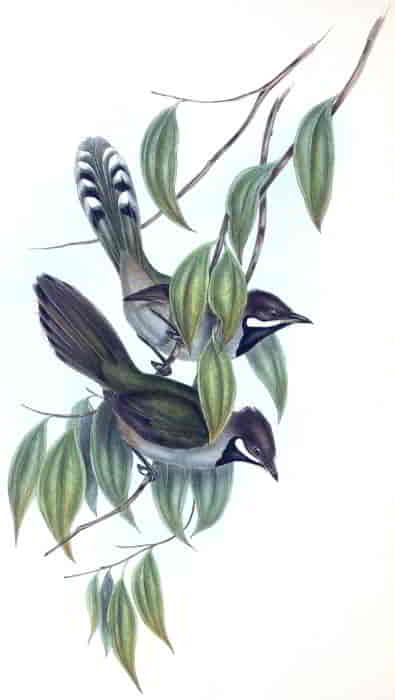
PSOPHODES NIGROGULARIS: Gould.
J. Gould and H. C. Richter del et lith. C. Hullmandel Imp.
PSOPHODES NIGROGULARIS, Gould.
Black-throated Psophodes.
Psophodes nigrogularis, Gould in Proc. of Zool. Soc., January 23, 1844.
The addition of a second species to the genus Psophodes will be hailed with pleasure by every one who makes the science of ornithology a matter of study; nor will its discovery be a subject of surprise to us, as it is only another illustration of that beautiful law of representation which is conspicuously carried out in Australia. The habitat of the present bird will doubtless be hereafter found to be as strictly confined to the western part of the continent as that of the P. crepitans is to the eastern. As yet only a single example has reached me, and in all probability no other specimen has ever fallen by the gun of any individual. It is to Mr. Gilbert’s perseverance that science is indebted for the knowledge of this new bird, and his notes which accompanied the specimen (a male) I here transcribe:—“Inhabits thickets of a small species of Leptospermum growing among the sand hills which run parallel with and adjacent to the beach. It utters a peculiar harsh and grating song which it is quite impossible to describe, and which is so different from that of every other bird I ever heard or am acquainted with, that I shall have no difficulty in recognizing it again wherever I may hear it. I heard it for the first time, together with the notes of many other birds equally strange to me, in the vicinity of the Wongan Hills a few weeks back, but could not then obtain a sight of the bird, although I knew from its singular and never to be mistaken note that it was only a few yards from me.”
Plumage of the upper surface olive; under surface ashy, passing into brown on the flanks and white on the centre of the abdomen; primaries brown; tail light olive-brown, the four lateral feathers crossed near the extremity with a hand of black, and tipped with white; throat deep black, with a stripe of white from the angle of the lower mandible, just within the black; bill dark horn-colour; irides dark brown; feet dark horn-colour.
The figures are of the natural size.
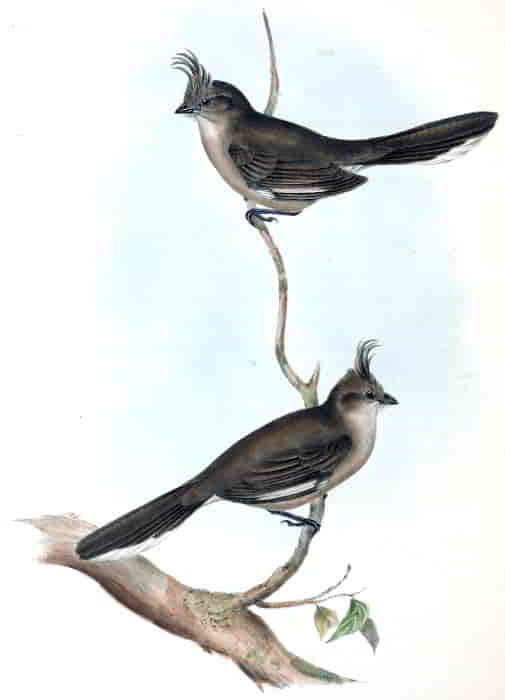
SPHENOSTOMA CRISTATUM: Gould.
J. & E. Gould delt. C. Hullmandel Imp.
SPHENOSTOMA CRISTATUM, Gould.
Crested Wedge-bill.
Sphenostoma cristatum, Gould in Proc. of Zool. Soc., Part V. p. 150.—Ib. Syn. Birds of Australia, Part IV.
Several years have now elapsed since I published the characters of this bird in the “Zoological Proceedings,” and a figure of the head in my “Synopsis.” I had little or nothing to communicate respecting its history at that time, and I regret to say that the interval has not added to my knowledge of the subject. The specimen from which my description and figure were originally taken was a female; and although the male differs but little in its outward appearance, still the rather more produced form of the bill supplies a key as to what tribe of birds it appears to be most nearly allied, that of Psophodes; at the same time it must be admitted, that the affinity is somewhat remote, and it may be that my conclusions are not well-founded: a knowledge of its habits will materially assist in clearing up this point.
It is an inhabitant of the low scrubby trees and Polygonum, bushes which stud the hot plains of the interior of Australia, particularly those on the borders of the Lachlan and Darling: Mr. Charles Coxen has also killed it on the Lower Namoi, but could tell me nothing of its habits. Whether it has any kind of loud sharp whistle analogous to that of the Coach-whip-bird (Psophodes crepitans), or if it has the same shy disposition, it would be interesting to ascertain; and to these points, as well as to all other details connected with its history, I would call the attention of those who may visit the interior, or may otherwise be favourably situated for observing them. The sombre tints of the bird are very like the colour of the earth of the plains it inhabits; and when the nature of its food shall have been ascertained, its wedge-shaped bill will doubtless be found admirably adapted for procuring it.
General plumage brown, lighter beneath; chin and centre of the abdomen greyish white; wings dark brown, edged with pale brown, the fourth and fifth primaries conspicuously margined with white; four centre tail-feathers dark brown, indistinctly barred with a still darker hue; the remainder brownish black, largely tipped with white; bill blackish brown; feet lead-colour.
The figures are of the natural size.
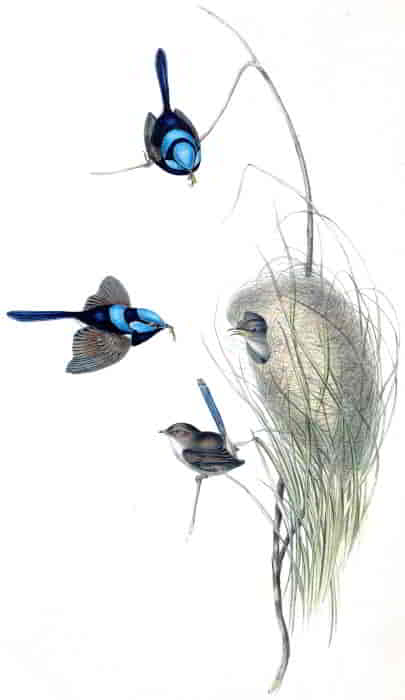
MALURUS CYANEUS: Vieill.
J. & E. Gould delt. C. Hullmandel Imp.
MALURUS CYANEUS, Vieill.
Blue Wren.
Sylvia cyanea, Lath. Ind. Orn., vol. ii. p. 545.
Motacilla cyanea, Gmel. Syst. Nat., vol. i. p. 991.
—— superba, Shaw, Nat. Misc., pl. 10.
Superb Warbler, Shaw in White’s Voy., pl. in p. 256, upp. fig.—Ib. Gen. Zool., vol. x. p. 754. pl. 58.—Lath. Gen. Hist., vol. vii. p. 117, but not the plate.
Malurus cyaneus, Vieill. Gal. des Ois., p. 265. pl. 163.—Vig. & Horsf. in Linn. Trans., vol. xv. p. 221.—Jard. and Selb. Ill. Orn., vol. ii. pl. 72. fig. 3.—Gould, Syn. Birds of Australia, Part I.
Superb Warbler, Blue Wren, etc., of the colonists.
Of the lovely group of birds forming the genus Malurus, the present species is the oldest known, being that figured in White’s Voyage to New South Wales, under the name of Superb Warbler, a term by which the bird is still familiarly known in Australia. It is abundantly dispersed over every portion of the colony of New South Wales, and I observed it to be equally numerous on the plains of the interior to the northward; but how far its range may extend in that direction, can only be determined when those parts of the continent shall have been fully explored. I also killed specimens in South Australia, which I then believed to be identical with the present bird; but on comparison since my return, I find them to be more nearly allied to the Malurus longicaudus, at the same time possessing characters different from either; a further knowledge of the South Australian bird is therefore necessary, before I can determine to which it is referable, or if it may not be distinct from both.
The kind of country to which the Malurus cyaneus gives preference is of a wild and sterile character, thinly covered with low scrubby brushwood, especially localities of this description situated near the borders of rivers and ravines. During the months of winter it associates in small troops, of from six to eight in number, probably the brood of a single pair; it is of a very wandering disposition, and although never migrating to any great distance, is continually traversing the district in which it was bred, retiring at night-fall to roost in the accustomed haunt. At this period of the year the plumage of the sexes is so nearly alike, that a minute examination is requisite to distinguish them, and hence has risen the supposition that there was but one male to several females. The old males, however, have at all seasons the bill black, whereas the young males during the first year, and the females, have this organ always brown; the tail-feathers also, which with the primaries are only moulted once a year, are of a deeper blue in the male than in the other sex. As spring advances they separate into pairs, the male undergoing a total transformation, not only in the colour, but also in the texture of its plumage; indeed, a more astonishing change can scarcely be imagined, its plain and unassuming garb being thrown off for a few months and another assumed, which for resplendent beauty is hardly surpassed by any of the feathered race, certainly by none but the Humming-birds and Cotingas of America: nor is the change confined to the plumage alone, but extends also to its habits; in fact, its whole character and nature appear to have received a new impulse; the little creature now displaying great vivacity, proudly showing off its gorgeous attire to the utmost advantage, and pouring out its animated song unceasingly, until the female has completed her task of incubation, and the craving appetites of its newly-hatched young call forth a new feeling, and give its energies a new direction. After satisfying myself that the gaily-adorned plumage of the male is only assumed during the summer season, I endeavoured to ascertain at what periods these changes take place, and I found that the adult males generally begin to assume their blue dress in March, and to throw it off again for their winter garb in August; but although the greater number undergo their periodical change simultaneously, still individuals may occasionally be met with in their brilliant plumage even in the depth of winter, owing to some peculiar circumstance having caused them to retain it later than usual, or having induced them to assume it at a much earlier period.
During the winter months no bird can be more tame and familiar, frequenting the gardens and shrubberies of the settler, and hopping about their houses as if desirous to court, rather than shun, the presence of man; but the male, when adorned with his summer plumage, becomes more shy and retiring, appearing to have an instinctive consciousness of the danger to which his beauty subjects him; nevertheless they will frequently build their little nest and rear their young in the most populous places. Several broods are reared annually in the Botanic Garden at Sydney, and I saw a pair busily employed in constructing their nest in a tree close to the door of the Colonial Secretary’s Office in that town. The short and rounded wing incapacitates it for protracted flight, but the amazing facility with which it is enabled to pass over the surface of the ground fully compensates for this deficiency: this mode of progression is scarcely to be called running, but is rather a succession of bounding hops, performed with great rapidity: while thus employed its tail is carried perpendicularly or thrown forward over the back; in fact, except during flight, this organ is rarely, if ever, carried horizontally.
The breeding-season continues from September to January, during which period at least two, if not three, broods are reared: the young of one being scarcely old enough to provide for themselves, before the female again commences laying: independently of rearing her own young, she is also the foster-parent of the Bronze Cuckoo (Chalcites lucidus), a single egg of which species is frequently found deposited in her nest; but by what means, is, as in the case of the European Cuckoo, unknown.
The nest, which is dome-shaped, with a small hole at the side for an entrance, is generally constructed of grasses, lined with feathers or hair: the site chosen for its erection is usually near the ground, in a secluded bush, tuft of grass, or under the shelter of a bank. The eggs are generally four in number, of a delicate flesh-white, sprinkled with spots and blotches of reddish brown, which are more abundant, and form an irregular zone at the larger extremity: they are eight lines long by five and a half broad.
The song is a hurried strain impossible to describe, but somewhat resembling that of the Wren of Europe, a bird to which the Maluri also assimilate in many of their actions.
The stomach is muscular, and the food consists of insects of various kinds, collected on the ground, the trunks of fallen trees, etc.
The male in summer has the crown of the head, ear-coverts and a lunar-shaped mark on the upper part of the back light metallic blue; lores, line over the eye, occiput, scapularies, back, rump and upper tail-coverts velvety black; throat and chest bluish black, bounded below by a band of velvety black; tail deep blue, indistinctly barred with a darker hue and finely tipped with white; wings brown; under surface buffy white, tinged with blue on the flanks; irides blackish brown; bill black; feet brown.
The female has the lores and a circle surrounding the eye reddish brown; upper surface, wings and tail brown; under surface brownish white; bill reddish brown; feet fleshy brown.
The Plate represents two males and a female with the nest, the former engaged in feeding a young Cuckoo.
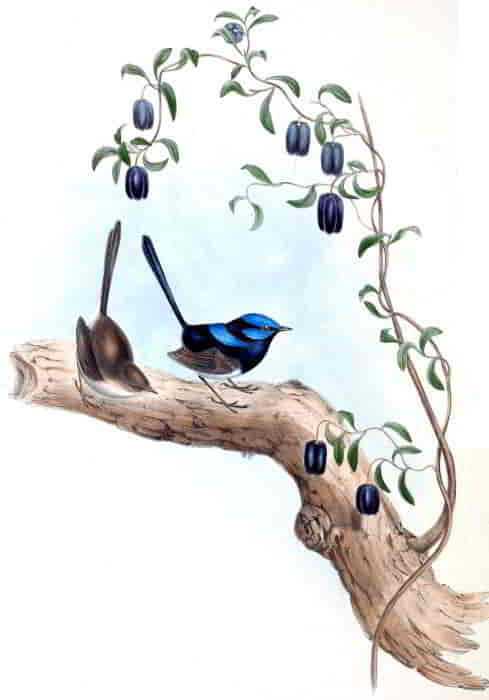
MALURUS LONGICAUDUS: Gould.
J. & E. Gould delt. C. Hullmandel Imp.
MALURUS LONGICAUDUS, Gould.
Long-tailed Wren.
Malurus longicaudus, Gould in Proc. of Zool. Soc., Part V. p. 148.
This species offers so general a resemblance to the Superb Warbler (M. cyaneus), that some ornithologists may still be inclined to consider it identical with that species; there are, however, differences in their characters which I find to be constant, and which are, I think, of sufficient importance to justify their being separated. The examination of great numbers of specimens enables me to affirm that the present species has the blue markings much more intense, is superior in size, and has a much longer tail. If the larger birds had been inhabitants of a warmer climate, where insect food is more abundant, it would have permitted the supposition that temperature had had some influence in effecting this difference; but as exactly the reverse is the case, I have been strengthened in my opinion of their being distinct, and have accordingly given it a name; that of longicaudus appearing to me the most appropriate, as at once distinguishing it from the Malurus cyaneus, in which that organ is much shorter. It is so universally dispersed over Van Diemen’s Land, as well as the islands in Bass’s Straits, that to particularize any one part of the former island where it is found more than another would be vain, since it is present in every gully, and every other place where low scrubby bushes and underwood are to be met with: I have also received a single specimen in its winter dress from Kangaroo Island, which I believe is referable to this species. Active and cheerful, and possessing a sweet warbling song, the present bird is as much a favourite in Van Diemen’s Land as the Superb Warbler is in New South Wales, and, like its congener, in the winter season it is equally tame and familiar. It is subject to the same changes of plumage, and its whole economy is so similar as to render a separate description unnecessary. Its nest is also similarly constructed, but is rather of a larger size; it is usually composed of grasses and leaves warmly lined with feathers, and in some instances with the fur of the Kangaroo and Opossum; and placed either in a small bush near the ground, or artfully built in a tuft of grass. The season of reproduction commences in August and lasts until January, during which time two or three broods are reared. Like the M. cyaneus, it is also the foster-parent of the Bronze Cuckoo (Chalcites lucidus). The eggs, which bear a similar character, but proportionately larger than those of the M. cyaneus, are four or five in number, of a flesh-white, blotched and spotted with markings of reddish brown, particularly at the larger end, where they form an irregular zone: they are nearly nine lines long by six and a quarter broad.
The long legs of this species admirably adapt it for the ground, and for traversing the fallen trunks of trees, along which, with tail erect, it passes with the utmost activity: it is also frequently to be observed among the low trees and bushes, the male often selecting a small prominent bare twig, whereon to perch and warble forth his animated song.
Its food consists of insects of various kinds, which are generally taken on the ground: the stomach is muscular, and was frequently found to contain grains of small sand intermingled with its natural food.
The male in summer has the crown of the head, ear-coverts and a broad lunar-shaped mark on the upper part of the back metallic blue; lores, line over the eye, occiput, scapularies, back, rump, and upper tail-coverts velvety black; throat and chest bluish black, bounded below by a band of velvety black; tail dark blue, indistinctly barred with a darker hue and finely tipped with white; wings brown; under surface buffy white, tinged with blue on the flanks; irides blackish brown; bill black; feet brown.
The female has the lores and a circle surrounding the eye reddish brown; upper surface, wings and tail brown; under surface brownish white; bill reddish brown; feet fleshy brown.
The figures are of the natural size.
The beautiful Creeper introduced into the Plate is the Billardiera longiflora.
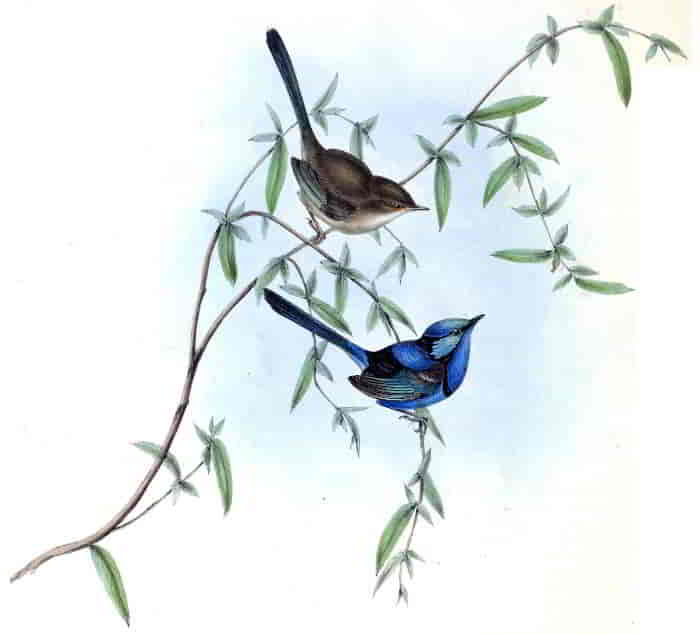
MALURUS MELANOTUS: Gould.
J. & E. Gould delt. C. Hullmandel Imp.
MALURUS MELANOTUS, Gould.
Black-backed Wren.
Malurus melanotus, Gould in Proceedings of Zool. Soc., November 10, 1840.
The only place in which I observed this extremely rare species was the Belts of the Murray in South Australia; but although it was there tolerably abundant, it was so extremely shy and distrustful, that the few specimens in my collection, and which in all probability are the only examples in Europe, were obtained with the greatest difficulty. It was most frequently observed on the ground, particularly in the small open glades and little plains by which the outer belt of this vast scrub is diversified. The period of my visit was in winter, consequently the specimens I collected were all out of colour, or more properly speaking, divested of the rich blue and black plumage of summer, in which state a single specimen has been forwarded to me by one of the party that accompanied His Excellency Colonel Gawler and Captain Sturt, when those gentlemen visited the Murray in 1839. It is a most interesting species, inasmuch as it possesses characters intermediate between the M. cyaneus and M. splendens, having the blue belly and conspicuous pectoral band of the latter and the black back of the former; from both, however, it differs in the length of its toes, which are much shorter than those of its near allies: this difference in structure exerts a corresponding influence upon its habits and actions; for while the others run over the ground with great facility, the Black-backed Wren far exceeds them in this power; hence arose the great difficulty of procuring specimens. Instead of exerting any power of flight, they effected their escape by the extraordinary manner with which they tripped over the small openings and through the scrub, each troop appearing to have a leader, and keeping just beyond the range of the gun: this shyness was rather remarkable, since I and my party were probably the only white persons they had ever encountered; like the Chestnut-backed Ground Thrush, they would appear to have an instinctive dread of man.
The male in summer has the crown of the head, chin, throat, abdomen, upper part of the back, upper and under tail-coverts beautiful metallic blue; ear-coverts verditer-blue; lores, back of the neck, band across the breast and lower part of the back velvety black; external margins of all the wing-feathers green; tail bluish green, indistinctly barred with a darker tint, and slightly tipped with white; bill black; irides and legs blackish brown.
The female has the lores and circle surrounding the eye reddish brown; all the upper surface brown; under surface brownish white; wings brown; tail green, each feather slightly tipped with white; bill reddish brown; feet brown.
The male in winter has the bill black, like the M. cyaneus.
The figure is that of a male and female of the natural size.
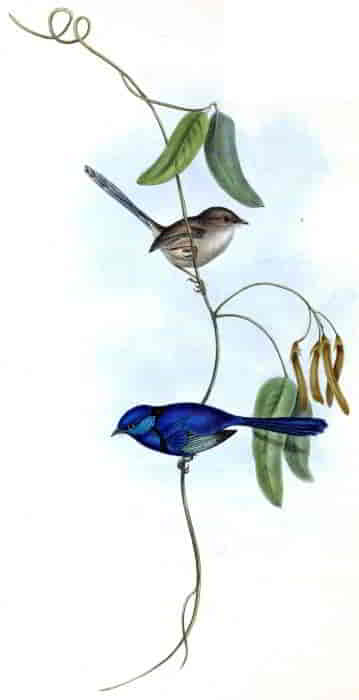
MALURUS SPLENDENS.
J. & E. Gould delt. C. Hullmandel Imp.
MALURUS SPLENDENS.
Banded Wren.
Saxicola splendens, Quoy et Gaim., Voy. de l’Astrol., Zool., tom. i. p. 197. pl. 10. fig. 1.
Malurus pectoralis, Gould in Proc. of Zool. Soc., Part I. p. 106.
Djur-jeel-ya of the Aborigines of the lowland, and Jeer-jal of the Aborigines of the mountain districts of Western Australia.
This species may very justly be considered as more gorgeous and resplendent than any other of its race, its whole plumage sparkling with beautiful shining metallic lustres, beyond the power of our pencil to imitate in a drawing. At the time I gave a description of this little beauty in 1837, I was totally unaware that it had been previously published in France, and I am gratified that an opportunity is now afforded me to correct my error, and to figure it under the very appropriate specific title conferred upon it by Messrs. Quoy and Gaimard.
The Malurus splendens is an inhabitant of the western coast of Australia; but over what extent of country it may range cannot be ascertained, until the further progress of geographical research in this portion of Australia enables us to solve the problem. It is, I believe, very generally distributed over the Swan River settlement, where I am informed it inhabits scrubby places and underwood, sallying forth over the more dry and open forest during the day, and choosing, as Mr. Gilbert thinks, swampy places to roost in; at least he observed it returning to such situations in great numbers in the evening just before dark; and he moreover states, that not more than two males, or rather birds in colour, were observed to five females, or birds in the brown plumage; for, like the other members of the genus, the gorgeous colouring is only seasonal.
Its song very nearly resembles that of the Van Diemen’s Land species, M. longicaudus. It breeds in September and the three following months: the nest is constructed of dried, soft grasses, and lined either with hair, wool or feathers, is of a dome-shape, the cover of the top resembling the peak of a cap, and is about six or eight inches in height: the eggs are generally four in number, of flesh-white, thickly blotched and freckled with reddish brown, especially at the larger end; eight and a quarter lines long by six and a quarter lines broad. The situation of the nest is much varied, being sometimes built among the hanging clusters of the stinkwood tree, at others among the upright reeds growing just above the water’s edge on the borders of lakes and the banks of rivers.
The stomach is muscular, and its food consists of insects of various kinds.
The male in its summer dress has the crown of the head, back, scapularies, and upper tail-coverts deep metallic blue; ear-coverts verditer-blue; throat and all the under surface deep shining violet-blue; lores, crescent-shaped mark across the chest and back of the neck deep velvet-black; external edges of the wing-feathers green; tail greenish blue, indistinctly barred with a darker tint; bill black; eyes and feet blackish brown.
The female has the bill, lores and circle round the eyes reddish brown; crown of the head and all the upper surface brown; the external margins of the wing-feathers slightly tinged with green; tail as in the male, but paler, and slightly tipped with white.
The Plate represents a male and female of the natural size.
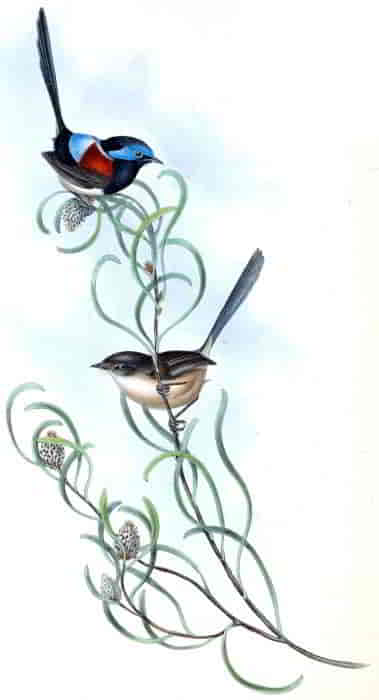
MALURUS ELEGANS: Gould.
J. & E. Gould delt. C. Hullmandel Imp.
MALURUS ELEGANS, Gould.
Graceful Wren.
Malurus elegans, Gould, Birds of Australia, Part I. Aug. 1837.
Djur-jeel-ya, Aborigines of the lowland districts of Western Australia.
This is not only the largest species of the genus yet discovered, but may be considered as one of the most beautiful and elegant of its race: the delicate verditer-blue of the centre of the back, and the larger size and more spatulate form of its tail-feathers, at once distinguish it from Malurus Lamberti, the species to which it is most nearly allied. It is an inhabitant of the western coast of Australia; all the specimens I possess were collected at Swan River, where it is tolerably abundant. Mr. Gilbert states, that although in its economy it very closely resembles M. splendens, it nevertheless differs from that species in the nature of the localities it frequents, which are usually swampy situations, while M. splendens is more generally spread over all parts of the country. It is also said to differ slightly in its song, in commencing with one distinct note and then singing precisely like the former.
The nest, which is neither characterized by neatness nor compactness, is dome-shaped, with a hole in the side for an entrance, and is generally formed of the thin paper-like bark of the Tea-tree (Melaleuca), and lined with feathers: it is also usually suspended to the foliage of this tree, and occasionally to that of other shrubs which grow in its favourite localities. The eggs are four in number, of a delicate flesh-white freckled with spots of reddish brown, which are much thicker at the larger end; they are about eight lines long and six lines broad. The breeding-season commences in September and continues during the three following months.
The food consists of insects.
The males are subject to the same law relative to the seasonal change of plumage as the Malurus cyaneus, and the other members of the group.
The male has the forehead, ear-coverts, sides of the face and occiput rich verditer-blue; centre of the back light verditer-blue; scapularies chestnut; throat, chest, back of the neck and rump deep velvety black, the throat in certain lights tinged with blue; wings brown; abdomen and under tail-coverts huffy white; tail dull bluish green, crossed by numerous indistinct bars, seen only in some positions, and very slightly tipped with white; bill black; eyes and feet blackish brown.
The female has all the upper surface and wings brown; throat and under surface buff-white; tail as in the male, but more dull, and devoid of the white at the extremity of the feathers; bill dull reddish brown, lighter beneath; space between the bill and eyes reddish brown; legs brown.
The figures are of the natural size, on the Isopogon alternatus.
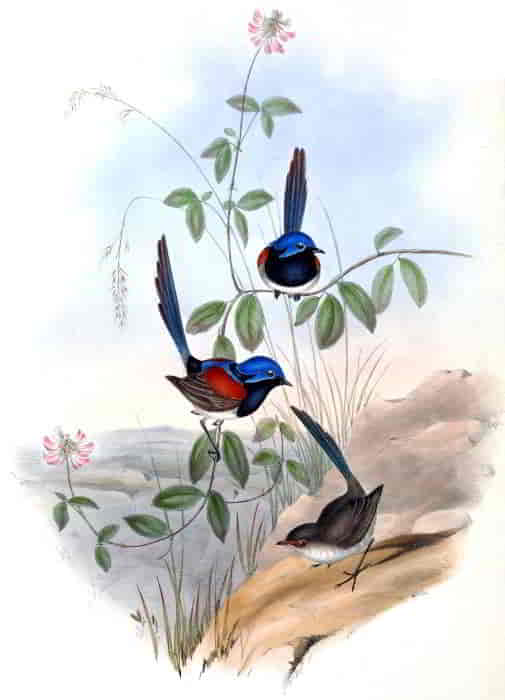
MALURUS PULCHERRIMUS: Gould.
J. Gould and H. C. Richter del et lith. Hullmandel & Walton Imp.
MALURUS PULCHERRIMUS, Gould.
Beautiful Wren.
Malurus pulcherrimus, Gould in Proc. of Zool. Soc., Part XII. p. 106.
A more beautiful bird than the present species, which must be regarded as the representative in Western Australia of the Malurus Lamberti, can scarcely be imagined. It is moreover an evidence that this hitherto unexplored portion of the country is not less rich in interesting productions than are those parts which have been much longer known to us.
The Malurus pulcherrimus is very nearly allied to the M. Lamberti, but is of a larger size, and also differs from that species in having the throat and breast of a rich deep blue instead of black.
For a knowledge of this species I am indebted to the researches of Mr. Gilbert, who informs me that “it appears to be exclusively confined to the thickets of the interior of Western Australia; in habits and manners it greatly resembles the other members of the genus, but its nest is somewhat smaller than that of either of them. A nest found on the 28th of October, in the vicinity of the Wongan Hills, was placed on the upper branches of a species of Hakea about four feet from the ground; it contained two newly-laid eggs, which resembled those of the other species of the genus, but had the blotches very much larger.”
Crown of the head and a broad band across the centre of the back rich glossy violet-blue; space surrounding the eye and the ear-coverts verditer-blue; throat intense indigo-blue, bounded below by an indistinct band of black; lores, collar surrounding the back of the neck, and the lower part of the back, deep velvety black; scapularies chestnut; wings brown; tail dull greenish blue, indistinctly barred with a darker tint and slightly tipped with white; abdomen and under tail-coverts white; bill and feet black; irides dark brown.
The figures represent two males and a female of the natural size.
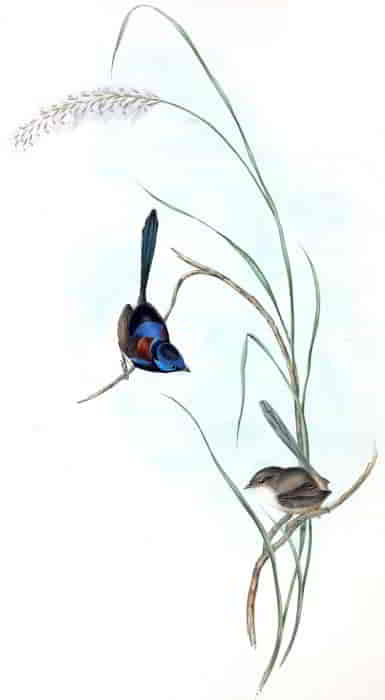
MALURUS LAMBERTI: Vig. & Horsf.
J. & E. Gould delt. C. Hullmandel Imp.
MALURUS LAMBERTI, Vig. & Horsf.
Lambert’s Wren.
Malurus Lamberti, Vig. & Horsf. in Linn. Trans., vol. xv. p. 221.—Jard. and Selb., Ill. Orn., vol. ii. pl. 72. fig. 2.—Gould, Syn. Birds of Australia, Part I.
Superb Warbler, White’s Journ., pl. in p. 256, low. fig.—Phillips, Voy., pl. in p. 157, male.
Variegated Warbler, Lewin, Birds of New Holl., pl. xv.
Although far less common and much more local than M. cyaneus, this species ranges over a greater extent of country, being an inhabitant of most parts of New South Wales, the interior in the neighbourhood of the Namoi and the north-west coast, whence I received several specimens, forming part of an interesting collection kindly sent me by Mr. Dring. I found it tolerably abundant on the Namoi, where it was sometimes associated with its congener M. cyaneus.
In New South Wales the neighbourhood of Botany Bay is one of its most favourite resorts, and it is occasionally seen near Sydney, and even in the small gardens within the town. A beautiful specimen in the Museum of this place was killed on the lawn in front of that establishment, which is situated within the precincts of the town, and surrounded on all sides by houses. It does not inhabit Van Diemen’s Land, nor did I observe it in South Australia, or hear of its ever having been seen there, neither have I received it from the colony of Swan River.
Lambert’s Superb Warbler is a species with which we have been long acquainted, being figured in the early voyages to New South Wales as a variety of Malurus cyaneus; but the only species with which it at all assimilates in the disposition and colour of its markings is the M. elegans of Western Australia, of which it forms a beautiful analogue on the eastern coast.
This is one of the few common birds of Australia of which I was not able to find the nest; but its changes of plumage, nidification, the number and colour of its eggs, are doubtless very similar to those of the other members of its family. Its food consists of insects of various kinds, which are sought for on the ground, over which it runs with great facility.
The male has the forehead, ear-coverts, sides of the head and occiput and centre of the back beautiful violet-blue; throat, breast, crescent across the upper part of the back and rump black; scapularies chestnut; wings brown; abdomen white, tinged with brown on the flanks; tail dull greenish blue, indistinctly barred with a darker tint, and lightly tipped with white; bill black; eyes and feet dark brown.
The female has the body dull brown; the throat and under surface much paler; tail-feathers as in the male, but less bright; bill and space round the eye reddish brown; feet brown.
The Plate represents a male and female of the natural size.
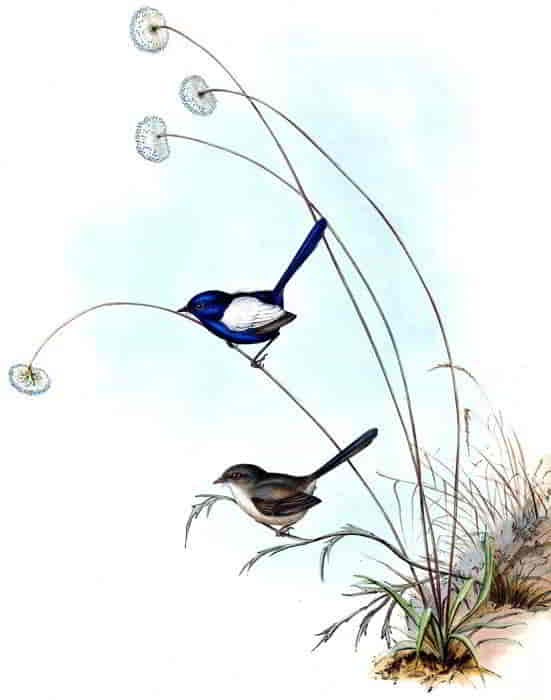
MALURUS LEUCOPTERUS: Quoy & Gaim.
J. & E. Gould delt. C. Hullmandel Imp.
MALURUS LEUCOPTERUS, Quoy & Gaim.?
White-winged Wren.
Malurus leucopterus, Quoy et Gaim. Zool. de l’Uranie, p. 108. pl. 23. fig. 2.?—Vig. & Horsf. in Linn. Trans., vol. xv. p. 222.
Amytis leucopterus, Less. Traité d’Orn., p. 454.
I regret that I have not been able to clear up the doubt which exists in my mind, whether the present beautiful bird is or is not distinct from the one figured by Messrs. Quoy and Gaimard in the “Voyage de l’Uranie,” since on applying at the Museum of the Jardin des Plantes, for the purpose of examining the original specimen, it could not be found: the figure above-quoted, if intended for the present bird, is by no means correct, and it is, moreover, said to be from Dirk Hatich’s Island, on the western coast, a locality very distant from those in which I found the bird here represented; a circumstance which strengthens my belief that they may be distinct: besides which, the bird I have figured is supposed to be exclusively an inhabitant of the interior; I never even observed it between the mountain ranges and the coast; it is therefore scarcely probable that it should inhabit an island like that of Dirk Hatich.
It was tolerably abundant in the patches of low scrub and grassy beds, here and there scattered over the plains which stretch out to the northward of the Liverpool range, and it was equally plentiful on the Lower Namoi: that it extends as far as South Australia, is proved by my having received its nest and eggs from that part of the continent.
It was usually seen either in pairs or in small troops, and evinced so much shyness of disposition as to render the acquisition of specimens a task of no little difficulty, particularly of the full-plumaged male, who appeared to be conscious that the display of his gorgeously-coloured dress might lead to his detection. Its powers of flight are not great, but this is fully compensated for by the extraordinary manner in which it threads the bushes, and passes over the surface of the ground in a series of hopping bounds, whereby it readily eludes pursuit. The most successful mode of obtaining it is to ascertain the precise spot in which it is located, to approach it cautiously, and to remain silent for a short time, when the male will soon show himself by hopping out from the bush; the restless nature of his disposition not admitting of his remaining long concealed.
The beautifully contrasted colours of blue and white, represented in our Plate, is a merely seasonal dress assumed in spring, and continued throughout the breeding-season, which commences in August and terminates in January; before and after this season male birds may be seen in every stage of colouring, from plain uniform brown to that of the perfect livery.
The nest is composed of grasses, rather large and dome-shaped, with a hole near the top for an entrance. The one sent me from South Australia contained two eggs, one of which was the Bronze Cuckoo’s, thus showing that this little bird is also the foster-parent of those birds. The number of eggs laid by the Malurus leucopterus is in all probability four; the one I possess is flesh-white, finely freckled with reddish brown, forming a zone at the larger end, and is eight lines long by six lines broad.
The male has the whole of the head, body above and beneath, and the tail beautiful deep blue; scapularies, wing-coverts and tertiaries snow-white; primaries brown, with their external edges silvery green; bill black; feet brown; eyes dark brown.
The female has the crown of the head, and all the upper surface and flanks brown; throat and abdomen white, faintly washed with brown; external edges of the primaries and tail pale greenish blue; bill reddish brown.
The Plate represents the male and female of the natural size; the Plant is the Brunonia Australis.
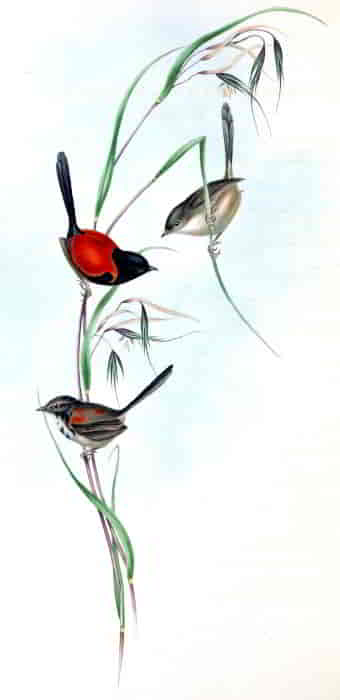
MALURUS MELANOCEPHALUS: Vig. & Horsf.
J. & E. Gould delt. C. Hullmandel Imp.
MALURUS MELANOCEPHALUS, Vig. & Horsf.
Black-headed Wren.
Scarlet-lacked Warbler, Lewin, Birds of New Holl., pl. xiv.
Malurus melanocephalus, Vig. & Horsf. in Linn. Trans., vol. xv. p. 222.
Malurus Brownii, Jard. and Selb. Ill. Orn., vol. ii. pl. 72. fig. 1.
In their “Illustrations of Ornithology,” Sir William Jardine and Mr. Selby have in a very laudable manner endeavoured to clear up what they considered some confusion respecting the present and the preceding species, M. Brownii. These gentlemen have, however, fallen into error in considering the two birds as identical, whereas they are, in fact, totally distinct.
I have never seen the Black-headed Wren from any other locality than New South Wales, and I am consequently led to believe that the south-eastern portion of Australia is its peculiar and limited habitat. It is a local species, not being generally diffused over the face of the country, like several other members of the group, but confined to grassy ravines and gullies, particularly those that lead down from the mountain ranges. I obtained several pairs of adult birds in very fine plumage in the valleys under the Liverpool range, all of which I discovered among the high grasses which there abound; but as the period of my visit was that of their breeding-season, I never observed more than a pair together, each pair being always stationed at some distance from the other, and in such parts of the gullies as were studded with small clumps of scrubby trees.
The Black-headed Wren has many actions in common with the M. cyaneus, and like that species carries its tail erect: it also frequently perches on a stem of the most prominent grasses, where it displays its richly-coloured back, and pours forth its simple song. I did not succeed in finding the nest, although I knew they were breeding around me: it was probably placed among the grasses, but was so artfully concealed that it completely baffled my efforts at finding it.
One might suppose the greater development of feather on the back of this species to have been given it as a defence against the damp and dense grasses of the ravines, among which it usually resides; but from the circumstance of the female not possessing this character of plumage, and the rich garb being only seasonal in the male, this supposition falls to the ground. In their winter dress the sexes very nearly resemble each other; but the males may always be distinguished by the black colouring of the bill and tail-feathers. The young male of the year has the tail-feathers brown, like the females, and it is a curious fact, that at this age these feathers are much longer than in the adult.
The flight of this species is feeble and not protracted; but, on the contrary, its powers of running and creeping are very considerable.
The breeding-season probably commences in September and continues until January; its food is insects of various kinds.
The male has the head, all the under surface, wing-coverts, upper tail-coverts and tail deep velvety black; back of the neck, scapularies and remainder of the upper surface rich orange-scarlet; bill black; eyes blackish brown; feet fleshy brown.
Female brown above, paler beneath; bill brown; base of the under mandible reddish brown; feet flesh-brown.
The Plate represents male and female in the summer plumage, and a young male in change, on one of the native grasses of New South Wales.
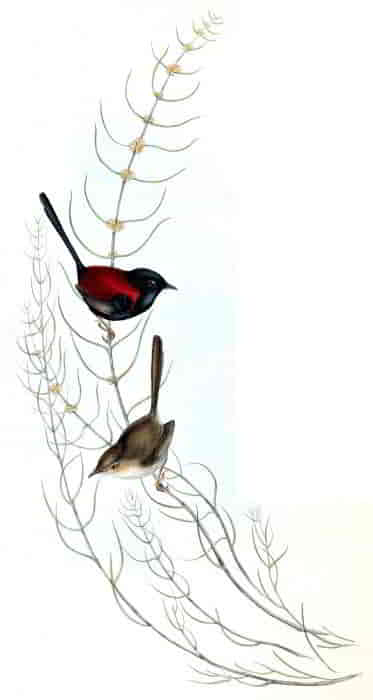
MALURUS BROWNII: Vig. & Horsf.
J. & E. Gould delt. C. Hullmandel Imp.
MALURUS BROWNII, Vig. & Horsf.
Brown’s Wren.
Malurus Brownii, Vig. & Horsf. in Linn. Trans., vol. xv. p. 223.
Malurus cruentatus, Gould in Proc. of Zool. Soc., Part VII. p. 143.
Among the species of which I sent home characters from New South Wales, for publication in the Proceedings of the Zoological Society, was the present pretty bird, to which I gave the specific name of cruentatus; upon comparison, however, of my specimens with the Malurus Brownii in the Linnean Society’s Collection, I find they are identical, consequently my name must sink into a synonym. Mr. Brown, who was the donor of the Linnean Society’s specimen, obtained his bird near Broad Sound, on the eastern coast; while those from which my description was taken were procured on the north-west, and formed part of the collection placed at my disposal by the officers of the Beagle. It differs from Malurus melanocephalus in the more intense and deep blood-red of the back, and, as Messrs. Vigors and Horsfield justly observe, it is much less in size.
Of its habits and economy, or the situations to which it gives preference, no information has yet been obtained; but we may reasonably suppose, that two species so nearly resembling each other in structure and colour as M. Brownii and M. melanocephalus do not greatly differ in their habits.
I have lately received an account of its being common at Port Essington; and, as I have above stated, it is an inhabitant of the eastern and north-western coasts; we may consequently conclude that its range extends over the whole of the northern parts of the Australian continent.
The male in summer has the head, neck, wings, all the under surface and tail black; primaries and secondaries brown; back and shoulders fine crimson; bill black; legs fleshy brown.
The female is uniform light brown, the abdomen inclining to white; bill and feet light brown.
The Plate represents a male and female, on the Bæckia linifolia.
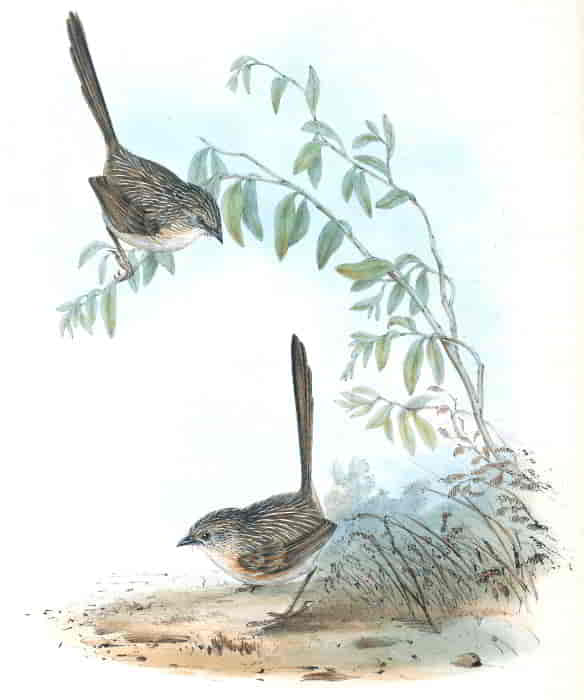
AMYTIS TEXTILIS: Lefs:
J. & E. Gould delt. C. Hullmandel Imp.
AMYTIS TEXTILIS.
Textile Wren.
Malurus textilis, Quoy et Gaim. Zool de l’Uranie, p. 107. pl. 23. fig. 1.
The birds figured in this and the following Plate differ from each other considerably in plumage, as well as in the structure of the bill, that organ in the present bird being shorter and more robust than in Amytis striatus.
Of the Textile Wren I killed and dissected many examples, but of the following I only procured a single specimen, and never met with it but in this one instance. I have considered it necessary to state this, as it would have been more satisfactory to me to have had further proofs from actual dissection and comparison, of their being really distinct, although I have little doubt that such is the case. The bird figured in the “Voyage de l’Uranie,” is doubtless referable to the one represented on the opposite Plate, while that figured by M. Lesson in the Atlas to his “Traité d’Ornithologie,” and which seems to have been the subject from which he took his generic characters and description, as clearly belongs to A. striatus.
The only place in which I observed the Textile Wren was the plains bordering the Lower Namoi; and that its range extends far to the northward and westward is certain, from the fact of the specimen figured in the “Voyage” above-quoted having been procured on the north-west coast.
In the various positions it assumes, in the elevated carriage of its tail, and in its whole economy, it bears a close resemblance to the true Maluri: like them also it wanders about in small troops of four or six in number, always keeping within a short distance, and returning towards the close of the day to its accustomed haunts. On the Lower Namoi, where it is very abundant, it is found in all those parts of the plains that are studded with scrubs and clumps of a low shrub-like tree, resembling the Barilla of the coast, through and among which it creeps with astonishing rapidity; indeed, its mode of progression on the ground is such as no description can convey an accurate conception of, and must be seen to be understood: I cannot perhaps compare it with anything, unless with the motion of an India-rubber ball when thrown forcibly along the ground. While stealing from bush to bush, with this rapid movement, its head low and tail perfectly erect, it presents an exceedingly droll appearance. Like many others of its family, it seldom employs the power of flight.
Its food is insects of various kinds.
Of its nidification I have nothing to communicate: it doubtless builds a dome-shaped nest, and in all probability lays four spotted eggs; but to these points I would call the attention of those who are favourably situated for observing them, as also to confirm or refute the opinion of this and the following bird being distinct.
All the upper surface dark brown, each feather with a narrow stripe of white down the centre; under surface the same, but much paler; flanks and under surface of the shoulder rust-red; tail dark brown, indistinctly barred with a still darker hue and edged with pale brown; irides reddish hazel; base of lower mandible bluish horn-colour; remainder of the bill black; feet flesh-brown.
The male I dissected was destitute of the rusty red colouring on the flanks and under surface of the shoulder.
The Plate represents a male and female of the natural size.
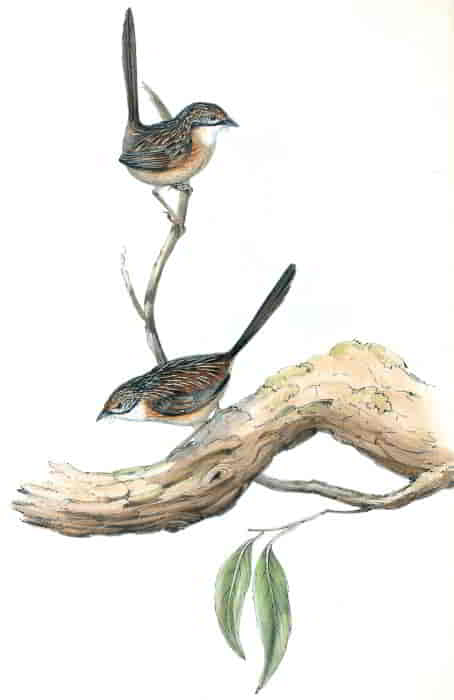
AMYTIS STRIATUS: Gould.
J. & E. Gould delt. C. Hullmandel Imp.
AMYTIS STRIATUS.
Striated Wren.
Amytis textilis, Less. Traité d’Orn., p. 454. pl. 67. fig. 2.
Dasyornis striatus, Gould in Proc. of Zool. Soc., Part VII. p. 143.
The only specimen I procured of this little bird in a recent state, was shot while I was traversing the Lower Namoi; it appeared to give preference to a loose sandy soil studded with high rank grass, which, growing in tufts, left the interspaces quite bare: through the natural labyrinth thus formed the Striated Wren ran with amazing rapidity, and it was only by forcing it to take wing that I succeeded in killing the one I obtained, which on dissection proved to be a male, and which served for the upper figure in my Plate: the other figure is supposed to represent the female; but as this can only be ascertained by the internal examination of a recent specimen, and no opportunity for so doing has yet occurred, this point must, for the present, remain undecided. All the specimens I have seen from New South Wales were in the red state of plumage, which goes far towards proving that this bird is really distinct from Amytis textilis.
Nothing has yet been ascertained respecting its nidification: its food, like that of the Textile Wren, consists of insects of various kinds.
Upper surface fine rusty red, each feather with a line of buffy white bounded on each side by black down the centre; line beneath the eye black; ear-coverts black, striated with white; wings and tail brown, margined with light reddish brown; base of the primaries rust-red, forming a conspicuous patch; chin and throat white; feathers of the chest buffy white, with two lines of brown, one down each side the stem; under surface rust-red, some of the feathers with a stripe of white down the centre; tail dark brown, indistinctly barred with a still darker tint, margined with lighter brown; irides hazel; bill dark horn-colour; feet brownish lead-colour.
The Plate represents a male and female of the natural size.
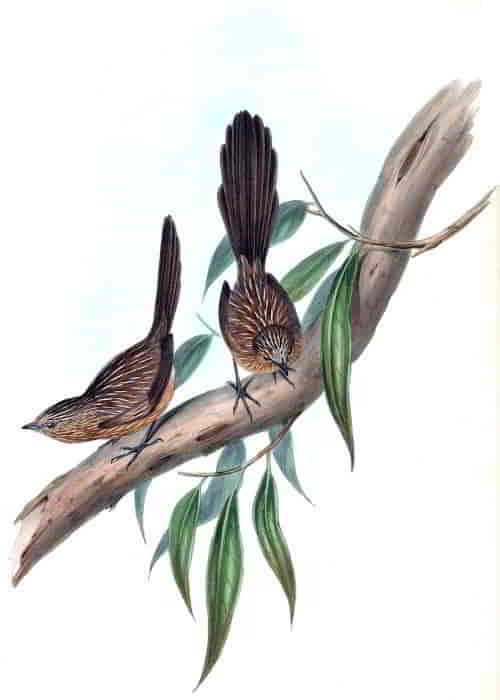
AMYTIS MACROURUS: Gould.
J. Gould and H. C. Richter del et lith. Hullmandel & Walton Imp.
AMYTIS MACROURUS, Gould.
Large-tailed Wren.
Amytis macrourus, Gould in Proc. of Zool. Soc., Jan. 27, 1847.
Nyern-de and Jee-ra, Aborigines of the interior of Western Australia.
The present is the first species of the genus that has been discovered in Western Australia; the two examples in my own collection are all that I have yet seen; these were shot in the interior by Mr. Gilbert, who states that “it inhabits the thickets, and is almost always on the ground in families of from four to seven in number: it carries its tail more erect than any other bird I have seen, and certainly no bird runs or rather hops over the surface of the ground with greater rapidity.”
It is evidently the representative of the Amytis textilis of the eastern coast, to which it is very nearly allied, but from which, as well as from the A. striatus, it may at once be distinguished by its more robust form, and by the much greater length and size of its tail.
All the upper surface brown, each feather with a narrow stripe of white down the centre; under surface the same, but much paler; under surface of the shoulder pale rusty red; tail brown, margined with pale brown; irides hazel; base of the lower mandible horn-colour, remainder of the bill black; feet flesh-brown.
The figures are of the natural size.
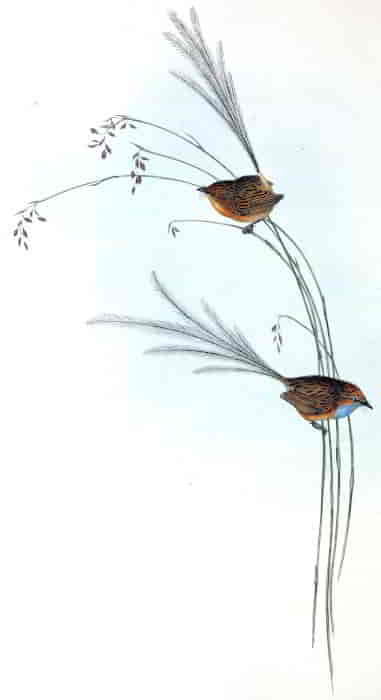
STIPITURUS MALACHURUS: Lefs.
J. & E. Gould delt. C. Hullmandel Imp.
STIPITURUS MALACHURUS, Less.
Emu Wren.
Muscicapa malachura, Lath. Ind. Orn. Supp., pl. lii.—Shaw, Gen. Zool., vol. x. p. 407.
Soft-tailed Flycatcher, Linn. Trans., vol. iv. p. 242. pl. 21.—Lath. Gen. Syn. Supp., vol. ii. p. 224.
Malurus malachurus, Vig. & Horsf. in Linn. Trans., vol. xv. p. 224.
Stipiturus malachurus, Less. Traité d’Orn., p. 415.
Soft-tailed Warbler, Lath. Gen. Hist., vol. vii. p. 123.
Waw-gul-jelly, Aborigines of New South Wales.
Djur-jeel-ya, Aborigines of the lowlands of Western Australia.
This curious little bird has a wide distribution; since it inhabits the whole of the southern portion of Australia, from Moreton Bay on the east to Swan River on the west, including Tasmania. Among the places where it is most numerous in the latter country, are the swampy grounds in the neighbourhood of Recherche Bay in D’Entrecasteaux Channel, the meadows at New Norfolk, Circular Head, and Flinder’s Island in Bass’s Straits; on the continent of Australia, Botany Bay, and indeed all portions of the country having a similar character are favoured with its presence.
In its actions it bears a close resemblance to the true Maluri, among which it has been associated, but, as the nature of its plumage would lead us to expect, it resorts to situations of a totally different character; for while the more open forest is the favourite resort of the Maluri, the Emu Wren is especially fond of low marshy districts, covered with rank high grasses and rushes. It is a recluse little bird, concealing itself from view by keeping near the ground in the midst of the more dense parts of the grass beds, and very seldom showing itself. Its extremely short round wings ill adapt it for flight, and this power is consequently seldom employed, the bird depending for progression upon its extraordinary capacity for running: in fact, when the grasses are wet from dew or rain, its wings are rendered perfectly unavailable. On the ground it is altogether as nimble and active, its creeping mouse-like motions, and the extreme facility with which it turns and bounds over the surface, enabling it easily to elude pursuit, and amply compensating for the paucity of its powers of flight. The tail is carried in an erect position, and is even occasionally retroverted over the back.
The nest, which is a small ball-shaped structure, with rather a large opening on one side, is composed of grasses lined with feathers, and artfully concealed in a tuft of grass or low shrub. One that I found in Recherche Bay contained three newly-hatched young: this being the only nest I ever met with, I am unable to give any description of its eggs, but I am informed they are always three in number.
The male is readily distinguished from the female by the blue colouring of the throat, and by a somewhat greater development of the tail-feathers. The decomposed or loose structure of these feathers, much resembling those of the Emu, has suggested the colonial name of Emu Wren for this species, an appellation singularly appropriate, inasmuch as it at once indicates the kind of plumage with which the bird is clothed, and the Wren-like nature of its habits.
The male has the crown of the head rust-red; upper surface brown, each feather having a black mark down the centre; wing-feathers dark brown, edged with rufous brown; chin and throat pale blue; sides of the neck and all the under surface bright rufous; tail dark brown; irides reddish brown; bill and feet brown.
The female differs from the male only in having the crown of the head striated with blackish brown, and the throat rufous instead of blue.
The Plate represents a male and a female of the natural size.
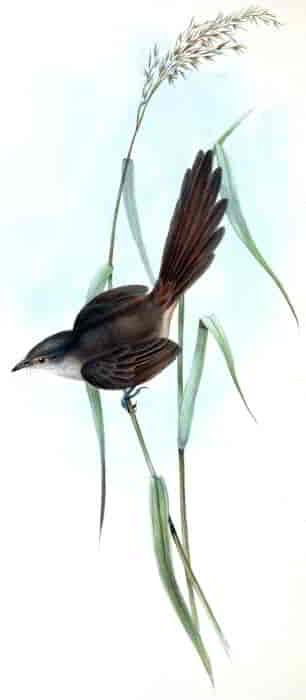
DASYORNIS AUSTRALIS: Vig. & Horsf.
J. & E. Gould delt. C. Hullmandel Imp.
DASYORNIS AUSTRALIS, Vig. & Horsf.
Bristle-bird.
Dasyornis Australis, Vig. & Horsf. in Linn. Trans., vol. xv. p. 232.—Jard. and Selb. Ill. Orn., vol. ii. pl. 73.
This bird inhabits reed-beds and thickets, particularly such as are overgrown with creepers and rank vegetation; I believe it to be found throughout New South Wales in all places suitable to its habits, although, from the recluse nature of its disposition, it is a species familiar to few, even of those who have been long resident in the colony. I killed it at Illawarra, and other specimens were presented to me by Mr. Stephen Coxen, which had been shot by him in New England, an extensive district to the eastward of the Liverpool Plains. Its powers of flight are very limited, but it threads the thickets and runs over the ground with the greatest facility. It resembles the true Maluri carrying the tail erect, as also in many other of its actions. I had no opportunity of ascertaining whether or not it be migratory; but my own impression is that it is stationary, since its powers of flight are inadequate to enable it to pass over much extent of country, and the thick brushes near the coast afford it ample shelter in winter.
I did not succeed in finding its nest, but in its nidification it doubtless closely assimilates to the Long-billed Bristle-bird of the western coast.
The sexes present no difference in plumage and but little in size; the female is, however, rather the least.
The food consists of insects of various orders.
All the upper surface brown; wings, tail-coverts and tail rufous brown, the latter indistinctly barred with a darker tint; under surface grey, gradually passing into the brown of the upper surface; over the eye an indistinct buffy stripe; irides brown; bill brown, becoming much lighter on the lower mandible; legs greyish brown.
The Plate represents a male of the natural size.
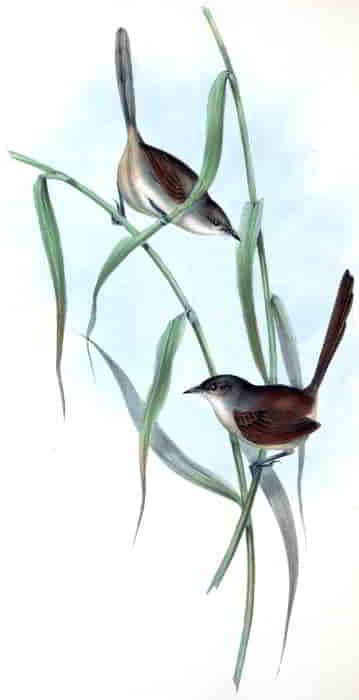
DASYORNIS TENUIROSTRIS: Gould.
J. & E. Gould delt. C. Hullmandel Imp.
DASYORNIS LONGIROSTRIS, Gould.
Long-billed Bristle-bird.
Dasyornis longirostris, Gould in Proc. of Zool. Soc., Part VIII. p. 170.
Djyr-dal-ya, Aborigines of the lowland districts of Western Australia.
The present species assimilates very closely in the character and colouring of its plumage to its eastern analogue, the Dasyornis Australis; but differs from that bird in being of a smaller size and in having a longer bill. It is a native of Western Australia, and is very generally distributed over the colony of Swan River, where it inhabits reed-beds and long grasses, and is occasionally seen in scrubby places. “It is so remarkably shy,” says Mr. Gilbert, “that it is extremely difficult to get even a glimpse of it: from the little I could observe of the bird in a state of nature, it appeared to me to feed on the ground, where its actions are extremely quick, running over the surface with its tail erect, very like the Maluri; but when perched the tail is either carried horizontally, or hanging down. The only time when it can be seen with a chance of procuring specimens, is when it ascends to a small branch or the top of a scrub to sing. Its notes are extremely varied, some being very loud and clear, and so much lengthened as to approach a song; but no two birds sing alike.
“Its flight is extremely heavy and very low; in fact the bird appears incapable of rising more than a few yards above the scrub or long grass it inhabits; it is consequently very rarely seen on a tree.
“The nest is formed of dry wiry grass without any lining, more globular than those of the Maluri, but, like them, with an opening in the side; it is of rather a large size, and the only one I met with was built in a clump of coarse grass, sheltered by an overhanging dead bush, at about seven inches from the ground. It contained two eggs, the ground-colour of which is dull brownish white, blotched and freckled with purplish brown, some of the blotches appearing as if beneath the surface, particularly at the larger end, where they are most numerous.
“The stomach is thick and muscular, and its food consists of seeds and insects.”
The sexes so closely resemble each other, that a representation and description of one will suffice for both.
All the upper surface brown; wings, tail-coverts and tail rufous brown, the latter indistinctly barred with a darker tint; under surface grey, gradually passing into the brown of the upper surface; irides bright reddish brown; upper mandible brown, lower mandible bluish green at the tip and greenish white at the base; legs bluish grey.
The Plate represents a male and female of the natural size.
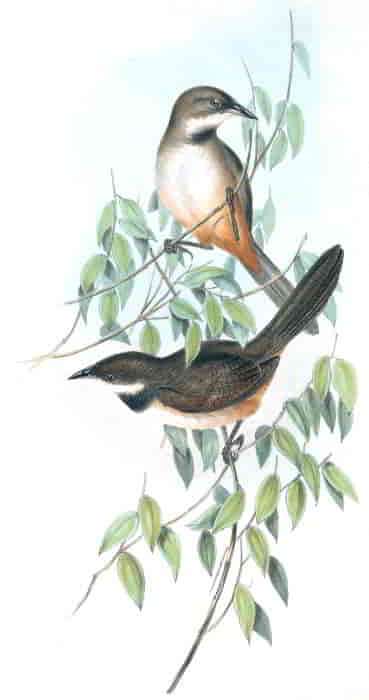
ATRICHIA CLAMOSA: Gould.
J. Gould and H. C. Richter del et lith. C. Hullmandel Imp.
ATRICHIA CLAMOSA, Gould.
Noisy Brush-bird.
Atrichia clamosa, Gould in Proc. of Zool. Soc., January 9, 1844.
Few of the novelties received from Australia are more interesting than the species to which I have given the generic name of Atrichia. It is one of the discoveries made by Mr. Gilbert, who met with it among the dense scrubs of Western Australia, and who had his attention attracted to it by its peculiar and noisy note long before he had an opportunity of observing it; and it was only after many days of patient and motionless watching among the scrubs that he succeeded in obtaining specimens, and these unfortunately were shot at so short a distance from his gun that they were all much mutilated. Future research will doubtless furnish us with some highly interesting information respecting the economy and history of this curious form, which is evidently destined to tenant the most dense thickets and tangled beds of dwarf trees, and consequently, from its recluse habits, rarely to meet the gaze of civilized man.
The examples forwarded to me by Mr. Gilbert were killed between Perth and Augusta in Western Australia, and were all males. The females will doubtless, when discovered, prove to differ but little from their mates, except that the black mark on the breast will not be so large or conspicuous. I am led to offer this opinion from the circumstance of one of the specimens sent being a young male, which usually resembles the female during the first year, and in which this mark is less conspicuous than in the others.
All the upper surface, wings and tail brown, each feather crossed by several obscure crescent-shaped bars of brown; the inner webs of the primaries very dark brown, without markings, and the tail freckled instead of barred; throat and chest reddish white, with a large irregular patch of black on the lower part of the throat; flanks brown; abdomen and under tail-coverts rufous; bill horn-colour; irides dark brown.
The figures are of the natural size.
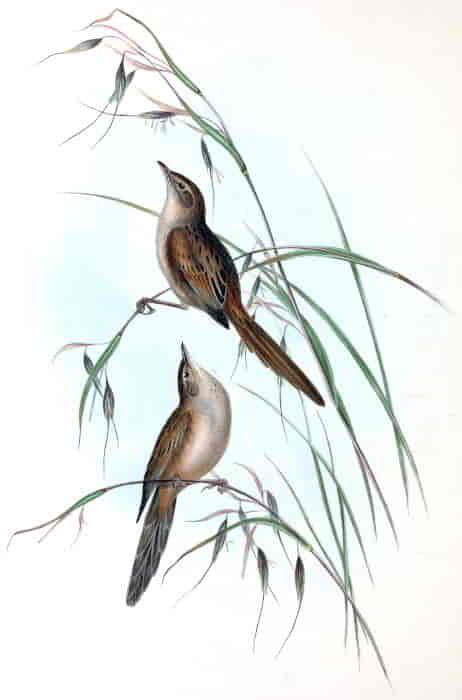
SPHENŒACUS GALACTOTES.
J. Gould and H. C. Richter del et lith. Hullmandel & Walton Imp.
SPHENŒACUS GALACTOTES.
Tawny Sphenœacus.
Malurus galactotes, Temm. Pl. Col., 65.
Megalurus galactotes, Vig. & Horsf. in Linn. Trans., vol. xv. p. 228.
This is a scarce species in New South Wales, the few individuals I have seen being-from the grassy districts of the Liverpool Plains; in all probability, however, it ranges along the eastern and over the whole of the northern portion of Australia. Mr. Gilbert’s notes inform me that he found it “tolerably abundant on the islands at the head of Van Diemen’s Gulf, where it inhabits the long grass or rushes growing in or adjacent to the swamps; it is so shy that it is very rarely seen; when closely hunted it takes wing, but flying appears to be a difficult action at all times; at least I have never seen it sustain a flight of more than a hundred yards at the utmost, and even in that short distance it seemed ready to sink into the grass with fatigue. The only note I have heard it emit is a harsh and rapidly repeated chutch. The stomachs of those I dissected were extremely muscular, and contained the remains of insects of various kinds and what appeared to be vegetable fibres.”
General plumage pale brown, deepening into rufous on the crown of the head and fading into dull white on the throat and centre of the abdomen; all the feathers of the upper surface with blackish brown centres; secondaries blackish brown, broadly margined with pale brown; tail pale brown, crossed with indistinct bars of a darker tint; irides light brown; upper mandible olive-brown, the cutting edges light yellowish white; lower mandible bluish white; tarsi and feet light reddish flesh-colour.
The figures are of the natural size.
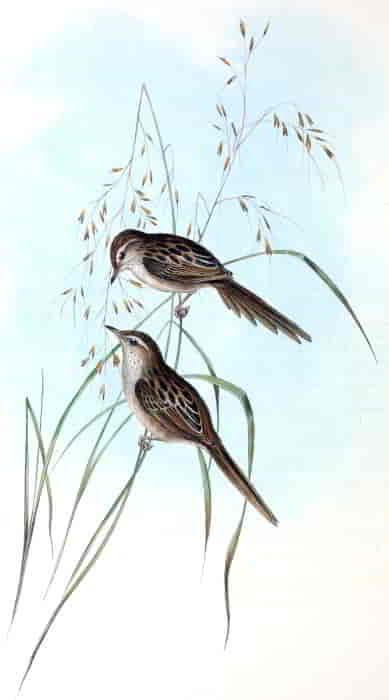
SPHENŒACUS GRAMINEUS: Gould.
J. Gould and H. C. Richter del et lith. Hullmandel & Walton Imp.
SPHENŒACUS GRAMINEUS, Gould.
Grass-loving Sphenœacus.
Sphenœacus gramineus, Gould in Proc. of Zool. Soc., Part XIII. p. 19.
Although the present species is very generally dispersed over the whole of the southern portions of Australia and Van Diemen’s Land in all situations suitable to its habits, it is as little known to the colonists as if it were not in existence, which is readily accounted for by its recluse nature and the localities it frequents, the thick beds of grasses, rushes and other kinds of herbage growing in low, damp and wet places on the mainland, and on such islands as those of Green and Actæeon in D’Entrecasteaux’ Channel, being its favourite places of resort. As may be supposed, it is a very shy species, and will almost allow itself to be trodden upon before it will quit the place of its concealment; in the open grassy beds of the flats it is more easily driven from its retreat, but even then it merely flies a few yards and then pitches again among the herbage. It would be very interesting to know whether the habits above described accord with those of the other members of the genus Sphenœacus, in which, with the concurrence of Mr. Strickland, who instituted it, I have placed the present bird.
Its song consists of four or five plaintively uttered notes, repeated five or six times in succession.
The nest is generally a very compact structure, and in Western Australia is formed of the soft tops of the flowering part of the reeds, and the thin skin-like coating of the reed-stalks, but occasionally of fine swamp-grasses, always lined with feathers; in some instances two large feathers are made to meet over the opening, which is near the top of the nest, and thus protects the inside from cold or rain: it is attached to two or three upright reeds about two feet from the surface of the water. The eggs, which are laid during the months of August and September, are four in number, nearly eight lines long and six lines broad; they are of a fleshy white, freckled and streaked all over, particularly at the larger end, with purplish red; in some instances large obscure blotches of reddish grey appear as beneath the surface of the shell.
The sexes present no difference in size or colour, and there is scarcely any variation in specimens from Van Diemen’s Land, Swan River and New South Wales.
Stripe over the eye white; all the upper surface brown, the centre of the feathers being dark brown; secondaries brownish black, margined with buff; tail pale reddish brown, with dark brown shafts; under surface grey, passing into black on the flanks and vent; each feather of the breast with a very minute line of dark brown down the centre; bill and tarsi fleshy brown.
The figures are of the natural size.
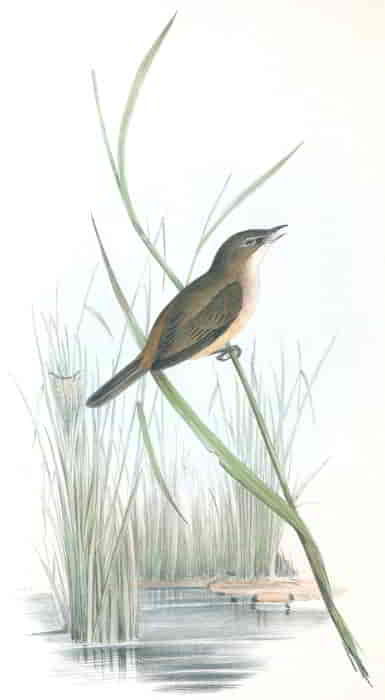
ACROCEPHALUS AUSTRALIS: Gould.
J. Gould and H. C. Richter del et lith. Hullmandel & Walton Imp.
ACROCEPHALUS AUSTRALIS, Gould.
Reed Warbler.
Reed Warbler, Lewin, Birds of New Holland, pl. 18.
This bird does not inhabit Van Diemen’s Land, but is universally dispersed among the sedgy sides of rivers and lagoons, both in South Australia and New South Wales; I also observed it in great abundance on the banks of all the rivers to the northward of Liverpool Plains in all these localities; it is strictly migratory, arriving in September and departing again before the commencement of winter. In its general economy it closely resembles its European congeners, but possesses a still louder and more melodious song, which it is continually pouring forth and which tends much to enliven the monotony of the parts frequented by it. It is rather a late breeder, scarcely ever beginning this natural duty before the month of November. The nest, like that of the Reed Warbler of Europe, is suspended from two or three reeds at about two feet above the surface of the water, and is composed of the soft skins of reeds and dried rushes. The eggs, which are four in number, ten lines long by seven lines broad, are of a greyish white, thickly marked all over with irregular blotches and markings of yellowish brown, umber brown and bluish grey, intermingled together without any appearance of order or arrangement.
The food consists of insects of various kinds.
The sexes are so precisely alike that dissection must be resorted to to distinguish them.
All the upper surface olive-brown; wings and tail brown, margined with olive-brown; all the under surface tawny or deep buff, fading into white on the throat; under mandible fleshy white, remainder of the bill and the legs olive horn-colour; irides brown.
The figure is of the natural size.
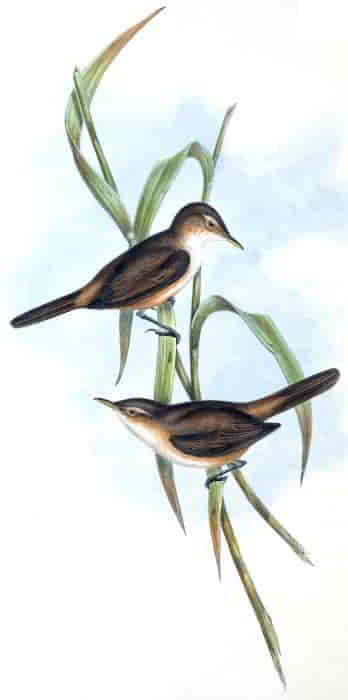
ACROCEPHALUS LONGIROSTRIS: Gould.
J. Gould and H. C. Richter del et lith. Hullmandel & Walton Imp.
ACROCEPHALUS LONGIROSTRIS, Gould.
Long-billed Sedge-Warbler.
Calamoherpe longirostris, Gould in Proc. of Zool. Soc., Part XIII. p. 20.
Gooȑ-jee-gooȑ-jee, Aborigines of the lowland districts of Western Australia.
The present bird, which I have designated longirostris, is the largest of the two species of Acrocephalus known to inhabit Australia.
It is a native of the western portion of the country, where I learn from Mr. Gilbert’s notes that “it is to be found in all the dense reed-beds bordering the river and lakes around Perth, but is so shy, particularly the female, that it scarcely ever shows itself above the reeds. I have remarked also that it never wanders many yards from the nest, which is placed on four or five upright reeds growing in the water at about two feet from the surface. It is of a deep cup-shaped form, and is composed of the soft skins of reeds and dried rushes. The breeding-season comprises the months of August and September. The eggs are four in number, of a dull greenish white, blotched all over, but particularly at the larger end, with large and small irregularly shaped patches of olive, some being darker than the others, the lighter-coloured ones appearing as if beneath the surface of the shell; they are three-quarters of an inch in length by five-eighths of an inch in breadth.
“It is almost always singing both night and day, and its song is more beautiful and melodious than that of any other Australian bird with which I am acquainted; being in many parts very like and certainly not inferior to that of the far-famed Nightingale of Europe.
“The stomach is tolerably muscular, and the food consists of coleopterous and other kinds of insects.”
Faint line over the eye fawn-colour; all the upper surface reddish brown, becoming more rufous on the upper tail-coverts; primaries and tail deep brown, fringed with rufous; chin whitish; all the under surface deep fawn-colour; irides yellowish brown.
The figures are of the natural size.
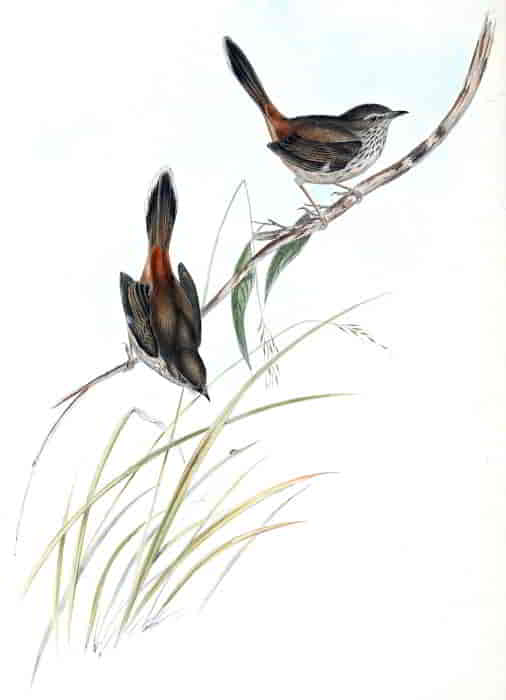
HYLACOLA PYRRHOPYGIA:
J. Gould and H. C. Richter del et lith. C. Hullmandel Imp.
HYLACOLA PYRRHOPYGIA.
Red-rumped Wren.
Acanthiza pyrrhopygia, Vig. & Horsf. in Linn. Trans., vol. xv. p. 227.
In some parts of its economy this bird closely resembles the Maluri particularly in the upright position in which it carries its tail, in the quick hopping motion with which it passes over the surface of the ground, and the agility with which it trips along the horizontal branches of the fallen trees. The situations most favourable to its habits are open sterile spots, here and there studded with clumps of brushes or dense herbage. The beds and sides of creeks, as well as the crowns of stony hills, wherever they are scrubby, are also situations favourable to its habits. I have always observed it either in pairs or in small companies, probably the brood of a single pair, whose young accompany them throughout the autumn like the Maluri.
Its song, which is by no means disagreeable, is poured forth while the bird is perched upon some conspicuous part of a bush, or some little spray among the branches of the large fallen trees, where it loves to dwell, as on the approach of an intruder it can readily and effectually secrete itself among the high grass and herbage which have grown up amidst the branches. The facility with which it creeps among or threads these little thickets is surprising. It rarely flies, but depends for progression more upon the rapidity with which it can pass over the ground, than upon the feeble powers of its small rounded wing.
This species may be regarded as a bird whose natural habitat is the interior rather than the country near the coast; for although it does occur in some districts of New South Wales on the sea side of the dividing range, it is much more abundant on the northern or interior side in all situations favourable to its existence. I found it on the low bills to the north of the Liverpool Plains, as well as in most parts of South Australia; I believe it is a stationary bird, as it appeared to be equally numerous in summer and winter.
Of its nidification I have nothing to communicate, its nest not having been discovered either by myself or by any of my party.
Its food consists of insects of various kinds, and like many insectivorous birds, I believe it seldom if ever drinks, not even during the greatest droughts.
The sexes present no visible difference in their plumage.
Crown of the head, all the upper surface, wings and tail brown; lower part of the rump and upper tail-coverts chestnut-red; all but the two centre tail-feathers crossed near the tip with a broad band of black, beyond which the tips are greyish white; line over the eye and all the under surface greyish white, each feather of the latter with a line of black down the centre, except on the middle of the abdomen bill dark brown; irides buffy white; legs flesh-brown.
The figures are of the natural size.

HYLACOLA CAUTA: Gould.
J. Gould and H. C. Richter del et lith. C. Hullmandel Imp.
HYLACOLA CAUTA, Gould.
Cautious Wren.
Hylacola cauta, Gould in Proc. of Zool. Soc., Part X. p. 135.
The only locality in which I have seen this species is the great scrub clothing the banks of the river Murray in South Australia, where it was not uncommon, but so excessively shy that I obtained a single specimen only during my stay in the district. Its timidity being so great, and its natural habitat the more dense parts of the scrub, it is a species which must for a long time be exceedingly scarce in our collections. The individual killed was fired at within a few yards of where I stood, it being impossible to sight it at a greater distance.
With the exception of its being even more shy, its whole habits and economy appeared to be very similar to those of the preceding species (H. pyrrhopygia). It carries its tail perfectly erect, and hops over the ground and threads the bushes with the greatest alacrity; generally keeping among the more dense parts of the low bushes, and only exposing itself on the outermost twigs when desirous of pouring forth its song, which is sweet and harmonious, and by which its presence is more frequently detected than by any other means.
I could neither find the nest and eggs myself nor obtain any information respecting them; but I have no doubt that when discovered the nest will be found to be of a domed form, with a small hole for an entrance, and the eggs very similar to those of the Maluri. In size the H. cauta is rather less than the H. pyrrhopygia, has the markings of the under surface much bolder, and the chestnut-coloured mark on the rump of a much deeper tint.
Line from the base of the upper mandible along the side of the face and over the eye white; above this a narrow line of black; crown of the head and all the upper surface brown; upper and under tail-coverts bright chestnut; wing-coverts brown, edged with brownish white; primaries brown, with the outer web white at the base, forming a conspicuous spot in the centre of the wing; tail blackish brown, tipped with white; throat striated with black and white, produced by each feather being black down the centre and fringed with white; flanks mottled brown and white; abdomen white; hill dark brown; irides buffy white; feet flesh-brown.
The figures are of the natural size.
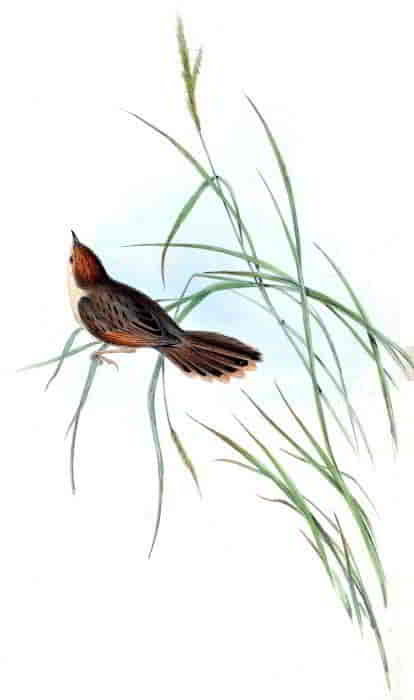
CYSTICOLA MAGNA: Gould.
J. Gould and H. C. Richter del et lith. Hullmandel & Walton Imp.
CYSTICOLA MAGNA, Gould.
Cysticola campestris, Gould in Proc. of Zool. Soc., Part XIII. p. 20.
I am indebted to the kindness of Hugh E. Strickland, Esq., for the loan of a fine example of this bird for the purpose of figuring in the present work. It is one of the largest species of the group, and hence I have assigned to it the distinctive appellation of magna. Nothing whatever is known of its habits and manners, but we may reasonably infer that they are very similar to those of its congeners. The precise locality it inhabits is also unknown; Mr. Strickland having obtained it from a general collection of Australian birds, without the situation in which it had been procured being attached to it.
Head rusty red; back and wing-coverts brownish grey; all the feathers of the upper surface with a broad stripe of dark brown down the centre; wings blackish brown, the primaries margined externally with rusty red and the secondaries edged all round with brownish grey; tail reddish brown, all but the two centre feathers with a large spot of black near the tip; all the under surface pale buff.
The Plate represents the bird of the natural size.
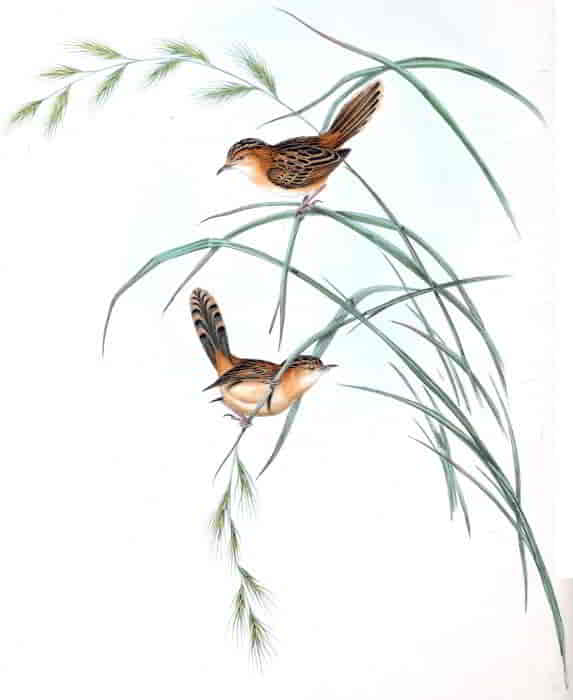
CYSTICOLA EXILIS.
J. Gould and H. C. Richter del et lith. Hullmandel & Walton Imp.
CYSTICOLA EXILIS.
Exile Warbler.
Exile Warbler, Lath. Gen. Hist., vol. vii. p. 136.
Malurus exilis, Lath. MSS. Vig. & Horsf. in Linn. Trans., vol. xv. p. 223.—Less. Man. d’Orn., tom. i. p. 279.
This species appears to have been first noticed by Latham in the seventh volume of his “General History of Birds” under the title of Exile Warbler, and to have been subsequently placed in the genus Cysticola by Messrs. Vigors and Horsfield while engaged in naming the collection of Australian birds in the possession of the Linnean Society. Its natural habitat is New South Wales and South Australia, in both of which colonies I observed it to be abundantly dispersed among the thick beds of grasses which clothe the valleys and open plains. I have never received it from either of the other colonies, all of which, however, are inhabited by nearly allied species. It is very retiring in its habits, generally creeping about among the grasses, and will almost admit of being trodden upon before it will rise and take wing; during the months of spring the male becomes somewhat bolder, and early in the morning will frequently perch on the highest of the grasses and pour forth a pretty but feeble song, resembling that of the Maluri. As some confusion existed respecting the sexes of the various species of this genus, I was particular in dissecting all the individuals I shot, and I can therefore state with certainty that the plumage of both sexes of this species is perfectly similar and that the only outward difference between them consists in the female being somewhat smaller than her mate.
I was not able to discover the nest and eggs of this little bird, which doubtless breeds among the grasses, and builds a dome-shaped nest similar to that of its European ally.
Crown of the head, back, wing-coverts, scapularies and tail-feathers brownish black, each feather narrowly margined with buff; sides and back of the neck and all the under surface sandy buff, fading into white on the throat and centre of the abdomen; bill and feet flesh-brown.
The figure represents the bird of the natural size.
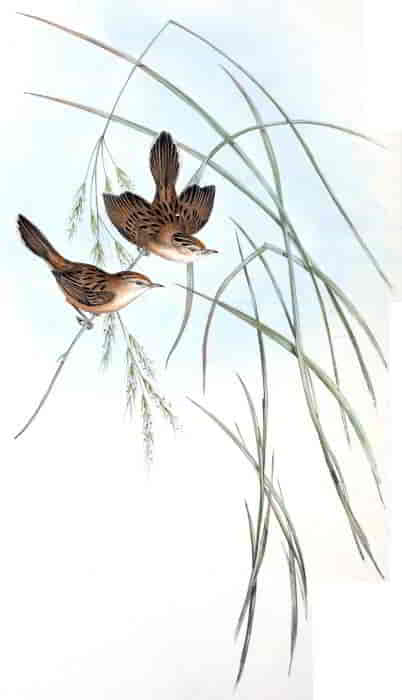
CYSTICOLA LINEACAPILLA: Gould.
J. Gould and H. C. Richter del et lith. Hullmandel & Walton Imp.
CYSTICOLA LINEOCAPILLA, Gould.
Lineated Warbler.
Cysticola lineocapilla, Gould in Proc. of Zool. Soc., Jan. 27, 1847.
The Cysticola lineocapilla is a much smaller and more delicately formed species than the C. exilis, and may, moreover, be distinguished from that and every other member of the genus with which I am acquainted by the lineated form of the markings of the head. It is a native of the north coast of Australia, and all the specimens I have seen were from the neighbourhood of Port Essington. Mr. Gilbert states that it “is very rarely seen in consequence of its generally inhabiting the long grass of the swamps, where it creeps about more like a mouse than a bird, and if once alarmed it is no easy task to get a sight of it again; its note is a short and feeble, but very pleasing song.
“The stomach is muscular, and the food consists of insects of various kinds.”
General plumage pale rufous, with broad and conspicuous striæ of blackish brown forming lines down the centre of the feathers of the head and back; the under surface fading into white on the throat and centre of the chest; tail-feathers with a conspicuous blackish spot on the under surface near the tip; irides light reddish brown; bill and feet flesh-brown.
The figures are of the natural size.
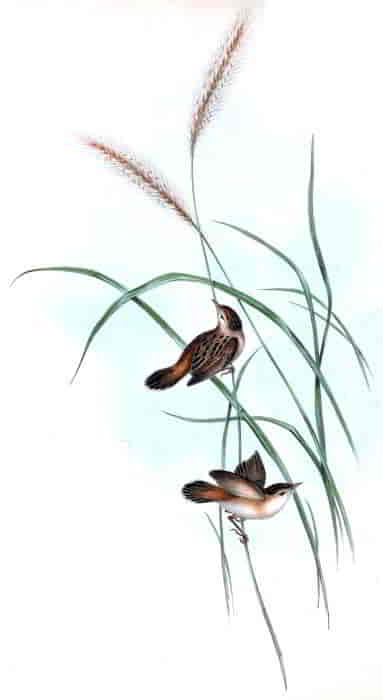
CYSTICOLA ISURA: Gould.
J. Gould and H. C. Richter del et lith. Hullmandel & Walton Imp.
CYSTICOLA ISURA, Gould.
Square-tailed Warbler.
Cysticola isura, Gould in Proc. of Zool. Soc., Part XV.
Little as is the information I have been able to give respecting the C. ruficeps, I have still less to communicate about the present species, circumstances not having admitted of my seeing them in a state of nature: at a first glance it might readily be mistaken for the C. exilis, but after a careful examination of many specimens I am satisfied of its being distinct; had it been identical with that species, I must have procured specimens at the same time that I killed the many examples I obtained. I am not so sure however that it may not prove to be the female, or some peculiar state of plumage of the Cysticola ruficeps; without a further knowledge of the subject, I can only view it as distinct from both, and I have therefore assigned to it the specific appellation of isura, as indicative of the shorter and more truncated form of its tail, the principal character by which it may be distinguished. Like the other species of the group, it appears to enjoy an extensive range over the grassy districts of the country, the specimens in my possession having been killed on the Liverpool Plains and at Port Phillip; the arid and sterile nature of the country seems to be peculiarly adapted to the members of this group, and hence there are many species.
Sides and back of the neck and rump pale rufous; crown of the head, back and secondaries deep brownish black, each feather margined with buff; tail dark brown margined with buff, and crossed on the under side near the tip with a broad conspicuous band of black; under surface deep buff, becoming paler on the chin and centre of the abdomen; bill brown; feet yellowish brown.
The figures are of the natural size.
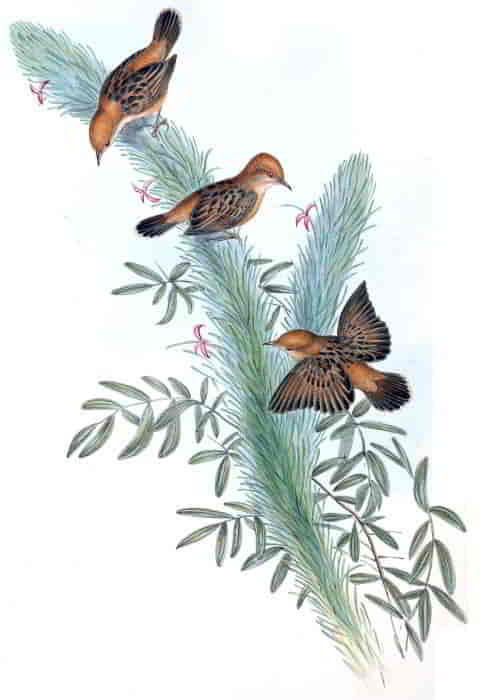
CYSTICOLA RUFICEPS: Gould.
J. Gould and H. C. Richter del et lith. Hullmandel & Walton Imp.
CYSTICOLA RUFICEPS, Gould.
Rufous-headed Warbler.
Cysticola ruficeps, Gould in Proc. of Zool. Soc., Part V. p. 150; and in Syn. Birds of Australia, Part IV.
It would give me great pleasure could I communicate any particulars respecting this pretty little bird, but this unfortunately I am unable to do, no information of any kind having as yet reached me; I can only say therefore that I possess three examples, one from the Liverpool Plains in New South Wales, another from the district of Port Philip, and a third from the north coast, which proves that it enjoys a widely extended range of habitat. The uniform rufous colouring of the head and occiput at once distinguishes it from all the other Australian members of the genus. In its habits, manners and general economy it doubtless closely assimilates to its congeners the C. exilis and lineocapilla, and like them inhabits the open grassy glades between the forests, the grassy crowns of thinly-timbered hills, and all similar situations.
Crown of the head, and back of the neck, rump, chest, flanks and thighs delicate fawn-colour, becoming deeper and redder on the crown and the rump; upper part of the back, secondaries and tail deep brownish black, each feather margined all round with buff; throat and centre of the abdomen white; bill brown; feet yellowish brown.
The Plate represents the birds of the natural size on one of the plants of New South Wales.
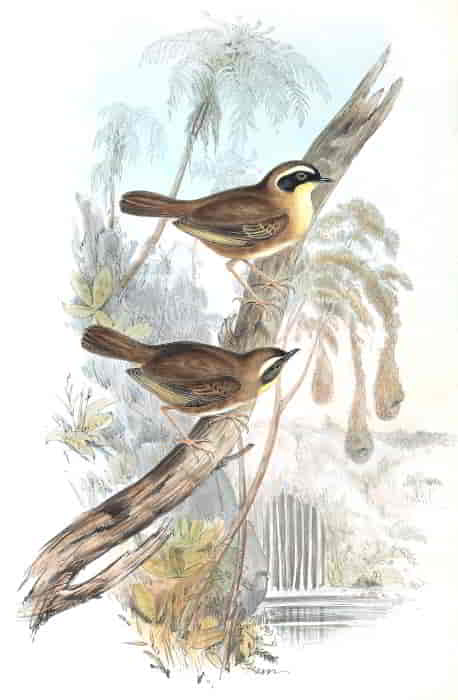
SERICORNIS CITREOGULARIS: Gould.
J. Gould and H. C. Richter del et lith. C. Hullmandel Imp.
SERICORNIS CITREOGULARIS, Gould.
Yellow-throated Sericornis.
Sericornis citreogularis, Gould in Proc. of Zool. Soc., Part V. p. 133; and in Synopsis of the Birds of Australia, Part IV.
This is the largest and most attractive species of the genus yet discovered, and so far as I am aware, its habitat is restricted to the south-eastern portions of Australia, where it dwells exclusively in the districts known by the name of “brushes.” I personally observed it in those of Illawarra, and of the Hunter, and in the cedar brushes of the Liverpool range. It frequents the most retired parts of the forest, living in gullies and under the canopy of lofty trees, hopping about among the stems of the tree-fern, fallen trunks of patriarchal gums and moss-covered stones. It rarely flies, and when disturbed, seeks seclusion and safety by hopping away among the underwood. Its food, which consists of insects of various kinds, is obtained on the ground or among the trunks of the prostrate trees, over which and the large stones it passes with much ease and agility.
The sexes are very similar in colour, but the female may at all times be distinguished by her smaller size and the less strongly contrasted tints of her plumage, particularly in the hue of the streak running through the eye and extending over the ear-coverts, which is neither so dark nor so broad as in the male.
One of the most interesting points connected with the history of this species is the situations chosen for its nest. All those who have rambled in the Australian forests must have observed, that in their more dense and humid parts an atmosphere peculiarly adapted for the rapid and abundant growth of mosses of various kinds is generated, and that these mosses not only grow upon the trunks of decayed trees, but are often accumulated in large masses at the extremities of the drooping branches; these masses often become of sufficient size to admit of the bird constructing a nest in the centre of them with so much art that it is impossible to distinguish it from any of the other pendulous masses in the vicinity. These bunches are frequently a yard in length, and in some instances hang so near the ground as to strike the head of the explorer during his rambles; in others they are placed high up upon the trees, but only in such parts of the forest where there is an open space entirely shaded by overhanging foliage: as will be readily conceived, in whatever situations they are met with, they at all times form a remarkable and conspicuous feature in the landscape. Although the nest is constantly disturbed by the wind and liable to be shaken when the tree is disturbed, so secure does the inmate consider itself from danger or intrusion of any kind, that I have frequently captured the female while sitting on her eggs, a feat that may always be accomplished by carefully placing the hand over the entrance; that is, if it can be detected, to effect which no slight degree of close prying and examination is necessary.
The nest is formed of the inner bark of trees, intermingled with green moss, which soon vegetates; sometimes dried grasses and fibrous roots form part of the materials of which it is composed, and it is warmly lined with feathers. The eggs, which are three in number and much elongated in form, vary considerably in colour, the most constant tint being a clove-brown freckled over the larger end with dark umber brown, frequently assuming the form of a complete band or zone: their medium length is one inch, and their breadth eight lines.
Lores, circle around the eye, and the ear-coverts deep black; a conspicuous line of yellowish white above and for some distance beyond the eye; crown of the head, and all the upper surface, secondaries, wing-coverts and tail reddish brown, becoming more rufous on the upper tail-coverts and tail; outer edges of the primaries olive; spurious wing blackish brown; throat yellow; chest and flanks olive-brown; centre of the abdomen white; bill brownish black; irides reddish brown; legs purplish flesh-colour, in some specimens flesh-white.
The figures represent the two sexes of the natural size.
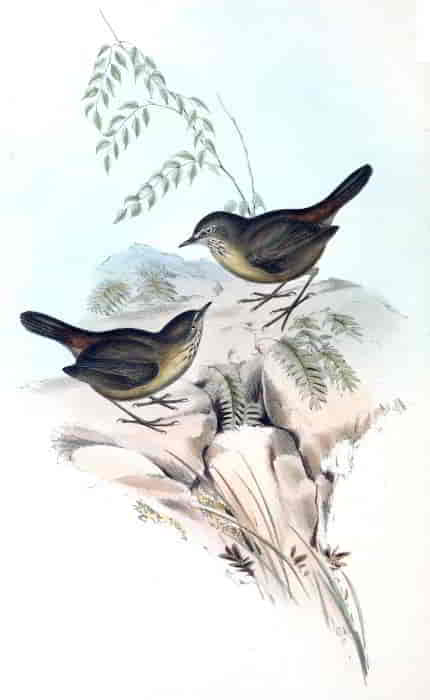
SERICORNIS HUMILIS: Gould.
J. Gould and H. C. Richter del et lith. Hullmandel & Walton Imp.
SERICORNIS HUMILIS, Gould.
Sombre-coloured Sericornis.
Sericornis humilis, Gould in Proc. of Zool. Soc., Part V. p. 133; and in Syn. Birds of Australia, Part IV.
This species is very generally dispersed over Van Diemen’s Land, and as I have found it on some of the islands in Bass’s Straits, it is not improbable that it may also extend its range to the southern coast of the continent of Australia. Ravines, deep glens, water-courses covered with dense herbage and thickly wooded copses are the situations congenial to the habits of this bird; those that are most humid or damp being apparently preferred to any other; consequently, although it is very abundant and its distribution very general, it is a bird that is less seen, and one whose habits are less known than almost any other of the indigenous birds of the island. In many of its actions it closely resembles the Wren (Troglodytes Europæus), particularly in its manner of hopping about on the ground, and from stone to stone, with its tail erect in search of insects, upon which it solely subsists; it also assimilates to the Wren in the form, construction and situation of its nest; but in the number and colour of its eggs there is much difference. It rarely flies more than a few yards at a time, but secretes itself in the midst of the little thicket in which it has taken up its abode. There is little difficulty in finding the nest; for although it is in general very artfully concealed among the herbage at the base of a tree, on the edge of a shelving bank, or among the thick tangle of the scrub, yet by attentively watching the old birds for a short time, they will soon indicate by their actions the immediate locality of the nest. The male constantly cheers his mate with a pretty lively song, which, although neither loud nor voluminous, serves to give life to its secluded abode, which in many instances is in the depths of the forests, where few sounds are heard except the monotonous note of the Honey-sucker, and the perpetual rippling of the rivulet as it steals over the stony bed of the gully. It is sometimes seen, particularly towards evening, to leave its lurking-place and seek any little open part or glade in the forest, doubtless attracted to such situations in search of food.
The sexes present no difference whatever in the colouring of the plumage, consequently dissection is necessary to distinguish them.
The nest is of rather a large size and of a domed form, outwardly composed of any coarse materials at hand, such as leaves, tufts of grass, roots, &c., the interior being formed of similar substances, but of a finer kind, and the whole carefully lined with feathers. The eggs, which are large for the size of the bird, are three in number, of a reddish white, curiously freckled and marked all over with reddish brown, particularly at the larger end, where the markings assume the form of a zone; they are ten and a half lines long by eight lines broad.
Lores blackish brown, above which an obscure stripe of white; crown of the head and all the upper surface, wings and tail dark olive-brown with a tinge of red, which becomes more conspicuous on the rump and tail-feathers; spurious wing blackish brown, each feather margined with white; throat greyish white, spotted with blackish brown; chest and centre of the abdomen brownish yellow, the former singularly but more obscurely spotted than the throat; flanks chestnut-brown; bill blackish brown; legs dark brown; irides straw-yellow.
The Plate represents the two sexes of the natural size.
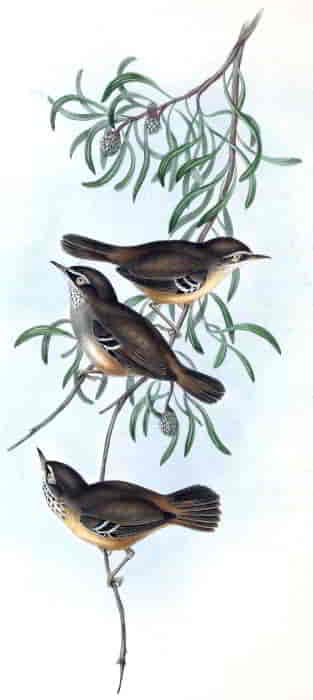
SERICORNIS OSCULANS: Gould.
J. Gould and H. C. Richter del et lith. Hullmandel & Walton Imp.
SERICORNIS OSCULANS, Gould.
Allied Sericornis.
Sericornis osculans, Gould in Proc. of Zool. Soc., January 27, 1847.
The Sericornis osculans inhabits South Australia, where it frequents underwoods and scrubby places, the bottom of dry water-courses, gulleys, &c.; it is naturally shy and retiring in its habits, and evades pursuit by creeping beneath the herbage and making its exit on the other side. It is most nearly allied to the S. frontalis, and is intermediate in size between that species and the S. humilis; from the former it differs in having at all times numerous longitudinal blotches of black on the throat, and from the latter in these spots being much more distinct than in that species. I have seen specimens in which the yellow tint which pervades the centre of the abdomen has given place to grey or greyish white, as shown in the centre figure of the accompanying Plate; but I have never found the tail tipped with white, as in S. maculata and S. lævigaster.
The sexes present the usual characteristic of the genus, in the absence of any black mark on the lores of the female, which are similar to the other parts of the body.
All the upper surface, wings and tail dark brown, all but the two centre feathers of the latter crossed by an obscure band of black near the extremity; spurious wing-feathers black, margined with white; lores black, above which on each side a patch of white, continued in a fine line over the eye; throat and centre of the abdomen greyish white in some and yellowish white in others, marked with a few oblong black spots on the throat.
The female is somewhat smaller in size, and has the lores brown instead of black.
The figures represent two males and a female of the natural size, the upper figure being that of the female.
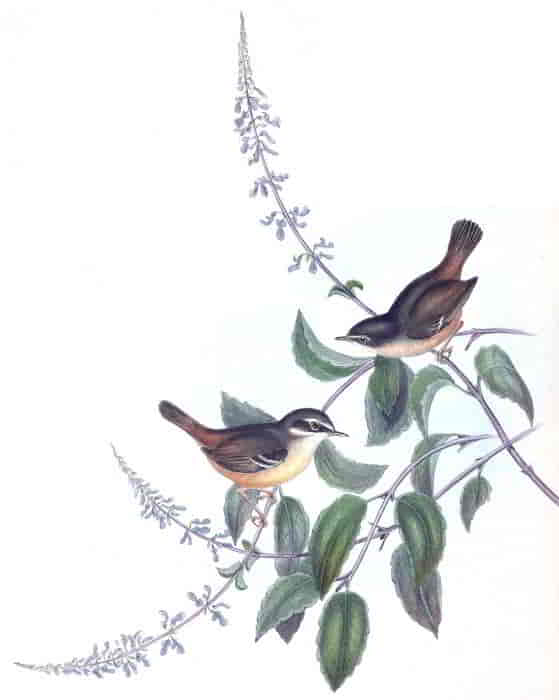
SERICORNIS FRONTALIS.
J. Gould and H. C. Richter del et lith. Hullmandel & Walton Imp.
SERICORNIS FRONTALIS.
White-fronted Sericornis.
Acanthiza frontalis, Vig. & Horsf. in Linn. Trans., vol. xv. p. 226.—Gould, Syn. Birds of Australia, Part IV.
Sericornis parvulus, Gould in Proc. of Zool. Soc., Part V. p. 134; and in Syn. Birds of Australia, Part IV. female.
This little bird inhabits the brushes, as well as all humid situations clothed with thick underwood, such as the sides of creeks, gullies, &c. The locality in which it is most abundant is the south-eastern part of Australia, where it is very numerous in all the dense forests which stretch along the coast between Sydney and Moreton Bay, and I believe I may safely state that its range does not extend westward of the 134th degree of East longitude, beyond which a nearly-allied species is found; the species, therefore, inosculate about Spencer’s and St. Vincent’s Gulfs in South Australia. Like the other members of the genus this bird generally bops about the bottoms of the brushes, selecting in preference the most damp and humid parts, where rotten wood and moss-covered stones afford some peculiar species of insect food, upon which it is destined to live. All the members of this genus are very Wren-like in their habits, actions, the kind of food they select, and in the structure of their nest. The present is one of the smallest yet discovered, and was always a favourite little bird with me, for in the inmost recesses of the forest, where all nature was hushed to quietude, and silence reigned supreme, the presence of the little bird figured in the accompanying Plate, hopping about from stone to stone in search of its insect food, now and then broke the monotony of the scene with its inward warbling strain, which however is so feeble, that it can only be heard when uttered close at hand.
The sexes present so little difference in colour that they cannot be distinguished with certainty; the female is somewhat the smaller. The young birds differ from the adult in having a few faint spots on the throat, but which are entirely lost as they advance in age.
The nest of this species, which, as I have before remarked, is very like that of the European Wren (Troglodytes Europæus), is made of leaves, moss and fibrous roots, and lined with feathers; its site is various, being sometimes under the shelving of a bank, and at others at the foot of a tuft of grass or herbage, beneath a stone, &c.; it is quite spherical in form, with a small neatly-made hole for an entrance. The breeding-season includes August, and the three or four following months, during which period two or three broods are usually reared. The eggs, which are generally three in number, are of a dull flesh-white, freckled and streaked with purplish brown, particularly at the larger end; their medium length is ten lines and breadth seven and a half lines.
Centre of the forehead, lores, and a line beneath the eye black; over the eye a line of greyish white; crown of the head, all the upper surface, wings and tail olive-brown; wing-coverts tipped with white; spurious wing blackish brown; throat white, striated with black; centre of the chest and abdomen citron-yellow; flanks olive-brown; bill blackish brown; feet yellowish white.
The Plate represents the male and female of the natural size. The very pretty plant was gathered in the brushes of Illawarra, where the birds are tolerably numerous.
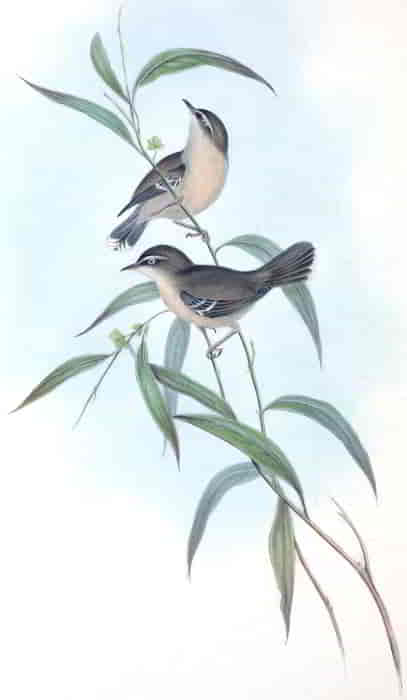
SERICORNIS LÆVIGASTER: Gould.
J. Gould and H. C. Richter del et lith. Hullmandel & Walton Imp.
SERICORNIS LÆVIGASTER, Gould.
Buff-breasted Sericornis.
Sericornis lævigaster, Gould in Proc. of Zool. Soc., January 27, 1847.
This species, although nearly allied to the S. maculata, is distinguished by the entire absence of spots on the throat and chest, and by having the tail-feathers largely tipped with white.
The male and female in my collection, and which are represented on the accompanying Plate, are part of the results of Dr. Leichardt’s overland expedition from Moreton Bay to Port Essington, they having been killed by Mr. Gilbert on the 30th of November 1844; but no information whatever is to be found respecting them in his Journal.
All the upper surface brown; tail deepening into black near the extremity and tipped with white; spurious wing-feathers dark brown, margined with white on their inner webs; lores and mark under the eye brownish black; above the eye an indistinct line of white; all the under surface washed with yellowish buff; irides greenish white.
The female presents the usual differences, being somewhat smaller in size and wanting the black mark on the lores.
The figures are of the natural size.
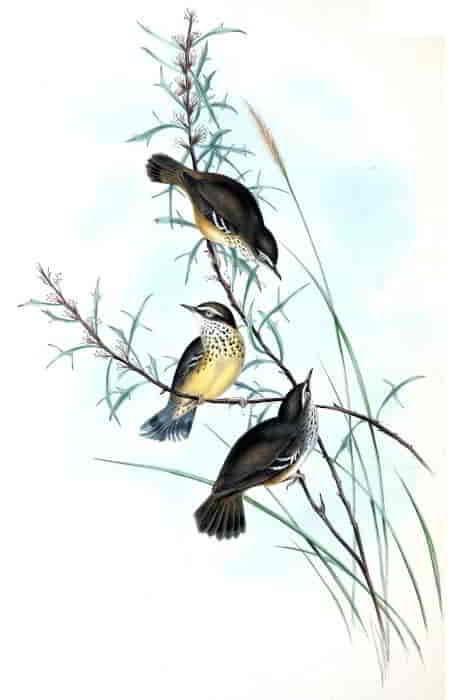
SERICORNIS MACULATA: Gould.
J. Gould and H. C. Richter del et lith. Hullmandel & Walton Imp.
SERICORNIS MACULATUS, Gould.
Spotted Sericornis.
Sericornis maculatus, Gould in Proc. of Zool. Soc., January 27, 1847.
Goor-gal, Aborigines of the mountain districts of Western Australia.
The present bird, to which I have assigned the specific term of maculatus has always been a source of perplexity to me, from the circumstance of its varying considerably in its markings; after mature consideration, however, I am induced to regard the specimens from South Australia, Western Australia and the north coast as referable to one and the same species, each however possessing trivial differences by which it may be known from whence it was received. Specimens from the Houtman’s Abrolhos are of a rather smaller size, of a much greyer tint on the back, and have much darker-coloured legs. I believe that the bright yellow wash on the under surface of some individuals is characteristic of newly moulted or young birds: in this species, not only is the throat spotted with black, but the spotting extends over the chest and some distance down the flanks; it has at all times the tail tipped with white, a character which serves at once to distinguish it from S. osculans and S. frontalis. Scrubby places, and ravines covered with dense herbage, whether in sterile or humid situations, are its favourite resort. It has the same shy disposition and retiring habits as the other members of the genus, depending for safety rather upon its creeping, mouse-like habits than upon its powers of flight, which are indeed seldom resorted to.
Its note is a harsh, grating kind of twitter, often repeated.
The nest is a warm, dome-shaped structure, formed of leaves and grasses, and lined with feathers; the eggs are reddish white, minutely freckled and streaked with reddish brown, particularly at the larger end; they are three in number, nine lines long by seven lines broad.
All the upper surface, wings and tail brown; the latter crossed near the tip with a broad band of blackish brown, and the outer feathers slightly tipped with white; forehead and lores deep black; stripe above and a small patch below the eye white; spurious wing-feathers black, margined on their inner web with white; under surface in some specimens greyish white, in others washed with yellow; the feathers of the throat and chest spotted with black on a light ground; irides greenish white.
The female is somewhat smaller than her mate, and has the lores brown instead of black; in other respects her plumage is very similar to that of the male.
The upper figure in the accompanying Plate represents a female, and the lower probably a young male; the figures are of the natural size, from specimens killed in Southern and Western Australia.
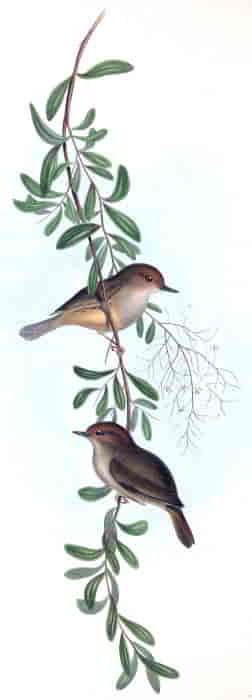
ACANTHIZA MAGNIROSTRIS: Gould.
J. Gould and H. C. Richter del et lith. Hullmandel & Walton Imp.
SERICORNIS MAGNIROSTRIS, Gould.
Large-billed Sericornis.
Acanthiza magnirostra, Gould in Proc. of Zool. Soc., Part V. p. 146; and in Syn. Birds of Australia, Part IV.
The Sericornis magnirostris an inhabitant of the brushes of New South Wales, both those which clothe the gullies and sides of the mountain ranges of the interior, as well as those near the coast; such as occur at Illawarra and on the banks of the Hunter, the Clarence, the Macleay and other rivers; it is never seen in the open country, and so far as I am aware, is entirely confined to New South Wales. Although it has nothing either in its form or colouring to recommend it to notice, it must always be an object of interest, from the very singular nest it constructs, and which, like that of Sericornis citreogularis, forms a remarkable object in the scenery of the portion of the country it inhabits. It is formed of a large loose mass of moss, and being attached to the extreme tips of the pendent branches, waves about with every wind that blows; it is very frequently constructed within reach of the hand, but is more often suspended at about ten, and sometimes as high as thirty feet from the ground; occasionally two or three are constructed together under a dense canopy of foliage, overhanging water or a deep and gloomy gully, and then present a very singular appearance. I procured several examples by shooting the branch asunder just above the nest. The nest so perfectly resembles the tufts of living moss which are attached to many of the extremities of the branches of the trees of the brushes, that it is impossible to distinguish the one from the other; and it is a question whether the bird purposely builds its nest in imitation of these hanging masses in order to elude pursuit, or whether it avails itself of the mass already formed, and by a little architectural skill converts it into a receptacle for its eggs. It would seem that the same nest is resorted to for several seasons in succession, and probably for a series of years; the entire mass consists of living moss, and the small hole left for an entrance is so skilfully concealed as scarcely to admit of detection. The breeding-season commences in August and continues until February, during which period many broods are reared. I procured a nest in September out of which flew three young birds, and others during the same month which contained eggs so recently laid that they could scarcely have been sat upon. The eggs are generally two or three in number; their ground-colour varies from bluish white to dull reddish white, with the larger end sparingly washed, freckled and streaked with dark brown; they are large for the size of the bird, being nine and a half lines long by seven lines broad.
It is a very active but shy bird, keeping much among the branches of the high trees, where it gains a plentiful supply of insect food; it may, however, be easily enticed into view by imitating the squeak of its young.
Its powers of song are very feeble.
The sexes do not differ in external appearance, nor do the young when fully fledged offer any variation in colour from the adult.
Crown of the head, all the upper surface, wings and tail olive-brown, the forehead and tail becoming rufous brown; throat and chest brownish white; abdomen greyish white, passing into bright olive-green on the lower part of the flanks; bill black; feet light brown; irides brown.
The figures represent a male and a female of the natural size.
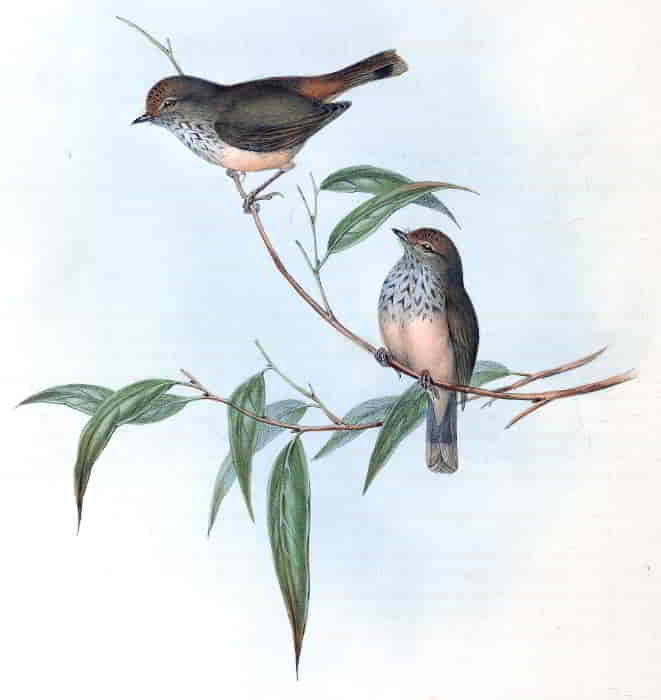
ACANTHIZA PUSILLA.
J. Gould and H. C. Richter del et lith. Hullmandel & Walton Imp.
ACANTHIZA PUSILLA.
Little Brown Acanthiza.
Sylvia pusilla, Lath. Ind. Orn. Supp., p. lvi.
Motacilla pusilla, White’s Journ., pl. in p. 257.
Bec-fin, Temm. Man. d’Orn. 2nd edit., tom. i. p. lxviii.
Dwarf Warbler, Lath. Gen. Syn. Supp., vol. ii. p. 251.—Shaw, Gen. Zool., vol. x. p. 647.—Lath. Gen. Hist., vol. vii. p. 134.
Acanthiza pusilla, Vig. & Horsf. in Linn. Trans., vol. xv. p. 227, note.
The present bird is very generally dispersed over New South Wales, where it inhabits the brushes, thickets and gardens. It is most nearly allied to the A. Diemenensis, but may be distinguished from that species by its more diminutive size, by its much shorter bill and smaller tail. It is an active prying little bird, and spends much of its time amid the smaller leafy branches of the trees, from among which it collects its insect food: the tail is generally carried above the line of the body. The nest is of a dome-shaped form and is constructed of fine dried grasses and hairy fibres of bark, intermingled and bound together with the hairy cocoons of a species of Lepidopterous insect, and lined with feathers. The eggs are four or five in number, of a beautiful pearly white, sprinkled and spotted with fine specks of reddish brown, forming in some instances a zone near the larger end; their medium length is eight lines and a half by six lines in breadth.
The sexes are so precisely similar in outward appearance, that dissection must be resorted to to distinguish the one from the other.
Forehead buff, each feather edged with brown; all the upper surface and wings brown, tinged with olive; tail reddish olive, crossed near the tip by a narrow band of black; throat and chest greyish white, each feather margined with black, giving that part a mottled appearance; flanks, abdomen and under tail-coverts buff; irides brownish red; bill dark brown; feet brown.
The Plate represents two individuals of the natural size.
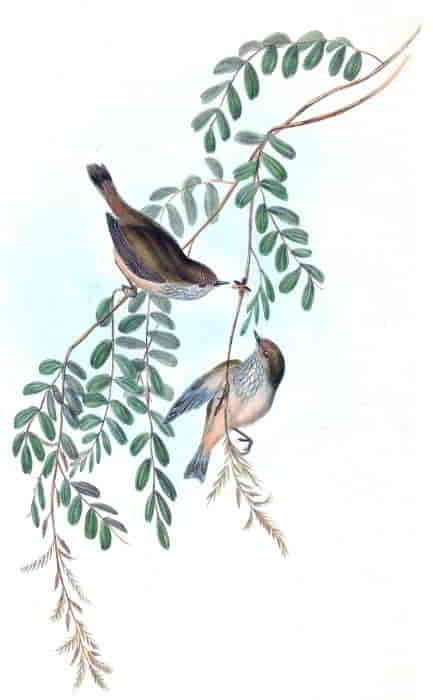
ACANTHIZA DIEMENENSIS: Gould.
J. Gould and H. C. Richter del et lith. C. Hullmandel Imp.
ACANTHIZA DIEMENENSIS, Gould.
Tasmanian Acanthiza.
Acanthiza Diemenensis, Gould in Proc. of Zool. Soc., Part V. p. 146; and in Syn. Birds of Australia, Part IV.
Brown-tail, Colonists of Van Diemen’s Land.
I believe this species, like the Acanthiza Ewingii, to be peculiar to Van Diemen’s Land, over the whole of which country it is rather numerously dispersed, and where it inhabits forests and open woodlands, but evinces a preference to low and shrub-like trees rather than to those of a higher growth. It also frequents the gardens and shrubberies of the colonists; it is consequently one of the commonest and one of the best known birds of the island. Active and sprightly in its actions, it prys about the foliage with the most scrutinizing care in search of insects and their larvæ, which constitute its sole food. It frequently utters a rather loud harsh note, which is sometimes changed for a more full and clear strain; still its vocal powers are by no means conspicuous. It has a much more lengthened bill, and is altogether a larger bird than the Acanthiza pusilla, whose habitat seems restricted to the south-eastern portion of the Australian continent. The plumage of the sexes is alike, and their size and general appearance so similar, that without the aid of dissection it is impossible to distinguish them. The nest of this little bird, which is usually built in a low shrub, is rather a dense structure, being formed of grasses, fibrous roots and the inner bark of trees, warmly lined with feathers; it is of a globular form, with a small hole in the side near the top for an entrance, and is very similar in appearance to that of the Common Wren, Troglodytes Europæus. The eggs are four or five in number, of a beautiful pearly bluish white, sprinkled and spotted with reddish brown. In some instances the spots form a zone round the larger end. The medium length of the eggs is eight lines and a half, and breadth six lines.
Independently of the task of incubating its own offspring, this species very frequently has to perform the additional labour of hatching and rearing the young of the Bronze Cuckoo (Chalcites lucidus), whose single egg or young is often found in the nest. It is a very early breeder, commencing in August and continuing until January, during which period two or three broods are generally reared by each pair.
Forehead rufous brown, each feather with a crescent-shaped mark of bright buff near its extremity and tipped with blackish brown; all the upper surface and wings deep olive-brown; upper tail-coverts reddish brown; tail olive-brown, crossed by a band of blackish brown; cheeks, throat and chest greyish white, each feather margined with a broken line of deep brown; abdomen and under tail-coverts greyish white, tinged with rufous, which is deepest on the flanks and under tail-coverts; bill dark brown; irides lake-red; feet brown.
The Plate represents the two sexes of the natural size.
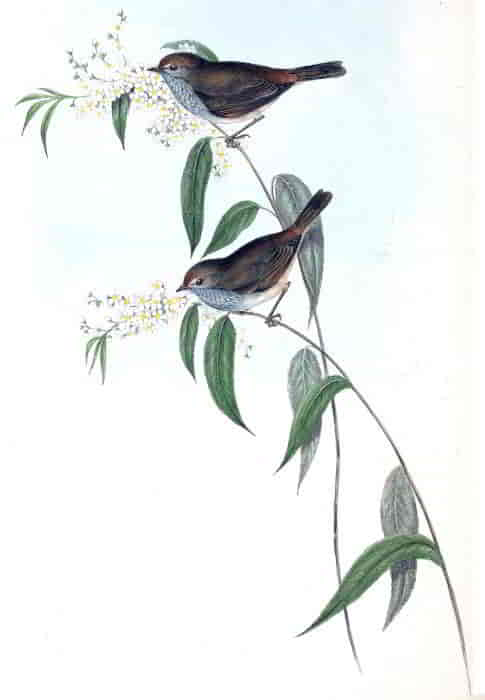
ACANTHIZA EWINGII: Gould.
J. Gould and H. C. Richter del et lith. C. Hullmandel Imp.
ACANTHIZA EWINGII, Gould.
Ewing’s Acanthiza.
Acanthiza Ewingii, Gould in Proc. of Zool. Soc., August 13, 1844.
This species of Acanthiza is a native of Van Diemen’s Land, and has been named after the Reverend Thomas James Ewing, a gentleman ardently attached to the study of Natural History, and a sincere friend to all who have the advantage of his acquaintance. That there were two nearly allied species of this genus inhabiting Van Diemen’s Land was an opinion I had entertained before my visit to that country, and I have since ascertained that this opinion was a correct one, although I did not reside there long enough to ascertain what difference may exist in the habits and economy of the two birds.
The Acanthiza Ewingii is more elegant in all its proportions than its near ally, the Acanthiza Diemenensis, for although it is a smaller bird, its tarsi are longer and more slender. There is also a rich brown mark at the base of the primaries of A. Ewingii, which does not occur in any other known species; the markings of the breast also are more indistinct and clouded with blue-grey, while in A. Diemenensis this part of the plumage is lighter and more inclined to brown. I have never seen this little bird on the continent of Australia, and I believe that it never occurs there.
Crown of the head light brown; all the upper surface brownish olive; wings dark brown; primaries margined at the base with sandy buff; tail rich brown, crossed by a broad band of black near the tip; the lateral feathers tipped with white; throat speckled black and white; under surface pale olive; irides dark brown; bill and feet brown.
The Plate represents the two sexes of the natural size.
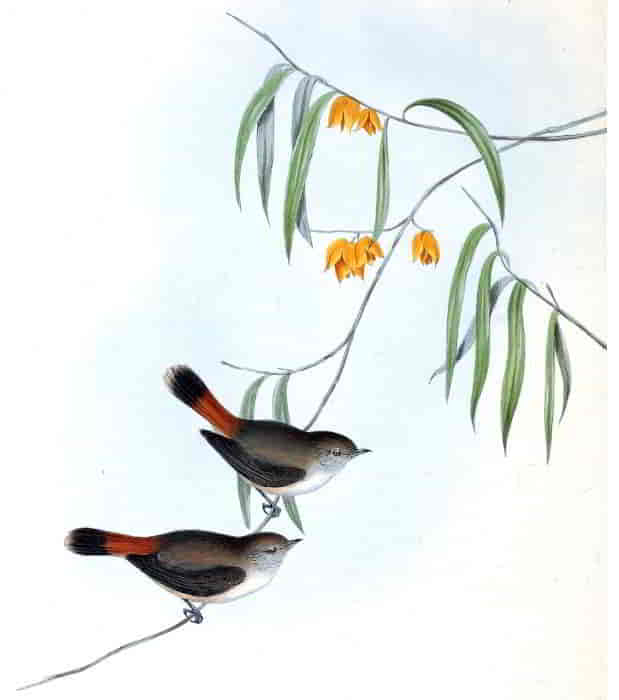
ACANTHIZA UROPYGIALIS: Gould.
J. Gould and H. C. Richter del et lith. Hullmandel & Walton Imp.
ACANTHIZA UROPYGIALIS, Gould.
Chestnut-rumped Acanthiza.
Acanthiza uropygialis, Gould in Proc. of Zool. Soc., Part V. p. 146; and in Syn. Birds of Australia, Part IV.
I received this new and well-marked species from New South Wales, with the belief that it had been collected either on the Liverpool Plains or the country immediately to the northward of them; but as there is some degree of uncertainty as to the locality in which it was procured, a knowledge of its true habitat would be very desirable, and I should have been happy to have cleared up this point had it been in my power so to do.
The chestnut colour pervading the basal half of the tail and the tail-coverts forms a very conspicuous mark, and presents a strong contrast to the remainder of the plumage. That its habits, actions and economy are very similar to those of the other members of the genus there can be no doubt, but on these points also I am compelled to silence, no notes of any kind having been sent with the specimens.
Head, upper surface and wings brown, slightly tinged with olive; the feather on the forehead tipped with a lighter colour; rump and upper tail-coverts rich reddish chestnut; tail-feathers brownish black, largely tipped with white, which on the two centre feathers is tinged with brown; throat, chest, and centre of the abdomen greyish white; flanks and under tail-coverts buffy white; bill and feet black.
The Plate represents the bird, which I believe to be a male, in two different positions.
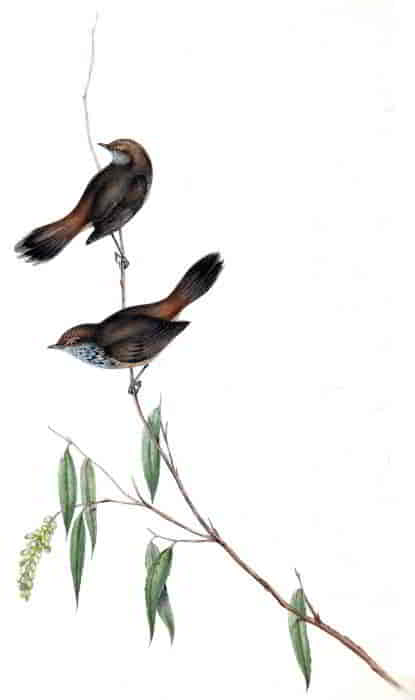
ACANTHIZA APICALIS: Gould.
J. Gould and H. C. Richter del et lith. Hullmandel & Walton Imp.
ACANTHIZA APICALIS, Gould.
Western Acanthiza.
Acanthiza apicalis, Gould in Proc. of Zool. Soc., March, 1847.
Djool-be-djoȍl-bung, Aborigines of the lowland districts of Western Australia.
Wren, Colonists of Swan River.
This species, which is a native of Western Australia, is distinguished from those immediately allied to it—A. Diemenensis, pusilla and Ewingii—by its large size, by its larger and rounder tail, by the broad and distinct band of black which crosses the tail-feathers near their extremities, and by their being largely tipped with white.
It occurs in great abundance in the colony of Western Australia, both at Swan River and King George’s Sound, and is to be met with in all wooded situations. Like the other members of the genus, it is active and sprightly in its actions, leaping about from branch to branch with its tail erect, and often repeating a note which very much resembles the syllables Gee-wo-wut. Its stomach is somewhat muscular, and the food consists of small insects of various kinds.
It breeds in September and October. The nest, which is usually placed in a thickly-foliaged bush, or in a clump of the Tea-tree, is of a domed form, with the entrance in the side, and is composed of dried grasses and strips of Tea-tree bark, and lined with feathers. The eggs are from three to five in number, of a flesh-white, thickly freckled with reddish chestnut, the freckles becoming so numerous at the larger end as to form a complete zone; their medium length is eight lines, and breadth six lines.
The sexes are alike in plumage, but the female is somewhat smaller than her mate.
Feathers of the forehead deep buff, edged with dark brown; all the upper surface, wings and tail light olive-brown; tail crossed with a broad and distinct band of brownish black near the extremity, and largely tipped with white; upper tail-coverts tinged with rufous; throat and chest greyish tail-coverts pale buff; white, each feather margined with black, giving that part a mottled appearance; flanks, abdomen and under irides light red; bill, legs and feet dark brown.
The figures are of the natural size.
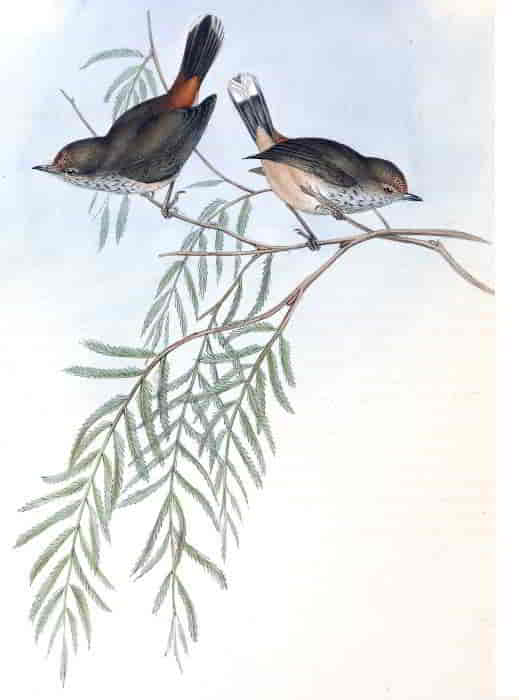
ACANTHIZA PYRRHOPYGIA: Gould.
J. Gould and H. C. Richter del et lith. Hullmandel & Walton Imp.
ACANTHIZA PYRRHOPYGIA, Gould.
Red-rumped Acanthiza.
Acanthiza pyrrhopygia, Gould in Proc. of Zool. Soc., 1847.
This species differs from the Acanthizæ Diemenensis, pusilla, Ewingii, and apicalis, in having a shorter and more robust bill, and in the greater depth of the red colouring on the rump and upper tail-coverts; it also differs from the three former in having the tail tipped with white, in which respect it assimilates to the A. apicalis and A. uropygialis, to the former of which it is most nearly allied.
I discovered this species in the Belts of the Murray, where it inhabits the small shrubby trees; upon first seeing it, I at once perceived that it was a distinct species by the red colouring of the rump, which showed very conspicuously at the distance of several yards, and also by the peculiarity of its note. In its actions it very closely assimilates to the other members of the genus, being an alert and quick little bird, carrying its tail above the level of the back, and showing the red colouring of the coverts to the greatest advantage. I succeeded in killing both sexes, and found that they exhibit no outward difference, and are only to be distinguished with certainty by dissection.
All the upper surface and wings olive-brown, the feathers of the forehead margined with buff; wings brown with pale edges; throat white, each feather margined with black; abdomen whitish; flanks pale buff; upper tail-coverts rufous; tail olive, crossed by a broad band of black, and tipped on the outer webs with pale olive, on the inner webs with white; bill blackish brown, under mandible somewhat lighter; feet brown; irides reddish brown.
The figures are of the natural size.
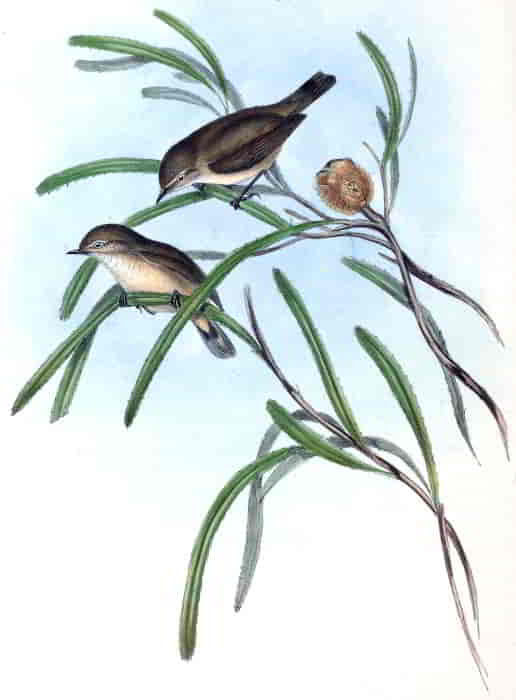
ACANTHIZA INORNATA: Gould.
J. Gould and H. C. Richter del et lith. Hullmandel & Walton Imp.
ACANTHIZA INORNATA, Gould.
Plain-coloured Acanthiza.
Acanthiza inornata, Gould in Proc. of Zool. Soc., Part VIII. p. 171.
Djo-b̏ul-djo-b̏ul, Aborigines of the lowland districts of Western Australia.
Although neither elegant in form nor characterized by any beauty of plumage, the present little bird demands as much of our attention as any other species of the group. Its true habitat seems to be the south-western parts of Australia, for it is numerously dispersed over the colony of Swan River; it is equally abundant at King George’s Sound; and as I killed specimens on the small low islands at the mouths of Spencer’s and St. Vincent’s Gulfs, it is most probable that its range extends all along the coast between those localities. Independently of its plainer colouring, the truncated form of its tail serves at once to distinguish it from the Acanthiza apicalis, with which it is often seen in company; unlike the latter bird however it does not erect its tail, but carries it in a line with the body.
Its note is a little feeble song somewhat resembling that of the Maluri. It feeds solely on minute insects of various kinds, in searching for which it assumes the usual clinging and prying positions of other insectivorous birds which seek their food among the leaves and branches of shrubs and trees.
It breeds in November; the nest, which is of a domed form, being placed in some low shrub, often in that of the jam-wood, and composed of grasses lined with a few feathers.
The eggs are five in number, and of a white colour, slightly tinged with greenish grey; they measure seven and a half lines long by five and a half lines broad.
No visible difference is observable in the outward appearance of the sexes.
All the upper surface, wings and tail olive-brown; primaries dark brown; tail crossed by a broad band of brownish black; all the under surface light buff; irides greenish white; bill and feet black.
The figures are those of a male and a female of the natural size.
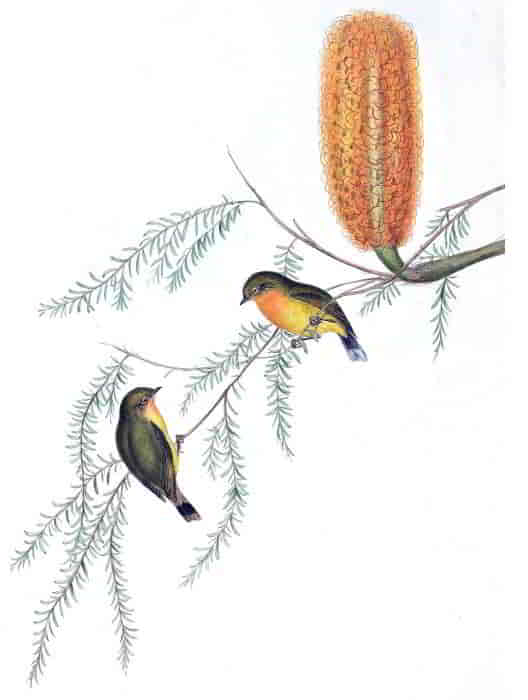
ACANTHIZA NANA: Vig. & Horsf.
J. Gould and H. C. Richter del et lith. Hullmandel & Walton Imp.
ACANTHIZA NANA, Vig. & Horsf.
Little Acanthiza.
Dwarf Warbler, var. A.? Lath. Gen. Hist., vol. vii. p. 134. No. 161.
Acanthiza nana, Vig. & Horsf. in Linn. Trans., vol. xv. p. 226.—Less. Man. d’Orn., tom. i. p. 283.
This little bird, which is very generally distributed over the colonies of New South Wales and South Australia, inhabits the extremities of the branches of the various trees, without, so far as I could observe, evincing a partiality for any particular kind; the Casuarinæ on the banks of creeks, the Eucalypti of the plains, and the belts of Banksiæ being equally resorted to by it. Insects of various orders constitute its sole food, and in the capture of these it exhibited many lively and varied actions, which strongly reminded me of those of the Regulus cristatus of our own island: that, like its near allies, it may occasionally resort to the ground for food, I think very likely, yet I do not recollect having seen it in such situations.
The nest is a neat domed structure with a small entrance near the top, and is composed of fine grasses; its site varies according to circumstances, but is generally among the smaller branches of the trees. The number and colour of its eggs are at present unknown.
As its name implies, and as will be seen on reference to the Plate, the Acanthiza nana is one of the more diminutive, although not the least of the Australian birds.
There is no outward difference by which the sexes can be distinguished, neither do they undergo any seasonal change, nor is there any great variation in the colouring of the young and the adult.
All the upper surface bright olive; tail greyish brown tinged with olive, and crossed by a broad band of blackish brown; throat and under surface yellow; irides brown with a very narrow rim of yellowish white; bill and feet blackish brown.
The figures are of the natural size.
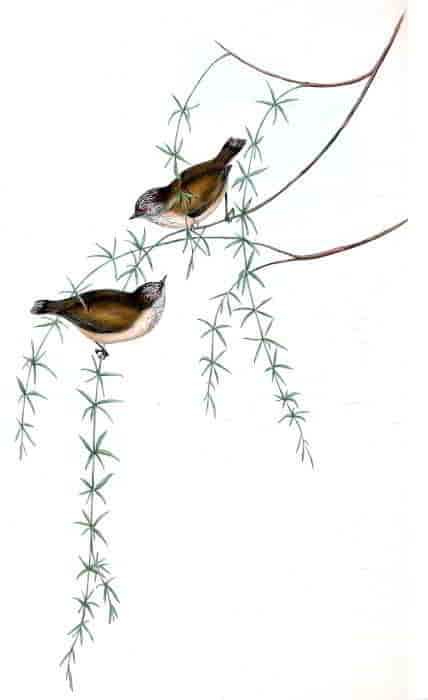
ACANTHIZA LINEATA: Gould.
J. Gould and H. C. Richter del et lith. Hullmandel & Walton Imp.
ACANTHIZA LINEATA, Gould.
Striated Acanthiza.
Acanthiza lineata, Gould in Proc. of Zool. Soc., Part V. p. 146; and in Syn. Birds of Australia, Part IV.
This pretty little species inhabits most of the wooded districts of South Australia, particularly the gullies among the mountain ranges; it is also tolerably abundant among the brushes and trees near the brooks and rivulets of the Liverpool range in New South Wales. It is very active and animated in its actions, clinging and prying about among the branches in search of insects in every possible variety of position. It is a permanent resident in the countries above mentioned, but is not found in Van Diemen’s Land or Western Australia. Unfortunately I did not succeed in procuring its nest, but judging from those of the other members of the genus, it is doubtless of a domed form, with a small hole near the top for an entrance; and though I have never seen the eggs, it may be presumed from analogy that they are either purely white, or white speckled with reddish brown.
Its food consists entirely of insects, which are procured from the leaves and flowers of the various trees.
The sexes can only be distinguished by dissection, for no perceptible difference whatever is observable either in their size or the colouring of their plumage.
This species, the least of the genus to which it belongs, and one of the most diminutive of the Australian birds, may be thus described:—
Crown of the head brownish olive, with a fine line of white down the centre of each feather; back and wings greenish olive; tail the same, crossed by a broad band of brownish black near the tip, beyond which the extremities are brownish grey; throat and chest grey, tinged with olive, the margins of the feathers spotted with dark brown, giving these parts an irregular spotted appearance; bill and feet black; irides brown.
The Plate represents the two sexes of the natural size.
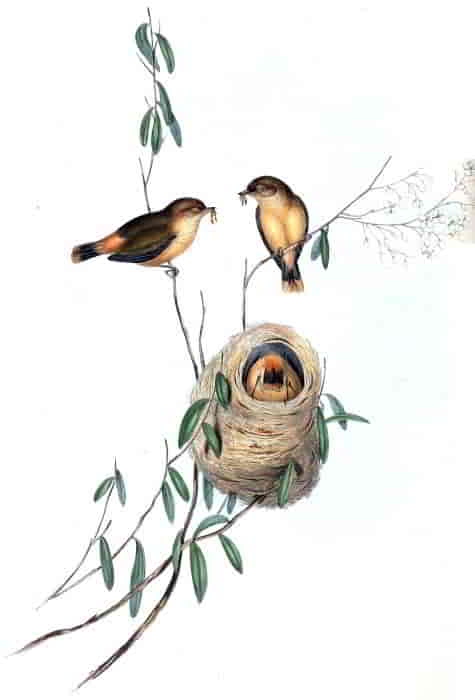
ACANTHIZA REGULOÏDES: Vig. & Horsf.
J. Gould and H. C. Richter del et lith. Hullmandel & Walton Imp.
ACANTHIZA REGULOIDES, Vig. & Horsf.
Regulus-like Acanthiza.
Acanthiza Reguloides, Vig. & Horsf. in Linn. Trans., vol. xv. p. 226.
Dwarf Warbler, var. β? Lath. Gen. Hist., vol. vii. p. 135. No. 161.—Less. Man. d’Orn., tom. i. p. 283.
Many of the actions of this little bird offer a close resemblance to those of the Yellow-tailed Acanthiza (A. chrysorrhœa); like that species, it resorts to the ground for its food; moves about in small flocks of from eight to fifteen in number; when flushed shows the yellow or buff of the rump very conspicuously; always spreads its tail while flying; flits along with a jerking motion, and is very tame. It is extremely common in South Australia, where I observed it in every part of the country I visited, and in New South Wales I even found it in the interior beyond the ranges, and also on the bare ridges between Patrick’s Plains and the Liverpool range. I did not meet with it in Van Diemen’s Land. It evinces a decided preference for the open country or hills slightly covered with brush, where it can feed on the ground and fly to the low shrub-like trees when disturbed; I have also seen it busily engaged among the branches, apparently in search of insects, in the pursuit of which, like the other members of the genus, it displays unusual alertness and address.
Its domed nest is placed among the foliage of the gum, swamp oak and other trees, and is composed of fine grasses interwoven with cobwebs and slightly lined with feathers. The breeding-season comprises the months of September, October and November, and the eggs are four in number.
Crown, back of the neck, upper surface and wings olive-brown, the feathers of the forehead tipped with a lighter colour; rump, upper and under tail-coverts pale ochre; throat and chest white, each feather with a very slight, broken margin of brown; base of all the tail-feathers pale buff, the external margin of the outer feathers and the tips of all brownish buff, the central portion blackish brown; bill brown, the under mandible paler than the upper; feet olive-brown; irides beautiful straw-yellow.
The Plate represents the two sexes of the natural size.
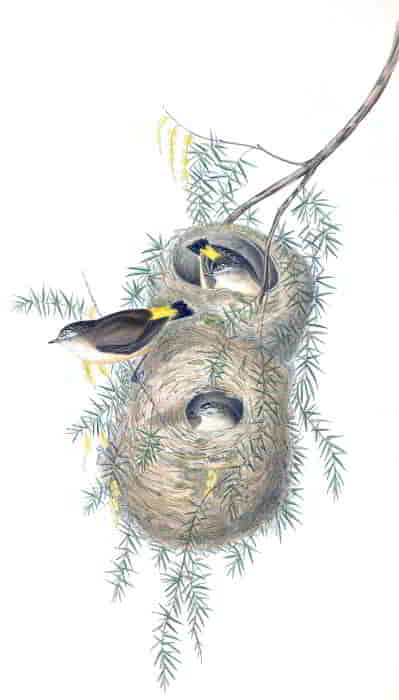
ACANTHIZA CHRYSORRHŒA.
J. Gould and H. C. Richter del et lith. C. Hullmandel Imp.
ACANTHIZA CHRYSORRHŒA.
Yellow-tailed Acanthiza.
Saxicola chrysorrhœa, Quoy and Gaim., Voy. de l’Astrolabe, p. 198. pl. 10. fig. 2.
Acanthiza chrysorrhœa, Gould, Syn. Birds of Australia, Part IV.
Jeȅ-da, Aborigines of the lowland districts of Western Australia.
This well-known species of Acanthiza inhabits Van Diemen’s Land, Western and Southern Australia and New South Wales, in all of which countries it is a permanent resident. It is generally met with in small companies of from six to ten in number, and is so tame that it may be very closely approached before it will rise, and it then merely flies off to a short distance and alights again; during these short flights the yellow of the rump shows very conspicuously.
It commences breeding very early, and rears at least three broods a year. The nest is somewhat carelessly constructed of leaves, grasses, wool, &c., and is of a domed form, with a small hole for an entrance. It would seem that the same nest is resorted to for several succeeding years; but the most curious feature connected with it is, that a small cup-shaped depression or second nest, as it were, is frequently formed on the top or side of the other, and which is said to be either the roosting-place of the male, or where he may sit in order to be in company with the female during the task of nidification. I have myself found many of these double nests, but have not had opportunities for satisfactorily ascertaining the use of the upper one. The bird very readily resorts to the gardens of the settler, and constructs its curious nest in any low shrub. In Van Diemen’s Land one of the trees most frequently selected for the purpose is the prickly Mimosa: in Western Australia it is frequently suspended from the overhanging branches of the Xanthorrhœa, and in the district of the Upper Hunter upon the apple-trees (Angophoræ). The nest varies very much in size, being in some instances considerably larger than the one figured. The eggs are generally of a beautiful uniform flesh-colour, but occasionally they are found sprinkled over with very minute specks of reddish yellow, which in some instances form a zone at the larger end; they are four or five in number, their medium length being nine lines and breadth six lines.
This is one of the species to which the Bronze Cuckoo (Chalcites lucidus) delegates the task of rearing its young. I have several times taken the egg of the cuckoo from the nest of this bird and also the young, in which latter case the parasitical bird was the sole occupant.
The song of the Acanthiza chrysorrhœa is extremely pretty, many of its notes closely resembling those of the Goldfinch of Europe (Carduelis elegans). Its food consists of small coleopterous and other kinds of insects.
The sexes are alike in plumage, and may be thus described:—
Forehead black, with a spot of white at the tip of each feather; cheeks, throat, and a line from the nostrils over each eye greyish white; chest and under surface yellowish white, passing into light olive-brown on the flanks; upper surface and wings olive-brown; rump and upper tail-coverts bright citron-yellow; base of the tail-feathers white, tinged with yellow; the external margin of the outer feathers and the tips of all brownish grey, the central portion blackish brown; bill and feet blackish brown; irides very light grey.
The Plate represents a nest and a male and female of the natural size.
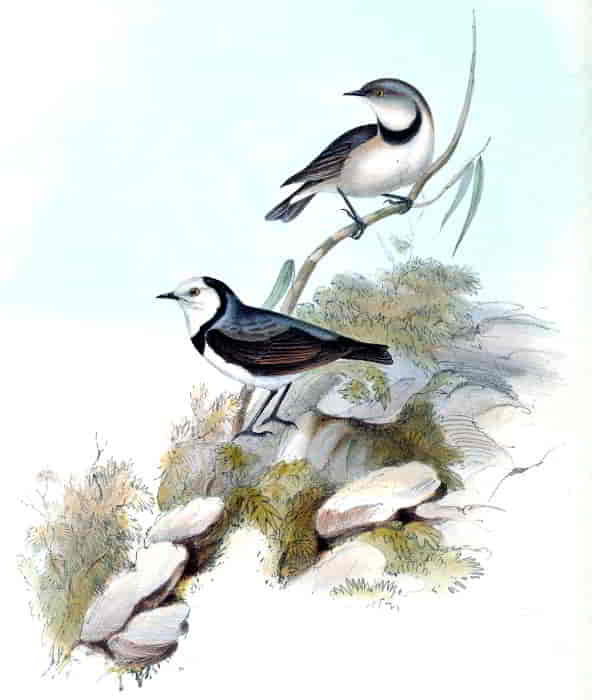
EPTHIANURA ALBIFRONS: Gould.
J. & E. Gould del et lith. C. Hullmandel Imp.
EPTHIANURA ALBIFRONS.
White-fronted Epthianura.
Acanthiza albifrons, Jard. and Selb. Ill. Orn., vol. ii. pl. 56. figs. 1 and 2.
I first met with this species in a state of nature on the small islands in Bass’s Straits, where it had evidently been breeding, as I observed several old nests in the Barilla and other stunted bushes which clothe those isolated spots, particularly Chalky and Green Islands, immediately contiguous to Flinders. I did not observe it in Van Diemen’s Land or to the southward of the localities above mentioned. It would appear that it extends over the whole of the southern portion of the Australian continent, as I have specimens in my collection which were killed at Swan River, in South Australia, and in New South Wales: the extent of its range northwards is not known; I have never yet seen examples from the north coast.
It is a most sprightly and active little bird, particularly the male, whose white throat and banded chest render him much more conspicuous than the sombre-coloured female. As the structure of its toes and lengthened tertiaries would lead us to expect, its natural province is the ground, to which it habitually resorts, and decidedly evinces a preference to spots of a sterile and barren character. The male, like many of the Saxicoline birds, frequently perches either on the summit of a stone, or on the extremity of a dead and leafless branch. It is rather shy in its disposition, and when disturbed flies off with considerable rapidity to the distance of two or three hundred yards before it alights again. I observed it in small companies on the plains near Adelaide, over the hard clayey surface of which it tripped with amazing quickness, with a motion that can neither be described as a hop or a run, but something between the two, accompanied by a bobbing action of the tail.
Of its nidification, I regret to say, nothing is at present known.
The male has the forehead, face, throat and all the under surface pure white; occiput black; chest crossed by a broad crescent of deep black, the points of which run up the sides of the neck and join the black of the occiput; upper surface dark grey, with a patch of dark brown in the centre of each feather; wings dark brown; upper tail-coverts black; two centre tail-feathers dark brown; the remainder dark brown, with a large oblong patch of white on the inner web at the tip; irides, in some, beautiful reddish buff, in others yellow with a slight tinge of red on the outer edge of the pupil; bill and feet black.
The female has the crown of the head, all the upper surface, wings and tail greyish brown, with a slight indication of the oblong white spot on the inner webs of the latter; throat and under surface buffy white; and a slight crescent of black on the chest.
The figures are of the natural size.
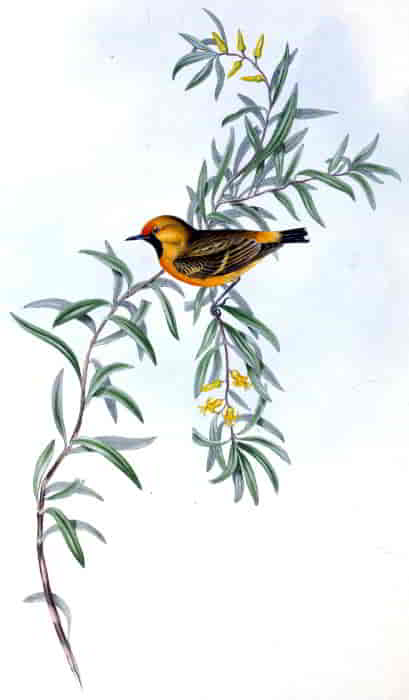
EPTHIANURA AURIFRONS: Gould.
J. Gould and H. C. Richter lithog. C. Hullmandel Imp.
EPTHIANURA AURIFRONS, Gould.
Orange-fronted Epthianura.
Epthianura aurifrons, Gould in Proc. of Zool. Soc., Part V. p. 148; and in Syn. Birds of Australia, Part IV.
As long since as the year 1837 I had the pleasure of characterizing this species at one of the scientific meetings of the Zoological Society of London, from a specimen which had been presented to the Society’s collection by Lieut. Breton, R.N., a gentleman much attached to zoological science, as exemplified by his numerous donations to that Society, and in his “Excursions in New South Wales, Western Australia and Van Diemen’s Land.”
The Orange-fronted Epthianura must be regarded as a bird of the greatest rarity, for the specimen above mentioned is the only one that has ever come under my notice, and in all probability it is quite unique; hence this is another of the birds to which I would wish to direct the attention of residents in New South Wales, particularly those who have an opportunity of visiting the locality in which it was seen by Lieut. Breton, who, when speaking of Gammon Plains, New South Wales, in the work above mentioned, says “we shot also some Platypi, and a small bird like a Mule Canary (a species of Saxicola); this last is exceedingly rare in the colony, and I am not aware that any other person possesses a specimen; there were only three together, and the natives said they had never seen any before.”
In the lengthened wing, largely developed tertiaries, and in the square form of the tail, it offers a greater alliance to Epthianura than to any other genus, and there I have provisionally placed it; future research, however, and a knowledge of its habits and nidification, will determine the justice of this opinion, or the propriety of separating it into a distinct genus.
Head, upper tail-coverts, sides of the neck, breast and all the under surface fine golden orange, which is richest on the forehead and centre of the abdomen; back olive; wings brown, margined with olive; tail brownish black, each feather except the two middle ones having an oval spot of white on the inner web at the tip; chin and centre of the throat black; bill black; feet brown.
The figure is of the natural size.
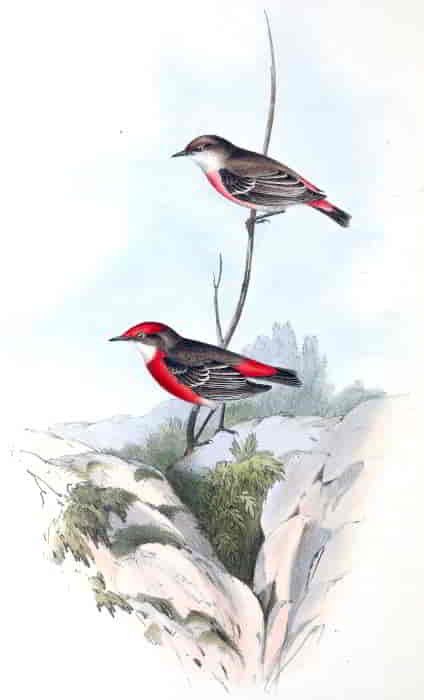
EPTHIANURA TRICOLOR: Gould.
J. & E. Gould del et lith. C. Hullmandel Imp.
EPTHIANURA TRICOLOR, Gould.
Tri-coloured Epthianura.
Epthianura tricolor, Gould in Proc. of Zool. Soc., Part VIII. p. 159.
While traversing, soon after sunrise on the 11th of December 1839, the forest lands near Peel’s River to the eastward of Liverpool Plains, a fine male specimen of this bird attracted my notice by the beauty of its colouring and the sprightliness and activity of its actions, while busily engaged in capturing the small insects that were hovering in the air near the ground. As maybe supposed, the sight of a bird of such beauty, and which, moreover, was entirely new to me, excited so strong a desire to possess it that scarcely a moment elapsed before it was dead and in my hand; I regret to add, however, that neither my travelling companion Natty nor any other person could give me any account of it, since, like myself, they had never seen it before; nor could I during my residence in the colony either see another example or obtain any information on the subject. In a small collection procured for me in South Australia by an intelligent and enthusiastic collector, Mr. Strange, two other specimens occurred which I supposed to be male and female; unfortunately in this instance also they were unaccompanied by any notes of their habits or economy; which are yet to be ascertained, the species being doubtless migratory, and the specimens sent rare visitors from the interior to the part of the country where they were killed; any information respecting this rara avis would therefore be very acceptable.
The male has the crown of the head, upper tail-coverts, breast and abdomen bright scarlet; lores, line above and beneath the eye, ear-coverts, occiput and back dark brown; wings brown, each feather margined with brownish white; tail dark brown, each feather having a large spot of white on the inner web at the tip; chin, throat and under tail-coverts white; irides straw white; bill and feet blackish brown.
The female is similar in colour, but has only a slight wash of the scarlet colouring, except on the upper tail-coverts, where it is as brilliant as in the male.
The figures are of the natural size.
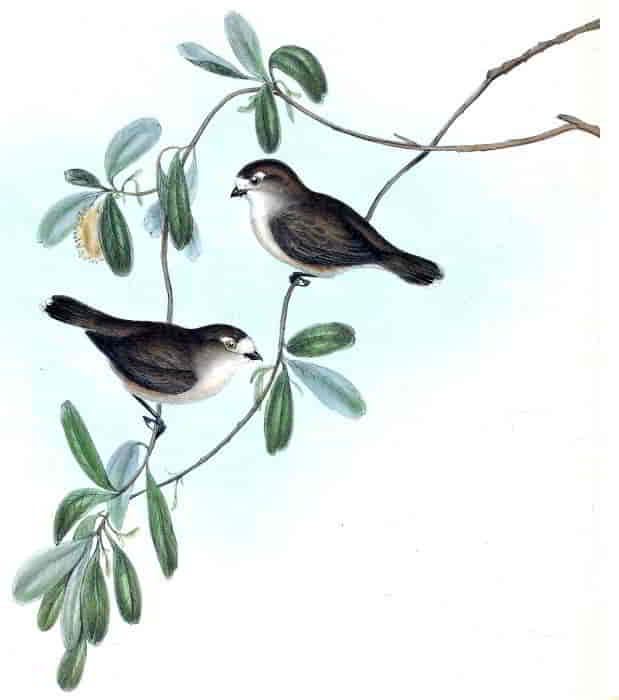
XEROPHILA LEUCOPSIS: Gould.
J. Gould and H. C. Richter del et lith. C. Hullmandel Imp.
XEROPHILA LEUCOPSIS, Gould.
White-faced Xerophila.
Xerophila leucopsis, Gould in Proc. of Zool. Soc., Part VIII. p. 175.
As an instance how objects which are rare or from remote localities receive a greater share of attention than those with which we are familiar, I may state that while collections of birds have been transmitted to Europe from the most distant parts of the new colony of South Australia, the present little bird, which inhabits the very streets and gardens of Adelaide, like the sparrow in the towns of Europe, had been up to the period of my visit utterly disregarded; it was too common to be considered worthy of notice. Immediately on my arrival, however, in fact on my way to pay my respects to the Governor, Colonel Gawler, I observed it hopping about the street in numbers, and almost on the very door-step of his Excellency’s residence. Upon my calling his attention to the subject and informing him that it was a bird entirely new to science, he at once gave orders that some specimens should be captured alive, so that when I paid my second visit in the evening this undescribed species was a captive in a cage, by which means I was enabled to examine it more closely than I had before been able to do. I afterwards found it to be tolerably abundant in all parts of the colony I visited, both in the interior and in the neighbourhood of the coast. It was generally met with in small flocks of from six to sixteen in number, and more frequently on the ground than among the trees. It hops over the ground very quickly and appears a busy little bird, prying among the herbage for its food, which principally consists of the seeds of the grasses and small annuals which abound on the plains and low hills of South Australia. In disposition it is so remarkably tame that it will allow of a very near approach before it will rise, and then it merely flies to the nearest bush or low tree.
The male offers no external difference by which it can be distinguished from the female, neither do the young exhibit any contrast to the adults in their plumage; it has in fact little to recommend it to the notice of the general observer either in its colouring or in the quality of its song.
The nest which was kindly forwarded to me by Mr. Strange is of rather a large size, of a domed form, with a hole for an entrance very near the top, and is composed of dried grasses, moss, spiders’ webs, wool, the soft blossoms of plants and dead leaves matted together and warmly lined with feathers; it is about seven inches in height and four inches in diameter. The eggs received with the nest were three in number, of a fleshy white, eight and a half lines long and six lines broad.
Forehead and lores white; upper surface olive-brown; wings and tail brown, the latter passing into black near the extremity, and tipped with white; all the under surface pale buff; bill and feet black; irides light straw-colour.
The Plate represents the male and female of the natural size.
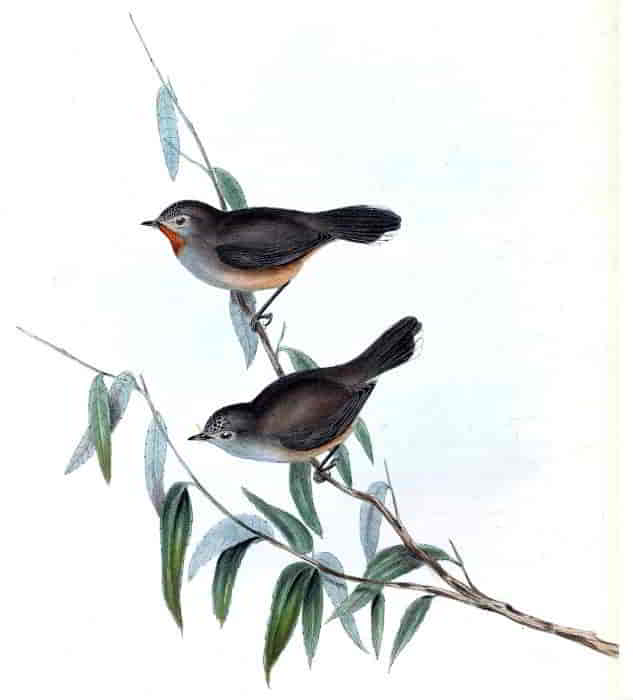
PYRRHOLÆMUS BRUNNEUS: Gould.
J. Gould and H. C. Richter del et lith. C. Hullmandel Imp.
PYRRHOLÆMUS BRUNNEUS, Gould.
Brown Red-Throat.
Pyrrholæmus brunneus, Gould in Proc. of Zool. Soc., Part VIII. p. 173.
Beȑ-rit-beȑ-rit, Aborigines of the mountain districts of Western Australia.
I found this new bird tolerably abundant in the Belts of the Murray, about forty miles to the northward of Lake Alexandrina, where it gave a decided preference to low stunted bushes and fallen trunks of trees overgrown with herbage, under which it secreted itself; it sometimes rose to the top of a bush to sing, pouring forth a melody equal to any of the smaller birds of Australia, which must render it a general favourite when that portion of the country becomes colonized. It passes much of its time on the ground, hopping about with great celerity, and with its tail elevated considerably above the level of its back.
Since I killed my specimens it has been obtained by Mr. Gilbert in Western Australia, from whose notes I learn that it is there an inhabitant of the underwood and the thickest scrub; and that “it possesses a very sweet and melodious song, which it generally utters while perched on the extreme topmost branch of a small scrubby tree, and having repeated it two or three times, dives down into the impenetrable bush. While feeding it utters a weak, piping, call-like note. I never saw it fairly on the wing, for it seems averse to flying, but generally prefers creeping from bush to bush, and even if closely hunted merely flits a few yards. It makes its nest on the ground, precisely like the members of the genus Calamanthus. I found a pair building in the month of September; upon visiting the spot again after an interval of a week, the nest appeared finished, being lined with feathers, but there were no eggs; unfortunately from this time the birds deserted the nest; but Mr. Drummond tells me that he once saw the eggs, that they were three in number and of a green colour.”
Lores greyish white; all the upper surface and wings brown; tail brownish black, the three lateral feathers on each side largely tipped with white; centre of the throat rufous; the remainder of the under surface brownish grey, passing into sandy buff on the flanks and under tail-coverts; irides reddish brown, with an outer ring of yellowish white; upper mandible reddish brown; lower mandible greenish white; legs and feet dark greenish grey.
The figures represent the two sexes of the natural size.
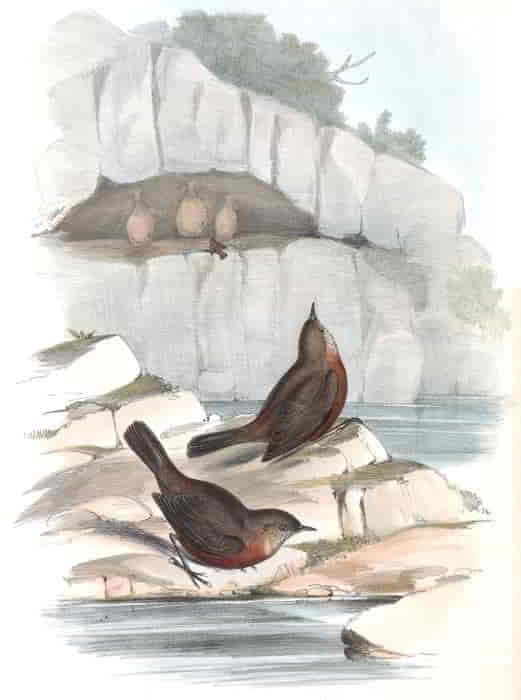
ORIGMA RUBRICATA.
J. Gould and H. C. Richter del et lith. Hullmandel & Walton Imp.
ORIGMA RUBRICATA.
Rock-Warbler.
Sylvia rubricata, Lath. Ind. Orn. Supp., p. li.—Bonn. et Vieill. Ency. Méth. Orn., part ii. p. 461.
Ruddy Warbler, Lath. Gen. Syn. Supp., vol. ii. p. 249.—Shaw, Gen. Zool., vol. x. p. 697.—Lath. Gen. Hist., vol. vii. p. 138.
Motacilla solitaria, Lewin, Birds of New Holl., pl. 16.
Solitary Flycatcher, Lath. Gen. Hist., vol. vi. p. 220.
Saxicola solitaria, Vig. & Horsf. in Linn. Trans., vol. xv. p. 236.
Origma solitaria, G. R. Gray, List of Gen. of Birds, 2nd Edit., p. 30.
Perhaps no one of the smaller birds of New South Wales has attracted a greater share of the attention of ornithologists than the present; a desire indeed of gaining a more complete knowledge of its habits and manners has been generally expressed. Aware of this fact, I made myself as much acquainted therewith as circumstances would admit; and found that they are very peculiar, and different from those of most other birds. Its usual places of resort are the neighbourhood of water-courses and stony, rocky gullies; so exclusively in fact is it confined to such situations, that it never visits the forests, nor have I ever seen it perching on the branches of the trees; indeed it would seem to have an aversion to so doing, as it does not even resort to them as a resting-place for its nest, but suspends it to the ceilings of caverns and the under surface of overhanging rocks in a manner that is most surprising; the nest, which is of an oblong, globular form, and composed of moss and other similar substances, is suspended by a narrow neck, and presents one of the most singular instances of bird architecture that has yet come under my notice. The breeding-season extends over the months of September, October and November, when it is not unusual to find three or four nests suspended to the ceiling of a small dark cavern. I did not succeed in procuring its eggs.
Its food consists of insects of various kinds.
Its note is a low, squeaking sound, which it utters while hopping about the rocks with its tail raised above the level of the body, after the manner of some of the Acanthizæ.
The true habitat of this species is New South Wales, which, so far as I am aware, is its exclusive place of abode; I have never seen it from any of the other colonies: over that part of the country it is very generally distributed wherever situations occur suitable to its habits; the rocky beds of the gullies, both near the coast and among the mountains of the interior, being equally frequented by it, but never in any great numbers. It will be seen that it was one of the birds which excited the notice and interest of Mr. Caley, who, in his “Notes,” says, “Cataract Bird; an inhabitant of rocky ground. While at the waterfall of Carrung-gurring, about thirty miles to the southward of Prospect Hill, I saw several of them. I have also seen them in the North Rocks, about a couple of miles from Paramatta, and always upon the rocks. I never observed them in trees or bushes.”
The sexes are precisely similar in their plumage, which may be thus described:—
All the upper surface and wings dull brown; tail brownish black; throat grey; under surface dark rusty red; forehead slightly washed with ferruginous red; irides dark reddish brown; bill and feet brownish black, the former rather lighter than the latter.
The figures are of the natural size.
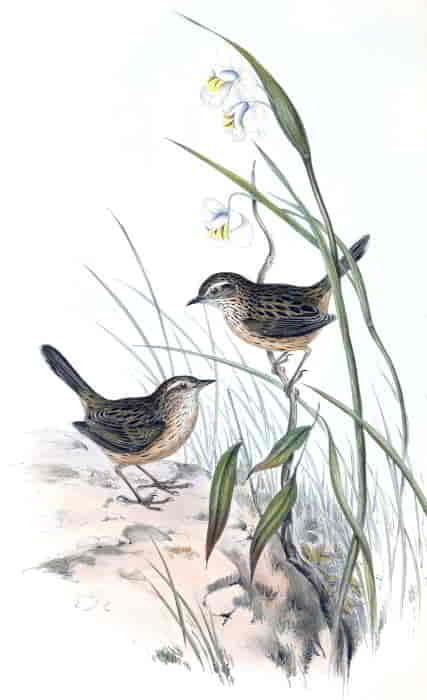
CALAMANTHUS FULIGINOSUS.
J. Gould and H. C. Richter del et lith. C. Hullmandel Imp.
CALAMANTHUS FULIGINOSUS.
Striated Reed-Lark.
Anthus fuliginosus, Vig. & Horsf. in Linn. Trans., vol. xv. p. 230.
Praticola fuliginosa, G. R. Gray, List of Gen. of Birds, 2nd Edit., p. 27.
This species is very generally dispersed over Van Diemen’s Land, where it frequents open forests and sandy land covered with scrub and dwarf shrub-like trees. It carries its tail erect, like the Maluri, but differs from the members of that group in moving that organ in a lateral direction whenever it perches, and at the termination of a succession of hops on the ground, over which it passes with great celerity, depending at all times for safety more on this power than on that of flight. It eludes pursuit by running through a bush to the opposite side, and hopping off to another beyond, which it does quite unseen unless closely watched. It builds a dome-shaped nest, which is placed on the ground, and frequently so hidden by the surrounding grass as to be with great difficulty discovered; a small narrow avenue of a yard in length, like the run of a mouse, being frequently resorted to by the bird, expressly, as one would suppose, to avoid detection. The eggs are three or four in number, rather large and somewhat round in form, of a reddish wood-brown, obscurely clouded with markings of reddish brown, the larger end of the eggs being the darkest; their medium length is ten lines and a half, and breadth eight lines and a half.
The nest is formed of dried grasses and leaves, and is warmly lined with feathers. The breeding-season commences in September and lasts until January.
This species emits so strong an odour, that pointers and other game-dogs stand to it as they do to a quail, and that too at a considerable distance. It possesses a clear and pretty song, which it frequently pours forth while sitting on a bare twig, or the summit of a low bush or shrub among the thickets, to a part of which it dives on the least alarm.
The sexes are precisely similar in colour, and nearly so in size.
All the upper surface olive, with a broad mark of sooty black down the centre of each feather; wings sooty black, narrowly margined with olive; tail olive, all but the two centre feathers crossed near the tip by a broad band of sooty black; line over the eye white; throat greyish white; breast, abdomen and flanks deep buff, each feather of the throat, breast and flanks with a narrow line of sooty black down the centre; irides light sandy buff; bill and feet brownish flesh-colour.
The Plate represents two birds of the natural size; the beautiful rush on which they are figured is very abundant in the immediate vicinity of Hobart Town.
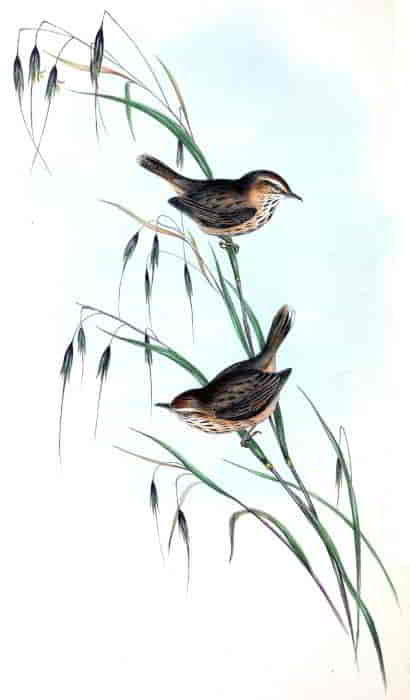
CALAMANTHUS CAMPESTRIS: Gould.
J. Gould and H. C. Richter del et lith. C. Hullmandel Imp.
CALAMANTHUS CAMPESTRIS.
Field Reed-Lark.
Praticola campestris, Gould in Proc. of Zool. Soc., Part VIII. p. 171.
The Calamanthus campestris is a native of Southern and Western Australia, where it inhabits open plains and scrubby lands, particularly such as are interspersed with tufts of coarse grasses. It has never yet been discovered within the colony of New South Wales. Like its near ally of Van Diemen’s Land it is a rather shy and recluse species, running mouse-like over the ground among the herbage with its tail perfectly erect, and is not easily forced to fly, or even to quit the bush in which it has secreted itself.
Its song is an agreeable and pretty warble, which is poured forth while the bird is perched upon the topmost twig of a small bush.
This species also emits so very powerful an odour, that my dog frequently pointed at it from a very considerable distance.
The food, as ascertained by dissection, was small coleopterous insects, with which its minute stomach was crammed.
The nest, which is placed on the ground, is a globular structure, composed of grasses and feathers. The eggs are three or four in number, of a light chestnut colour, thickly blotched with deep chestnut-brown, particularly at the larger end.
Forehead rufous, passing into the reddish brown of the crown and upper surface, with a stripe of blackish brown down the centre of each feather; wings sandy brown; internal webs of the primaries dark brown; two centre tail-feathers reddish brown, the remainder reddish brown at the base, crossed towards the extremity with a broad band of brownish black and broadly tipped with white; over the eye a line of white; ear-coverts mingled rufous and white; throat white, gradually passing into the buff of the under surface; all the feathers of the under surface with a stripe of brownish black down their centre; bill blackish brown, lighter at the base of the under mandible; irides rufous brown; feet blackish brown.
The Plate represents a male and a female of the natural size.
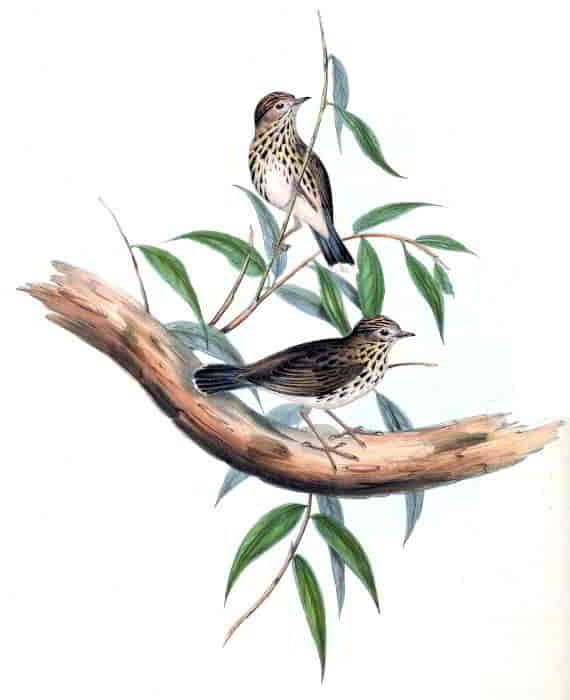
CHTHONICOLA MINIMA.
J. Gould and H. C. Richter del et lith. Hullmandel & Walton Imp.
CHTHONICOLA MINIMA.
Little Chthonicola.
Anthus minimus, Vig. & Horsf. in Linn. Trans., vol. xv. p. 230.
This pretty little bird is usually seen on the ground in small companies of five or six in number, and is so very tame in disposition as to admit of the nearest approach, and when flushed merely flits off to the distance of a few yards. Its distribution, so far as we yet know, is confined to New South Wales and South Australia, in both of which countries it is a stationary and abundant species. It is very active in its actions, running, or rather hopping, with great celerity over the gravelly ridges of the ground beneath the shade of the apple- and gum-trees.
The nest is of a domed form, and is placed among withered grass in a depression of the ground, so as to be on a level with the surface, and being formed of the same material as that with which it is surrounded, it is all but impossible to discover it; the entrance is an extremely small hole close to the ground. The eggs, which are four in number, are of a light cochineal-red, with a zone of blackish brown spots at the larger end; their medium length is nine lines by seven lines in breadth.
The sexes are very similar; some individuals however are distinguished by the superciliary stripe being brown instead of white; whether this be characteristic of youth or maturity, I have not satisfactorily ascertained; I can scarcely conceive that so trivial a difference should indicate a difference of species.
General plumage olive-brown, the feathers of the back with darker centres, and of the head with a longitudinal stripe of buff down the middle of each; primaries narrowly edged with whitish; tail slightly tipped with white; under surface white, washed with yellow, each feather with a broad stripe of blackish brown down the centre, except on the middle of the abdomen, which is nearly pure white and without stripes; irides straw-yellow; bill brown; feet fleshy brown.
The figures are of the natural size.
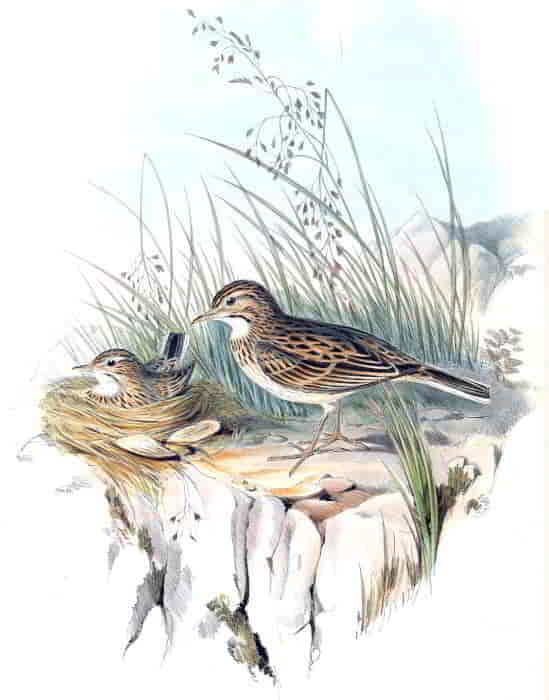
ANTHUS AUSTRALIS: Vig. & Horsf.
J. Gould and H. C. Richter del et lith. Hullmandel & Walton Imp.
ANTHUS AUSTRALIS, Vig. & Horsf.
Australian Pipit.
Anthus Australis, Vig. & Horsf. in Linn. Trans., vol. xv. p. 229.
——— pallescens, Vig. & Horsf. in Linn. Trans., vol. xv. p. 229.
Waȑ-ra-joo-lon, Aborigines of the lowlands of Western Australia.
Common Lark of the Colonists.
The Pipits, like many other of the Australian birds, are exceedingly perplexing, inasmuch as the specimens from the various colonies differ from each other considerably in size and in the length and form of the hind-claws. A more minute examination and a longer observation of them in a state of nature than my stay in the country afforded, may prove them to comprise several species, though for the present I can only regard them as mere local varieties; whatever the case may be, one thing is certain,—namely that the northern and southern regions of the country are inhabited by Pipits which bear a great resemblance to each other. Every variety of country, from the humid flats and sides of lagoons teeming with luxuriant vegetation to the hot sterile plains, are equally frequented by them; I could not fail to remark, however, that the short-toed and smaller-sized birds were most abundant on the plains. The Anthus Australis has all the habits and actions of its European prototype the Anthus aquaticus, but is still more bold and showy; its note is also very similar; it seldom flies higher than the tops of the trees, but occasionally mounts perpendicularly in the air, singing all the time; when flushed from the ground it rarely flies to any great distance before it descends again rather abruptly, to the earth, to the branch of a tree, or a small bush.
The nest is a rather deep and compactly formed structure of dried grasses; it is placed in a hole in the ground, sometimes beneath the shelter of a tuft of grass, but more frequently in a clear, open and exposed situation, the top of the nest being level with the surface. The eggs, which are three and sometimes four in number, are of a lengthened form, being eleven lines long by seven and a half lines broad, and are of a greyish white, blotched and freckled with light chestnut-brown and purplish grey, the latter colour appearing as if beneath the surface of the shell.
The breeding-season commences in the early part of September and continues until January, during which season two or three broods are reared.
The stomach is very muscular, and the food consists of insects of various kinds and small seeds.
The sexes are alike in plumage and may be described as follows:—
All the upper surface dark brown, each feather broadly margined with reddish brown; wings and two centre tail-feathers brown, margined with whitish brown; two lateral tail-feathers white, margined on the inner webs with blackish brown and with blackish brown shafts, the remaining tail-feathers blackish brown; stripe over the eye light buff; ear-coverts brown; under surface dull white, washed with buff on the under surface of the shoulder and on the under tail-coverts; the feathers of the breast, flanks and sides of the neck with a streak of dark brown down the centre, these marks being most conspicuous on the sides of the neck and across the upper part of the breast, where they are arranged in the form of a gorget, the points of which proceed upward to the angle of the lower mandible; irides very dark brown; bill and feet fleshy brown.
Freshly moulted individuals differ in having a rich tint of rufous pervading the whole of the upper surface, the breast and flanks.
The figures represent the two sexes of the natural size, from specimens procured in New South Wales.
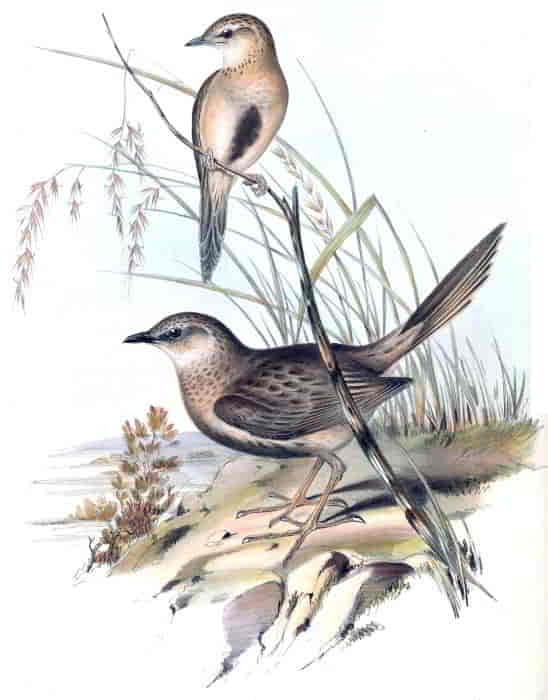
CINCLORAMPHUS CRURALIS.
J. Gould and H. C. Richter del et lith. Hullmandel & Walton Imp.
CINCLORAMPHUS CRURALIS.
Brown Cincloramphus.
Megalurus cruralis, Vig. & Horsf. in Linn. Trans., vol. xv. p. 228.
Cincloramphus cruralis, Gould in Proc. of Zool. Soc., Part V. p. 150; and in Syn. Birds of Australia, Part IV.
As there are two, if not three, species of this very singular genus inhabiting the southern portion of Australia, which bear a great resemblance to each other, it becomes necessary to state that the bird represented in the accompanying Plate is the one commonly seen during the months of spring and summer in all the open districts of New South Wales, in which country it arrives in August, and after performing the task of incubation, departs again in January or February. Open downs, grassy flats and fields of corn are its favourite places of resort. It is certainly one of the most animated of the Australian birds. Had I not visited Australia and personally studied its habits, my credulity would have been severely taxed upon being informed that the two birds here figured represent the male and female of the same species, many genera having been instituted upon much slighter grounds of difference; I had abundant proofs, however, that such is really the case, having seen many of the nests and eggs with the parent bird in the act of incubation, during the two seasons I spent in the country. In most of its habits and in its economy this bird closely assimilates to the Skylark of Europe. During the early months of spring it trips over the ground in the most sprightly manner with its tail nearly erect; mounts on the dead limbs of trees and the fences of enclosures, and runs along them with the greatest dexterity; at this season of the year also the male may be frequently seen running beside his diminutive partner, and so busily engaged in pouring forth his song for her amusement, as to be apparently unconscious of the presence of any other object. After the female has chosen the place for her nest, which is always on the ground, the male, like the Skylark, frequently mounts in the air with a tremulous motion of the wings, and after cheering her with his animated song, descends again to the ground or skims off to a neighbouring tree, and incessantly pours forth his voluble and not unpleasing notes.
I found it very abundant in all the Upper Hunter districts, as well as in all the surrounding country, both to the north and south: I killed numerous examples of both sexes, but not one male with the throat and under surface black, like specimens I have seen from Port Philip and South Australia, and which I consider to be specifically distinct.
The male has the entire plumage brown, each feather margined with brownish white; a large patch of dark brown on the centre of the abdomen; bill, inside of the mouth and tongue black; irides hazel; feet flesh-brown.
The female is similar in colour, but the feathers being more broadly margined with brownish white gives her a paler hue than her mate; the under surface is also much lighter, and the patch in the centre of the abdomen is much smaller.
The Plate represents a male and a female of the natural size.
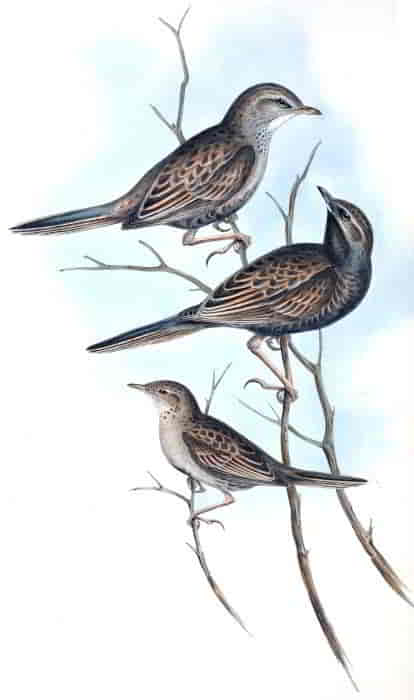
CINCLORAMPHUS CANTILLANS: Gould.
J. Gould and H. C. Richter del et lith. Hullmandel & Walton Imp.
CINCLORAMPHUS CANTILLANS, Gould.
Black-breasted Cincloramphus.
Cincloramphus cantatoris, Gould in Proc. of Zool. Soc., Part X. p. 135.
Ye-jȕl-lup, Aborigines of the mountain districts of Western Australia.
Sky-Lark of the Colonists.
I consider it necessary to state that the figures in the accompanying Plate are taken from specimens killed at Port Philip in South Australia, and I have a specimen procured at Port Essington which is precisely similar. They all differ from C. cruralis in their smaller size and in their darker colouring, a character which is confined to the male sex, and which is, I believe, strictly a summer livery. At Swan River the individuals are still smaller, and like the C. cruralis are never so black on the breast as the bird here figured; shall we not then be justified in considering this again as distinct? The term cantillans was applied to a specimen in the winter dress, when neither the breast nor bill is black, otherwise a more appropriate appellation might have been applied.
I possess no information respecting the habits of the Port Philip bird.
The following notes are from the pen of Mr. Gilbert, and are the result of his observations of the bird in Western Australia:—
“This is a summer visitor to Western Australia, a remarkably shy and wary species, and a most difficult bird to procure, from its generally perching on a part of a tree whence it can command an uninterrupted view all round, rarely admitting any one to approach it within gun-shot. On being flushed from the ground it immediately takes to a tree, where, with its tail erect, and its head stretched out to the full extent of its neck, it presents a most grotesque appearance. It often ascends perpendicularly to a considerable height in the air, and then floats horizontally without any apparent motion of the wings to the distance of three hundred yards. While flying it utters a most disagreeably harsh and grating note, which is exchanged for an inward, rather plaintive tone when perched among the branches. The nest, which is deposited in a slight depression of the ground, is formed of dried grasses, and is so loosely put together that it is extremely difficult to preserve it entire; the eggs are four in number, and are similar to, but larger and of a lighter colour than those of the C. rufescens.”
All the upper surface sandy brown, the centres of the feathers darker; primaries and tail greyish brown, slightly margined with reddish brown; immediately before the eye a triangular spot of brownish black; throat and chest dull white, the latter with a stripe of brown down each feather; under surface light brown; in the centre of the abdomen a patch of dark brown, each feather margined with pale brown; bill and feet fleshy brown.
The figures represent two males and a female of the natural size in different states of plumage.
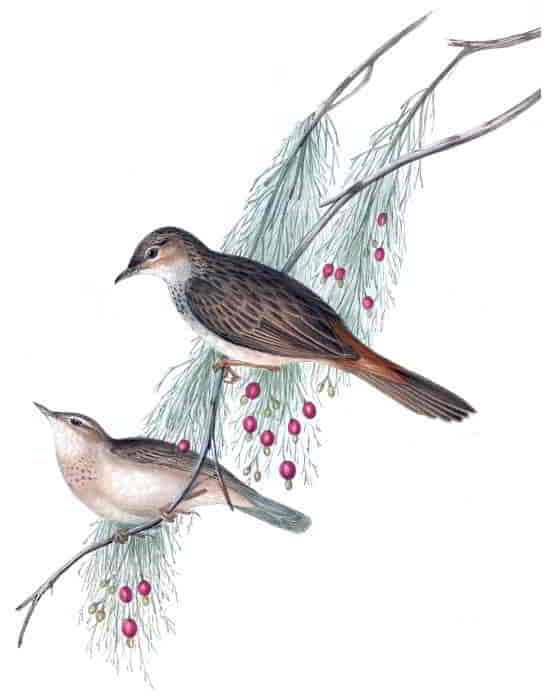
CINCLORAMPHUS RUFESCENS.
J. Gould and H. C. Richter del et lith. Hullmandel & Walton Imp.
CINCLORAMPHUS RUFESCENS.
Rufous-tinted Cincloramphus.
Anthus rufescens, Vig. & Horsf. in Linn. Trans., vol. xv. p. 230.
E-rolȅ-del, Aborigines of the Mountain districts of Western Australia.
Singing Lark of the Colonists.
If Australia be not celebrated for its singing-birds, it has still some few whose voices serve to enliven the monotony of its scenery; and of these no one deserves greater attention than the bird here represented, which is a very sweet songster, and whose note somewhat resembles, but is much inferior to that of our own Skylark. With the exception of Van Diemen’s Land, where I believe it is never seen, it appears to be distributed over all parts of Australia, as evidenced by my collection, containing specimens from every locality yet visited by Europeans. In New South Wales and Western Australia it is strictly migratory, and only a summer visitor, arriving in August and departing in February; on the other hand, I met with it on the sand hills at Holdfast Bay in South Australia in the month of July, the period of winter: although not exclusively a terrestrial bird, it spends much of its time on the ground, from which it makes perpendicular ascents to a great height in the air, and then descending to the tops of the highest trees, flies horizontally from one tree to another, singing all the time with the greatest volubility; the female, which is not more than half the size of the male, remaining all the while on the ground, from which she is not easily aroused, and consequently not so often seen. It evinces a great partiality to open grassy plains here and there studded with trees. It breeds in October, November and December, and sometimes rears two broods during the season. The nest is placed in a depression of the earth, most frequently at the foot of a slightly raised tuft of grass, and is externally composed of strong grasses and lined with very fine grasses, and sometimes with hairs. The eggs are four in number, ten lines long by seven and a half lines broad, and are of a purplish white, very boldly marked with freckles and small blotches of deep chestnut-brown, so much so as frequently to render the blotches more conspicuous than the ground colour.
The female frequently utters a monotonous shriek or call at night.
The male has all the upper surface dark brown, each feather margined with olive-brown; upper tail-coverts rufous; lores black; stripe above the eye and throat whitish; all the under surface pale brownish grey, deepening into buff on the under tail-coverts, and with a series of minute spots of brown on the breast; irides hazel; bill dark lead-colour in summer, fleshy brown in winter; tarsi yellowish grey; feet bluish ashy grey.
The female is smaller and is destitute of the black lores; in other respects she is so like the male that a separate description is unnecessary.
The figures represent the two sexes of the natural size, on a branch of the cherry-tree of the colonists (Exocarpus Cupressiformis).
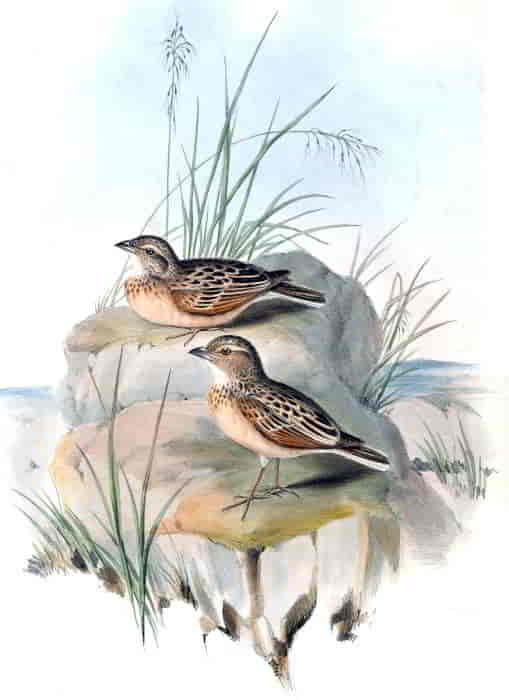
MIRAFRA HORSFIELDII: Gould.
J. Gould and H. C. Richter del et lith. Hullmandel & Walton Imp.
MIRAFRA HORSFIELDII, Gould.
Horsfield’s Mirafra.
Mirafra Horsfieldii, Gould in Proc. of Zool. Soc., January 27, 1847.
This species, which I have named Horsfieldii in honour of the founder of the genus, is sparingly dispersed over all the plains and open districts of New South Wales, but is more abundant on the inner side of the mountain ranges towards the interior than between the ranges and the sea; I have also a specimen procured during Dr. Leichardt’s overland expedition from Moreton Bay, and one from the neighbourhood of Port Essington: both of these, although possessing characters common to each other, differ from specimens obtained in New South Wales in being larger, redder in colour, and in having a stouter bill—features which will probably hereafter prove them to be distinct, and which exhibit a near alliance to the true Mirafra Javanica.
The bird here figured is from New South Wales, where I found it more abundant on the Liverpool Plains than elsewhere; I also met with solitary individuals in the district of the Upper Hunter.
In its habits it is more terrestrial than arboreal, and will frequently allow itself to be almost trodden upon before it will rise, and then it merely flies to a short distance and descends again; it may often be seen perched upon the strong blades of grass and occasionally on the trees; it frequently mounts high in the air after the manner of the Skylark of Europe, singing all the time very melodiously, but with a weaker strain than that favourite bird; it also occasionally utters its pleasing song while perched on the branches of the trees.
The sexes are alike in colour and size.
General plumage ashy brown, the centre of the feathers dark brown, the latter colour predominating on the head, lower part of the back and tertiaries; wings brown margined with rufous; over the eye a stripe of buff; chin white; under surface pale buff; throat crossed by a series of dark brown spots arranged in a crescentic form; under surface of the wing rufous; bill flesh-brown at the base and dark brown at the tip; feet fleshy brown.
The figures are of the natural size.
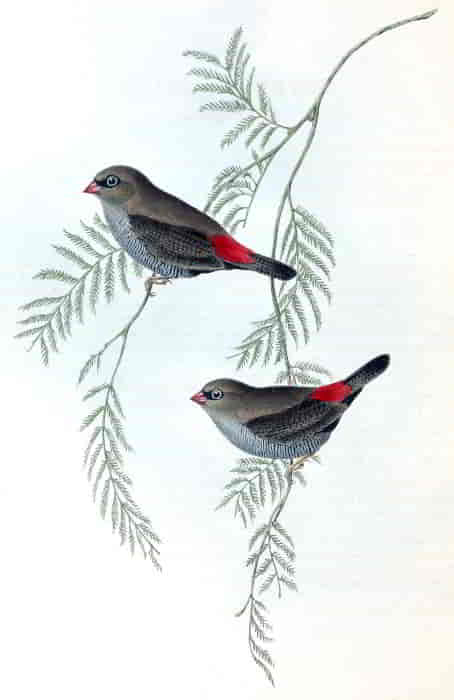
ESTRELDA BELLA.
J. Gould and H. C. Richter del et lith. Hullmandel & Walton Imp.
ESTRELDA BELLA.
Fire-tailed Finch.
Loxia bella, Lath. Ind. Orn. Supp., p. xlvi.
Black-lined Grosbeak, Lath. Gen. Syn. Supp., vol. ii. p. 198.—Ib. Gen. Hist., vol. v. p. 267.
Fringilla bella, Vig. & Horsf. in Linn. Trans., vol. xv. p. 257.
Wee-bong, Aborigines of New South Wales.
Fire-tail, Colonists of Van Diemen’s Land.
Van Diemen’s Land may be considered the stronghold of this species, for it is universally and numerously dispersed over all parts of that island suited to its habits and economy. It also inhabits New South Wales, but is there far less abundant than in other districts. I generally observed it in small communities varying from six to a dozen in number, searching on the ground for the seeds of grasses and other small plants which grow on the plains and open parts of the forest. It also frequents the gardens and pleasure-grounds of the settlers, with whom it is a favourite, few birds being more tame or more beautifully coloured than this little Finch; the brilliant scarlet of the rump, and the base of the tail-feathers strongly contrasting with the more sombre hue of the body. Its flight is extremely rapid and arrow-like, particularly when crossing a plain or passing down a gulley. It is a stationary species in Van Diemen’s Land, and probably also in New South Wales. In the former country I constantly encountered it breeding, my attention being usually attracted by the enormous nest which it builds, and which, being placed among the branches of shrubby trees without the slightest attempt at concealment, is very conspicuous. It moreover breeds in small communities, several nests about ten inches in diameter being placed on the same tree. They are constructed entirely of grasses and stalks of plants, dome-shaped in form, with a hole near the top for the ingress and egress of the bird. The eggs are five or six in number, rather lengthened in form and of a beautiful flesh-white, eight and a half lines long by six and a half lines broad. It breeds from September to January, during which period two or three broods are reared. Its note is a single mournful sound emitted while perched on the low branches of the trees in the neighbourhood of its feeding-places.
The sexes present no external difference, and may be thus described:—circle surrounding the eyes, lores, and a line crossing the forehead black; all the upper surface, wings and tail olive-brown, crossed by numerous narrow crescentic lines of black; rump and base of the tail-feathers shining scarlet; all the under surface grey, crossed by numerous narrow crescentic lines of black; centre of the abdomen and under tail-coverts black; tips of the primaries and tail-feathers brown without bars; bill crimson, becoming paler at the base of the upper mandible; irides very dark brown; eyelash beautiful light blue; feet flesh-colour.
The Plate represents the two sexes of the natural size.
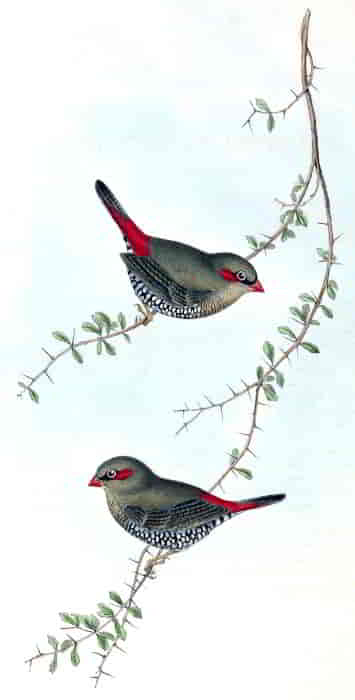
ESTRELDA OCULEA.
J. Gould and H. C. Richter del et lith. Hullmandel & Walton Imp.
ESTRELDA OCULEA.
Red-eared Finch.
Fringilla oculea, Quoy et Gaim. Voy. de l’Astrolabe, Zool., Part I. p. 211; Ois., pl. 18. fig. 2.
Jeȅ-ree, Aborigines of the lowland, and
Dweȑ-den-ngool-gnan̏-neer, Aborigines of the mountain districts of Western Australia.
Native Sparrow, Colonists of Swan River.
This species is abundant in many parts of the colony of Swan River on the western coast, but has not as yet been discovered elsewhere. Like its near ally the Estrelda bella it inhabits open grassy glades studded with thickets, particularly in moist swampy districts and along the borders of lakes and rivers. Its food consists of small grass-seeds procured among the herbage on the ground. It is not a migratory species, and its place of resort appears to be merely changed when, the supply of food being exhausted, it becomes necessary to seek it elsewhere. Mr. Gilbert states that “it is a solitary species and is generally found in the most retired spots in the thickets, where its mournful, slowly drawn-out note only serves to add to the loneliness of the place. Its powers of flight, although sometimes rapid, would seem to be feeble, as they are merely employed to remove it from tree to tree. The natives of the mountain districts of Western Australia have a tradition that the first bird of this species speared a dog and drank its blood, and thus obtained its red bill.”
The sexes are so much alike that dissection is necessary to distinguish the male from the female. The beautiful patch of scarlet feathers behind the eye, together with the rich colouring of the bill, assists very materially in relieving the more sombre but delicate markings of the remainder of the body.
Lores, line over the bill and a narrow circle surrounding the eye black; behind the eye a small patch of shining scarlet; all the upper surface olive-brown, crossed by numerous fine irregular crescent-shaped bands of black, which are broadest and most conspicuous on the lower part of the back; wings and tail similarly marked, but with the black bands still broader and more distinct; rump and the margins of the base of the central tail-feathers shining scarlet; throat and breast light brown, crossed by numerous crescent-shaped bands of black; abdomen and under surface black, with a large spot of white near the tip of each feather; irides red; bill bright vermilion, the base of the upper mandible edged with pearl-grey; eyelash greenish blue; legs yellowish grey.
The figures are of the natural size.
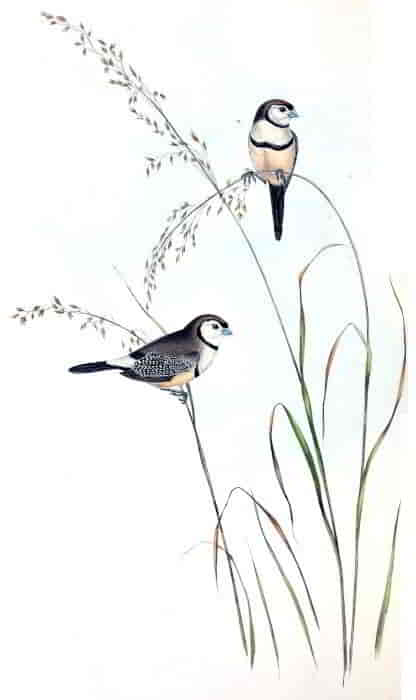
ESTRELDA BICHENOVII.
J. & E. Gould del et lith. C. Hullmandel Imp.
ESTRELDA BICHENOVII.
Bicheno’s Finch.
Fringilla Bichenovii, Vig. & Horsf. in Linn. Trans., vol. xv. p. 258.—Jard. and Selb. Ill. Orn., vol. i. pl. xii. fig. 3.
This beautiful little Finch inhabits the extensive plains of the interior, particularly such portions of them as are thinly intersected with low scrubby trees and bushes. The localities in which my specimens were obtained were the Liverpool and Brezi Plains, and I have not yet received it from any other parts of Australia, but this may be attributed rather to the paucity of information respecting the interior than to any other cause; and as I have had occasion to remark with respect to other species, it will be impossible to determine the precise extent of the range of this bird until the country has been more fully explored.
The Bicheno’s Finch is very tame in its disposition, and is generally to be observed on the ground, occupied in procuring the seeds of the grasses and other small plants, which form its principal food. At the time of my visit to the interior, which was in the month of December, it was assembled in small flocks of from four to eight in number; these, when flushed from among the grasses, would perch on the neighbouring bushes rather than fly off to any distance, and indeed the form of its wings and tail indicate that it possesses lesser powers of flight than many of the other Finches.
I was not fortunate enough to obtain its nest or eggs, neither did I ever hear it utter any kind of song; consequently I am unable to give any information on these points.
The male has the face, ear-coverts and throat pure white, completely surrounded by a band of black, which is broadest on the forehead; crown of the head, nape of the neck, and back broccoli-brown, each feather crossed by numerous transverse lines of a lighter tint; upper part of the rump black; lower part of the rump and upper tail-coverts snow-white; wings black, all the feathers except the primaries beautifully spotted with white; chest greyish white tinged with buff, bounded below by a broadish band of jet-black; abdomen and flanks buffy white; under tail-coverts and tail black; irides black, surrounded by a narrow black lash; bill beautiful pale blue.
The sexes, although having a similar character of marking, may be distinguished from each other by the male having the black bands of the chest and throat broader, and its plumage more brilliant. The young also at an early age possess the characteristic markings of the adult.
The Plate represents a male and a female of the natural size.
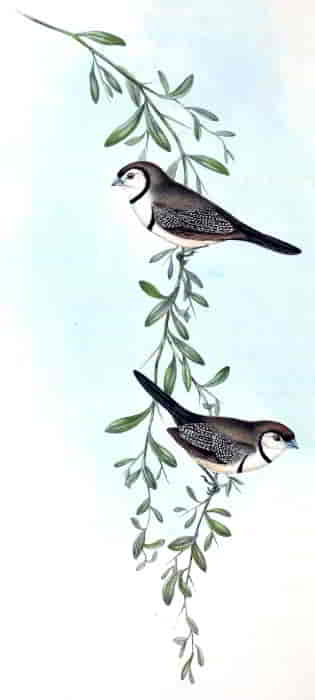
ESTRELDA ANNULOSA: Gould.
J. & E. Gould del et lith. C. Hullmandel Imp.
ESTRELDA ANNULOSA, Gould.
Black-rumped Finch.
Amadina annulosa, Gould in Proc. of Zool. Soc., Part VII. p. 143.
This species was one of several, collected by the Officers of H.M.S. the Beagle, and for the specimens from which my figures were taken I am indebted to Messrs. Bynoe and Dring. The bird has also been more recently brought to England by Captain Grey: all the specimens here alluded to were collected on the north-west coast, and I find it is not unfrequently seen on the Coburg Peninsula, where it inhabits the grassy banks of running streams, in small families of from six to ten in number.
It differs from Bicheno’s Finch in the spots and markings on the upper surface being rather less defined, and in the colouring of the rump, which in this species is black, while in the other it is white.
Face, ear-coverts and throat white, surrounded by a jet-black band, which is broadest on the forehead; chest greyish white, bounded below by a conspicuous band of black; lower part of the abdomen white; crown of the head, back of the neck, and back greyish brown marked with numerous fine transverse lines of greyish white; rump, upper and under tail-coverts and tail black; wings blackish brown, the secondaries and coverts thickly dotted with fine markings of greyish white; bill and feet lead-colour.
The figures are those of a male and a female of the natural size.
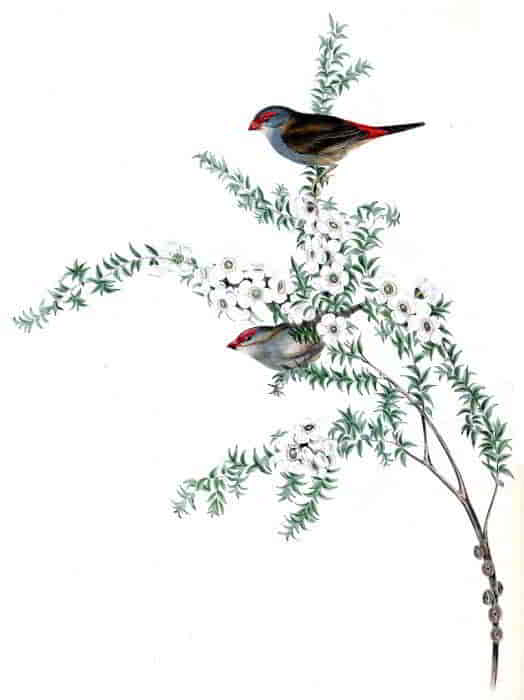
ESTRELDA TEMPORALIS.
J. Gould and H. C. Richter delt. C. Hullmandel Imp.
ESTRELDA TEMPORALIS.
Red-eyebrowed Finch.
Fringilla temporalis, Lath. Ind. Orn., Supp., p. xlviii.—Vig. & Horsf. in Linn. Trans., vol. xv. p. 258.—Shaw, Gen. Zool., vol. ix. p. 533.
Temporal Finch, Lath. Gen. Syn., Supp., vol. ii. p. 211; and Gen. Hist., vol. vi. p. 115.—Lewin, Birds of New Holl., pl. 12.
Le Sénégali quinticolor, Vieill. Ois. Chant., p. 38, pl. 15.
Fringilla quinticolor, Vieill. 2nde Edit., du Nouv. Dict. d’Hist. Nat., tom. xii. p. 183.—Ib. Ency. Méth., Part III. p. 991.
Goo-lung-ag-ga, Aborigines of New South Wales.
Red-Bill of the Colonists.
This species of Finch is very generally spread over the gardens and all such open pasture lands of New South Wales and South Australia as abound in grasses and small plants, upon the seeds of which it chiefly subsists. It is particularly abundant in the neighbourhood of Sydney; even in the Botanic Garden numbers may always be seen flitting from border to border. It is easily domesticated, and is of a lively disposition in captivity, even old birds becoming perfectly reconciled after a few days. In the autumn it is gregarious, and Mr. Caley states it often assembles in such large flocks, that he has killed above forty at a shot; in the spring they are mostly seen in pairs, and then build their large and conspicuous nest, which is formed of dead grass, lined with thistle down, in any low bush adapted for a site, but in none more frequently than in the beautiful plant figured in the accompanying Plate (Leptospermum squarrosum) which was made by Mrs. Gould during our stay in Sydney; and I feel assured it will be acknowledged, that in delineations of flowers as well as of birds her pencil was directed by a hand at once masterly and truthful.
The eggs are five or six in number, of a beautiful fleshy white, seven lines long by five and a half lines broad.
Crown of the head bluish grey; upper surface, wings and tail olive-brown; under surface white; patch over the eye and rump crimson; irides brownish red; eyelash narrow, naked and black; bill fine blood-red, with the ridge of the upper and the lower part of the under mandible black; legs yellowish white.
The Plate represents the two sexes of the natural size.
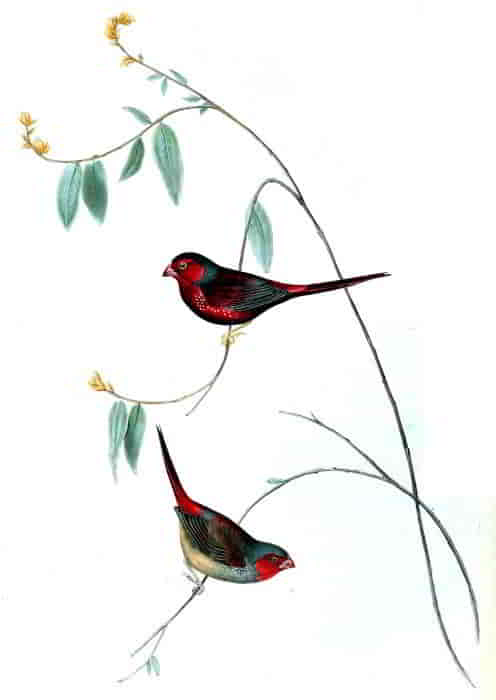
ESTRELDA? PHAETON.
J. Gould and H. C. Richter delt. C. Hullmandel Imp.
ESTRELDA PHAETON.
Crimson Finch.
Bengali Phaéton (Fringilla phaeton), Homb. et Jacq. Ann. des Sci. Nat., tom. vi. p. 314.
Ing-a-dȁm-oon, Aborigines of Port Essington.
Red Finch, Residents of Port Essington.
In a paper addressed by MM. Hombron and Jacquinot to the Académie des Sciences on the 9th of August, 1841, entitled, “Déscription de plusieurs Oiseaux nouveaux ou peu connus, provenant de l’expédition autour du monde faite sur les corvettes l’Astrolabe et la Zélée,” I find the characters of a Finch, which, although the colouring does not quite agree with that of the bird here figured, I have little doubt is identical with it. I am the more inclined to consider them to be identical from the circumstance of MM. Hombron and Jacquinot’s bird having been collected at Raffles’ Bay, a locality closely bordering that in which Mr. Gilbert procured the specimens in my own collection, and who states that “this bird is an inhabitant of moist grassy meadows, particularly where the Pandanus (Screw Pine) is abundant. It is generally found feeding among the grass, and when disturbed invariably takes to those trees. From July to November it is to be observed in large flocks, sometimes of several hundreds; but although great numbers were shot during this period, not more than three or four were obtained in the rich plumage. About the latter part of November they were either in pairs or in small companies, not exceeding six in number; the males decorated with their rich red and spotted dress.”
In its form it is in every respect closely allied to the Estrelda temporalis of the southern coast, and it doubtless as closely assimilates in its actions, economy and nidification, of which at present nothing is known.
The stomach is somewhat muscular, and the food consists of grass and other small seeds.
Crown of the head deep bluish black; lores, line over the eye, sides of the face and ear-coverts rich crimson red; under surface crimson red, spotted on the flanks with white; centre of the abdomen and under tail-coverts black; back of the neck and rump dark brownish grey; back and wings brownish grey, each feather crossed near the extremity with a band of deep crimson red; upper tail-coverts and two centre tail-feathers deep red; the remainder deep red at the base, passing into brown at the tip; bill rich carmine, bounded at the base by a band of greyish white about one-tenth of an inch in breadth; hinder part of the tarsi and inside of the feet ochre yellow; front of tarsi and upper surface of the feet ochre yellow, strongly tinged with hyacinth-red.
The female, who is rather smaller than her mate, is brown above, a few of the feathers on the back and the wing-coverts crossed with red as in the male; lores, line over the eye, sides of the face, chin, upper tail-coverts and tail as in the male, but not quite so brilliant; breast and flanks greyish brown, the latter ornamented with a few small spots of white; centre of the abdomen buff.
The Plate represents the two sexes of the natural size.
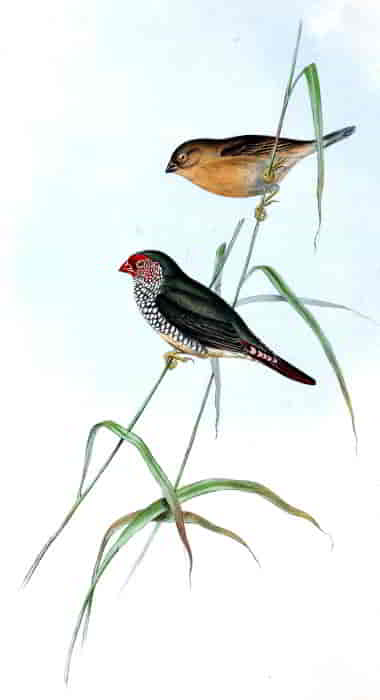
ESTRELDA RUFICAUDA: Gould.
J. Gould and H. C. Richter lithog. C. Hullmandel Imp.
ESTRELDA RUFICAUDA, Gould.
Red-tailed Finch.
Amadina ruficauda, Gould in Proc. of Zool. Soc., Part IV. p. 106; and in Syn. Birds of Australia, Part I.
I observed this beautiful Finch rather thinly dispersed on the sides of the river Namoi, particularly along the sloping banks covered with herbage, where it appeared to be feeding upon such grasses and other annuals as afforded seeds congenial to its taste; I also frequently observed it among the rushes which grow in the beds of mud along the sides of the water; and this, I regret to say, is all the information I have to communicate respecting it. It is a species seldom seen in collections, which may be attributed to the circumstance of its being strictly confined to the interior, a part of the country where collections are much less frequently formed than near the coast. The only parts of Australia whence I have received or in which I have killed it, are the Liverpool Plains, and the banks of the rivers Mokai and Namoi.
The adult male and female are scarcely to be distinguished by outward appearance; the female is, however, a trifle less than her mate in size. The young, on the contrary, present a very different appearance; the whole of their plumage being of a uniform buffy brown; eye yellowish olive surrounded by a narrow olive lash; bill reddish brown; legs brownish yellow.
Face and cheeks scarlet, the latter covered with narrow feathers, which are finely spotted with white at the tip; upper surface and wings olive-brown; upper tail-coverts and tail deep crimson-brown, the former having a large spot of pinkish white near the tip of each feather; throat, chest and flanks delicate olive-grey, each feather having a large oval white spot transversely disposed near the tip; centre of the abdomen and under tail-coverts dirty yellowish white; bill scarlet; irides orange slightly inclining to hazel, surrounded by a rather broad, naked, flesh-coloured lash; legs and feet rather darker than fine lemon-yellow.
The figures are of the natural size.
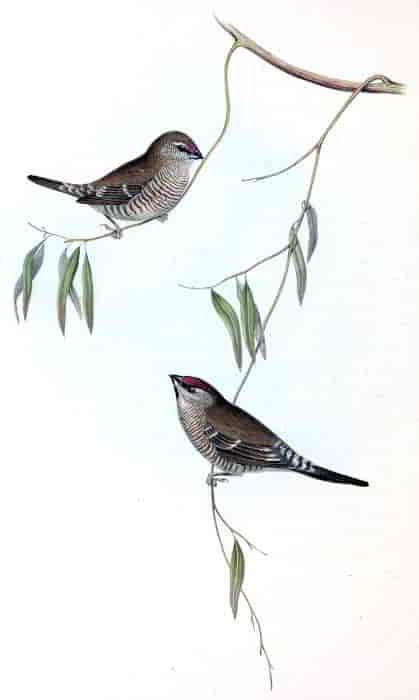
AMADINA MODESTA: Gould
J. Gould and H. C. Richter del et lith. Hullmandel & Walton Imp.
AMADINA MODESTA, Gould.
Plain-coloured Finch.
Amadina modesta, Gould in Proc. of Zool. Soc., Part IV. p. 105; and in Syn. Birds of Australia, Part I.
The native habitat of this species of Finch, so far as is yet known, is confined to New South Wales, where it inhabits the stony ridges bordering the large plains. I have known it to cross the Liverpool range and take up its summer abode in the flats of the Upper Hunter, but this proximity to the coast is rare. I found it tolerably abundant on the Liverpool Plains and on the banks of the Namoi, and Mr. Gilbert also mentions his having observed it on the low ranges to the northward of Moreton Bay. In its habits, actions and economy no remarkable differences were observed from those of the other species of the genus.
It is usually seen in pairs or associated in small companies, feeding either on or near the ground; the seeds of grasses and other annuals forming its chief supply of food.
A nest found by Mr. Gilbert was of a domed form, composed of grasses, and contained five or six white eggs, about half an inch long by three-eighths broad.
The sexes may be distinguished by the absence of the black mark in the female, as shown in the accompanying Plate.
The male has the fore-part of the head deep crimson red; lores and a spot on the chin black; nape of the neck, mantle and back brown; wings brown; tertials (which are very long in this species), together with the greater and lesser quill-feathers, having a spot of white at the tip; rump and upper tail-coverts alternately barred with lines of greyish white and brown; tail-feathers black, the two outer ones on each side tipped with white; under surface white, transversely barred with lines of brown, which are strongest on the flanks; middle of the abdomen and under tail-coverts white; bill black; irides reddish brown; eyes surrounded by a very narrow lash of blackish brown; legs flesh-white.
The female differs in having the colouring of the crown less extensive, and in wanting the black on the chin and lores.
The figures represent the two sexes of the natural size.
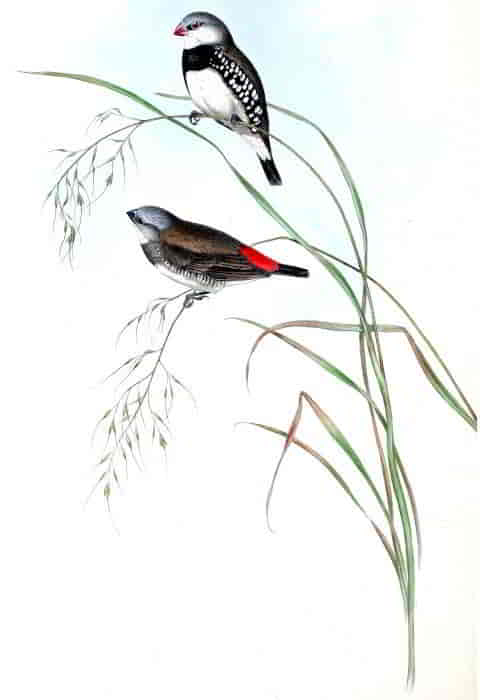
AMADINA LATHAMI.
J. Gould and H. C. Richter del et lith. C. Hullmandel Imp.
AMADINA LATHAMI.
Spotted-sided Finch.
Fringilla leucocephala, var., Lath. Ind. Orn. Supp., p. xlviii.—Shaw, Gen. Zool., vol. ix. p. 493.
Spotted Grosbeak, Lewin, Birds of New Holl., pl. ix.
White-headed Finch, Lath. Gen. Syn. Supp., vol. ii. p. 210. pl. 132.
Spotted-sided Grosbeak, Lath. Gen. Hist., vol. v. p. 248. pl. lxxxix.
Fringilla Lathami, Vig. & Horsf. in Linn. Trans., vol. xv. p. 256.
This bird is very generally dispersed over the southern portion of the Australian continent; I found it plentiful in South Australia and in every part of New South Wales that I visited; and it was equally numerous beyond the boundary of the colony on the Liverpool Plains, the Namoi, &c. It is a showy attractive species, and passes much of its time on the ground, where it procures its food, which consists of the seeds of various kinds of grasses, &c.; upon being compelled to rise from the ground it merely flies into the nearest tree, the scarlet rump showing very conspicuously during these short flights.
The most singular part of this bird’s history is the site often chosen for its nest, which is frequently built among the large sticks forming the under surface of the nest of the smaller species of Eagles, and that too during the time the Eagle is sitting, both species hatching and rearing their progeny in harmony; this I have witnessed in several instances, and have taken the eggs of the Eagle and of the Finch at the same time, as mentioned in the following extract from my journal:—“Oct. 23. Found the nest of Amadina Lathami placed under and among the sticks of a Whistling Eagle’s (Haliastur? sphenurus) nest, in which latter the old bird was then sitting. My black companion Natty ascended the tree, a high swamp oak (Casuarina) on the bank of the Dartbrook, and brought down the eggs of both birds. The little Finches were sitting on the small twigs close to their rapacious but friendly neighbour.” At other times the nest is placed on the leafy branch of a gum- or apple-tree. It is of a large size, and is constructed of grasses of various kinds; in form it is nearly spherical, with a short pendent spout on one side, through which the bird obtains access to the interior; the eggs are white, rather long in shape, and five or six in number.
The sexes offer little or no difference in the markings of their plumage.
Crown of the head and back of the neck brownish grey; back and wings brown, becoming deeper on the tips of the primaries; lores, a broad band across the breast, flanks and tail deep black; each feather of the flanks with a large spot of white near the tip; rump and upper tail-coverts shining scarlet; throat, abdomen and under tail-coverts white; irides red, surrounded by a narrow, naked, lilac-red lash; bill blood-red, passing into lilac at the base and on the culmen; feet purplish brown.
The young for the first year has the bill black, except at the base, where it is flesh-colour; the band across the breast and the flanks greyish brown, the latter being barred indistinctly with black and greyish white; in other respects the plumage nearly resembles the adult.
The Plate represents an adult male and a young bird of the natural size.
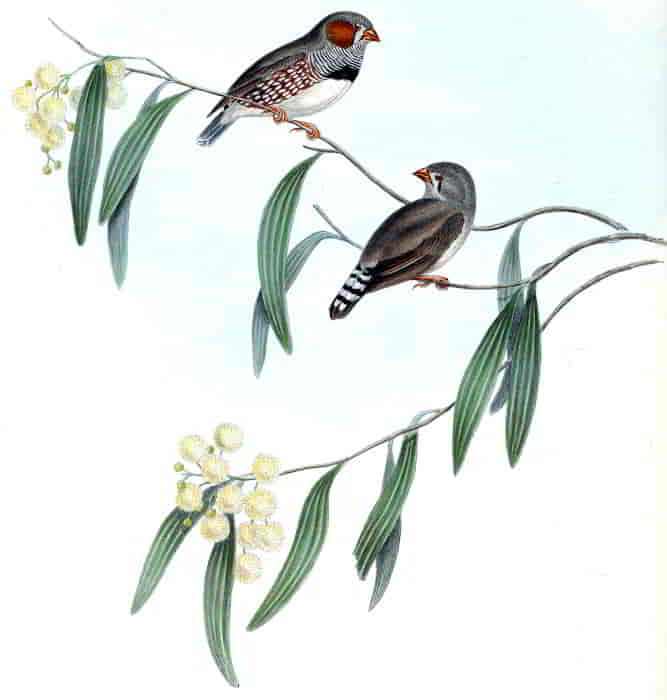
AMADINA CASTANOTIS: Gould.
J. Gould and H. C. Richter del et lith. C. Hullmandel Imp.
AMADINA CASTANOTIS, Gould.
Chestnut-eared Finch.
Amadina castanotis, Gould in Proc. of Zool. Soc., Part IV. p. 105; and in Syn. Birds of Australia, Part I.
This bird, which is nearly allied to the Bengali moucheté of Vieillot’s ‘Oiseaux Chanteurs,’ plate 3, appears to be almost peculiar to the interior of Australia; among other places it inhabits the large plains to the north of the Liverpool range, and is particularly abundant about Brezi and the banks of the river Mokai; but that it sometimes occurs on the southern side of the range, is proved by my having killed five specimens in Mr. Coxen’s Garden at Yarrundi on the Upper Hunter. It has also been found, though very sparingly, at Swan River, and a specimen is contained in the collection formed by Mr. Bynoe at Port Essington: like the Amadina Lathami, this species resorts much to the ground and feeds upon the seeds of various kinds of grasses. On the plains it congregates in small flocks, and evinces a decided preference to those spots where the trees are thinly dispersed and grasses abundant.
The Chestnut-eared Finch is one of the smallest of the genus yet discovered in Australia; it is also one of the most beautiful, and in the chasteness of its colouring can scarcely be excelled.
The two sexes differ very considerably in their markings, and may be thus described:—
The male has the crown of the head, nape and back brownish grey; wings brown; rump white; upper tail-coverts jet-black, each feather having three large and conspicuous oval spots of white; tail-feathers blackish brown slightly tinged with white at their tips; cheeks and ear-coverts reddish chestnut, separated from the bill by a narrow transverse line of white, which white line is bounded on each side by a still finer line of black; throat and chest grey, the feathers transversely marked with fine lines of black; a small black patch on the middle of the chest; abdomen white; under tail-coverts buffy white; flanks chestnut, each feather marked near the tip with two small oval spots of white; bill reddish orange; feet reddish orange, rather lighter than the bill; irides red.
The female has the transverse lines on the face, upper tail-coverts and feet, as in the male; upper surface, ear-coverts, wings, tail and flanks greyish brown; throat and chest grey, slightly tinged with brown; abdomen yellowish brown; bill reddish orange.
The figures represent both sexes of the natural size.
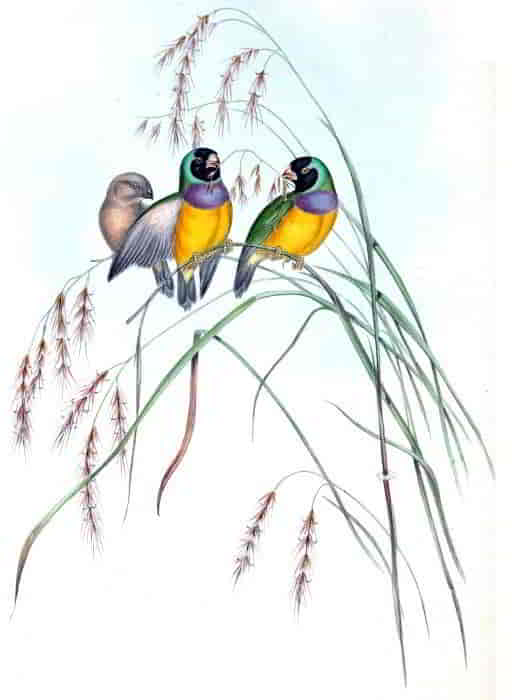
AMADINA GOULDIÆ: Gould.
J. Gould and H. C. Richter del et lith. C. Hullmandel Imp.
AMADINA GOULDIÆ.
Gouldian Finch.
Amadina Gouldiæ, Gould in Proc. of Zool. Soc., January 23, 1844.
Novelty in itself has attractions, but when with novelty, beauty and elegance are combined, the attractions are augmented beyond measure. With this trite observation I here introduce to the notice of the ornithologist a species not only the most beautiful of the family to which it belongs, but which has its plumage adorned with colours and markings that render it conspicuously different from every other bird known; it is in fact beyond the power of my pen to describe or my pencil to portray anything like the splendour of the changeable hues of the lilac band which crosses the breast of this little gem, or the scarcely less beautiful green of the neck and golden-yellow of the breast, the latter colour being only equalled, certainly not surpassed, by the crest-feathers of the Golden Pheasant. Whenever this bird becomes so far common as to form a part of our preserved collections, or to add a living lustre to our aviaries, it cannot fail to become a general favourite. It is therefore with feelings of no ordinary nature that I have ventured to dedicate this new and lovely little bird to the memory of her, who in addition to being a most affectionate wife, for a number of years laboured so hard and so zealously assisted me with her pencil in my various works, but who, after having made a circuit of the globe with me, and braved many dangers with a courage only equalled by her virtues, and while cheerfully engaged in illustrating the present work, was by the Divine will of her Maker suddenly called from this to a brighter and better world; and I feel assured that in dedicating this bird to the memory of Mrs. Gould, I shall have the full sanction of all who were personally acquainted with her, as well as of those who only knew her by her delicate works as an artist.
A single specimen of apparently an adult male and two immature birds are all that ever came under my notice; for the former my especial thanks are due to my esteemed friend Benjamin Bynoe, Esq., Surgeon R.N., late of H.M.S. the Beagle, who obtained it in the Victoria River, on the north-west coast of Australia. The young birds were procured by Mr. Gilbert at Port Essington. These three examples are probably all that have been collected, and from the remote situation of the country of which it is a native, a long period is likely to elapse before the species becomes common.
“This would seem to be a very local species,” says Mr. Gilbert, “for I only met with it on Greenbill Island at the head of Van Diemen’s Gulf, where it inhabited the edges of the mangroves and thickets: when disturbed it invariably flew to the topmost branches of the loftiest gums, a habit I have not before observed in any other member of the genus. Its note is a very mournful sound, added to a double twit. Those I observed were feeding among the high grass in small families of from four to seven in number, and were very shy. The stomach is tolerably muscular, and the food consists of grass and other seeds.”
The adult has the forehead, lores, ear-coverts and throat, deep velvety black; from behind the eye, round the occiput, and down the sides of the neck, a mark of verdigris-green, gradually blending into the yellowish green of the upper surface and wings; across the breast a broad band of shining lilac-purple, below which all the under surface is shining wax-yellow; bill flesh-white at the base, tipped with blood-red; feet flesh-colour.
The young bird has the head grey; upper surface light olive; under surface pale buff; chin white; primaries and tail brown; irides dark brown.
The figures are of the natural size.
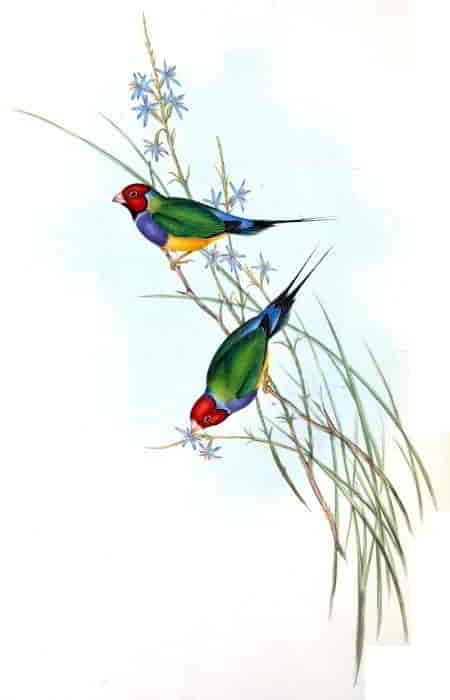
POËPHILA MIRABILIS: Humb: et Jacq:
J. Gould and H. C. Richter del et lith. Hullmandel & Walton Imp.
POËPHILA MIRABILIS, Homb. et Jacq.
Beautiful Grass Finch.
Poëphila mirabilis, Homb. et Jacq. Voy. au Pole Sud.—O. des Murs, Icon. Orn., pl. 3. fig. 1.
Fine examples of this, one of the most lovely of the Finches yet discovered, are contained in the gallery of the Museum of Natural History of Paris; they were procured by Messrs. Hombron and Jacquinot in the neighbourhood of Raffles’ Bay, on the north coast of Australia, where it is so rare, that those gentlemen only met with three examples, and were unable to make themselves acquainted with its actions and manners. In the works above-quoted my Poëphila Gouldiæ is figured as the female of the present bird, but this I believe to be a mistake, the specimen from which my description and figure were taken being to all appearance an adult male; and as an evidence that such may be the case, I may mention that no female of the group has yet been discovered so gorgeously arrayed; the females of all the Poëphilæ I have seen resemble their respective males in the colouring of their plumage, but have all the hues much less brilliant; it is not probable therefore that a bird so gaily coloured as the P. Gouldiæ should be the female of the P. mirabilis; besides which, Mr. Gilbert procured an example of P. Gouldiæ during Dr. Leichardt’s Expedition from Moreton Bay to Port Essington, which dissection proved to be a female, and which although similarly, was much less highly coloured than the bird I have represented.
Crown of the head and cheeks of a beautiful carmine, bounded posteriorly by a narrow line of black; throat black; to this succeeds a band of pale blue, narrow on the throat and broad on the back of the neck; back and wings green, passing into yellow at the nape of the neck; breast crossed by a broad band of lilac, separated from the yellow of the abdomen by a narrow line of orange; rump and upper tail-coverts pale blue; quills brown; bill fleshy white, becoming redder at the tip; feet flesh-colour.
The figures represent a male in two positions of the natural size.
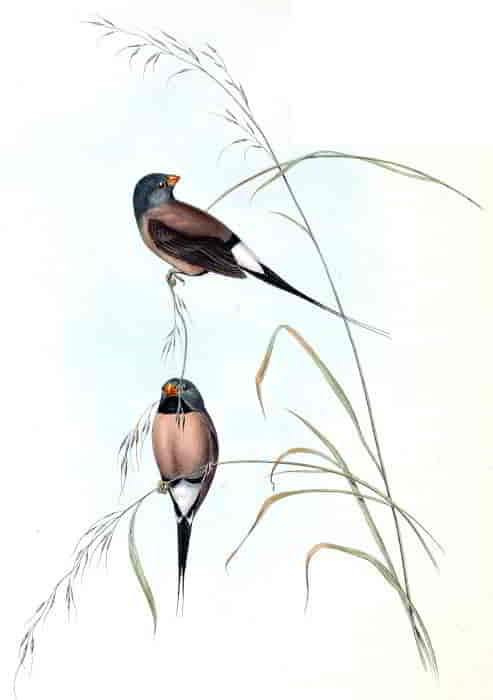
POËPHILA ACUTICAUDA: Gould.
J. Gould and H. C. Richter delt. C. Hullmandel Imp.
POËPHILA ACUTICAUDA, Gould.
Long-tailed Grass Finch.
Amadina acuticauda, Gould in Proc. of Zool. Soc., Part VII. p. 143.
It is no less interesting to trace the analogies of species inhabiting the opposite portions of a large continent like that of Australia, than to observe how beautifully any peculiar character is preserved in the species of every natural group. The three new species of the present genus afford a very striking example of this, where not only a similarity of colouring exists in the deep fawn or cinnamon hue of the plumage, but in the conspicuous band of black which surrounds the lower part of the body; nor is the graduated character of the tail-feathers less striking in these three species, the first trace of it being observable in Poëphila cincta, which would appear to be carried to the maximum in the present species, which, so far as is known, is confined to the north-west coast. The specimens from which my figures of this bird were taken are from the interesting collection placed in my hands by Mr. Bynoe of the Beagle, whose great perseverance and assiduity have enabled me to add many species to the fauna of Australia. Indeed many of the officers of that vessel will have their names handed down to posterity in consequence of the attention they have paid to this branch of science, independently of the legitimate objects of their various expeditions; among others I may particularly allude to my much-esteemed friend Mr. Darwin, Captain Wickham, Captain Stokes, Mr. Dring, &c. Since the arrival of Mr. Bynoe’s birds I have also received specimens from Port Essington, which, like their analogue the Poëphila cincta of the eastern coast, inhabit the open plains bordering streams, and feed on the seeds of various grasses and other plants.
I regret that so little information has been transmitted to me respecting the habits and economy of this beautiful species.
The sexes differ but little in outward appearance; the female is, however, rather less in size, is less strikingly marked, and has the two middle tail-feathers shorter than her mate.
Crown of the head and cheeks grey; upper and under surface of the body fawn-colour, becoming more delicate, and assuming a pinky hue on the abdomen; lores, throat, hand across the rump and tail jet-black; upper and under tail-coverts and thighs white; wings fawn-grey; bill and feet yellow.
The figures are those of a male and a female of the natural size.
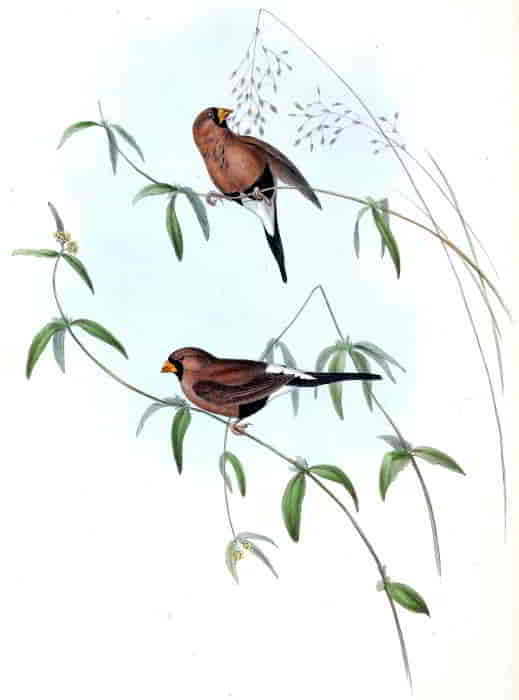
POËPHILA PERSONATA: Gould.
J. Gould and H. C. Richter delt. C. Hullmandel Imp.
POËPHILA PERSONATA, Gould.
Masked Grass Finch.
Poëphila personata, Gould in Proc. of Zool. Soc., February 8, 1842.
This beautiful and well-marked species of Grass Finch is also a native of the north-west coast of Australia, where several specimens were shot by Mr. Gilbert during an excursion from Port Essington towards the interior of the country, who states that it inhabits grassy meadows near streams, feeding on grass-seeds, &c. It was tolerably abundant, being congregated in flocks of from twenty to forty. When on the wing it utters a very feeble cry of twit, twit, twit, but at other times pours forth a drawn-out mournful note, like that of the Estreldas.
The sexes are scarcely to be distinguished by their outward appearance, both possessing the masked face; the female is, however, rather less in size, and her markings are not quite so brilliant or decided as those of the male.
Base of the bill surrounded by an irregular ring of deep velvety black; crown of the head, upper surface and wings light cinnamon-brown; lower part of the abdomen banded with deep velvety black; lower part of the rump and under tail-coverts white; upper tail-coverts white, striped longitudinally with black on the outer side; tail deep blackish brown; irides of the old birds red, of the young birds dark brown; bill bright orange; legs and feet fleshy red.
In some specimens the upper and lower ridges of the bill are black, while in others the basal half only is orange, the remaining portion being brown.
The figures are those of a male and a female of the natural size.
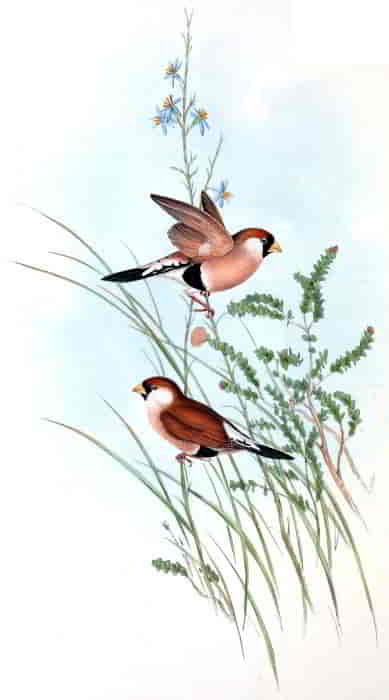
POËPHILA LEUCOTIS: Gould.
J. Gould and H. C. Richter del et lith. Hullmandel & Walton Imp.
POËPHILA LEUCOTIS, Gould.
White-eared Grass Finch.
Poëphila leucotis, Gould in Proc. of Zool. Soc., Part XIV. p. 106.
The present beautiful species of Poëphila is one of the novelties discovered during Dr. Leichardt’s expedition from Moreton Bay to Port Essington; it was killed in the neighbourhood of the river Lynd by Mr. Gilbert, in whose Journal, under the date of June 3, 1845, I find the following remark:—“The most interesting circumstance that occurred to me to-day was the discovery of a new species of Poëphila, which is very nearly allied to the one from Port Essington (P. personata, Gould), but which differs from that bird in having the bill light yellowish horn-colour instead of orange, the irides dark brown and the legs red; it is in every respect a true Poëphila, having the black face and throat, the black marks on the flanks, the lengthened tail-feathers and the general plumage of a light brown; like the other members of the genus too, it inhabits the open spots of country, and feeds on grass seeds.”
This I regret to say is all that is known respecting it. In addition to the differences pointed out by Mr. Gilbert, I may mention that it may also be distinguished from the P. personata by its white ear-coverts and by the black of the throat being bounded below and the black marks on the flanks anteriorly with white; the colouring of the upper surface is also a somewhat richer brown.
I possess both sexes of this species, and, as is the case with the other members of the genus, they differ but little from each other.
Band crossing the forehead, lores, throat, and a large patch on each flank deep velvety black; ear-coverts, a narrow line beneath the black of the throat, and a space surrounding the black patch on the flanks white; crown of the head deep reddish chestnut; all the upper surface and wings dark cinnamon-brown; chest and abdomen pale vinous brown; upper and under tail-coverts white, the former margined externally with deep black; tail black; irides dark brown; feet red; bill yellowish horn-colour.
The Plate represents the two sexes of the natural size.
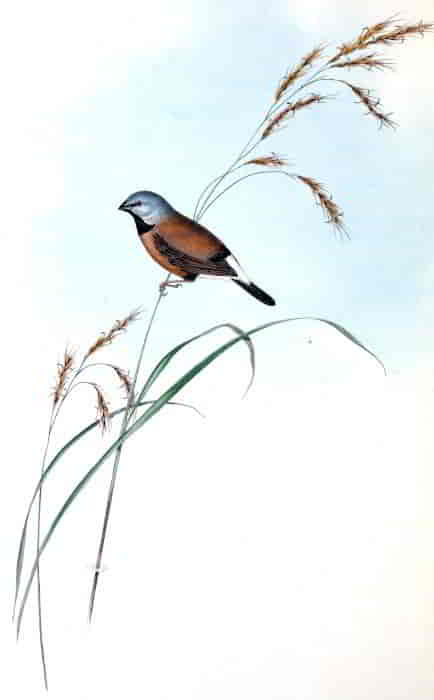
POËPHILA CINCTA: Gould.
J. Gould and H. C. Richter delt. C. Hullmandel Imp.
POËPHILA CINCTA, Gould.
Banded Grass Finch.
Amadina cincta, Gould in Proc. of Zool. Soc., Part IV. p. 105.
This species is tolerably abundant on the Liverpool Plains, and the open country to the northward towards the interior. It occurs so rarely on the sea side of the ranges, that I only once met with it during my sojourn in New South Wales. It is doubtless a native of the great basin of the interior, where, like the P. acuticauda and P. personata, it frequents those parts of the open plains which abound in grasses, upon the seeds of which and other plants it mostly subsists. The range of this species is entirely unknown; I have never seen a specimen except from the localities above mentioned.
Crown of the head and back of the neck grey; ear-coverts and sides of the neck silvery grey; throat and lores black; back, chest and abdomen chestnut-brown; wings the same, but darker; lower part of the body surrounded by a black band; tail-coverts white; tail black; bill black; irides reddish brown; eyelash blackish brown; feet pink-red.
The female differs from her mate by all her markings being much more obscurely defined.
The figure is that of a male of the natural size.
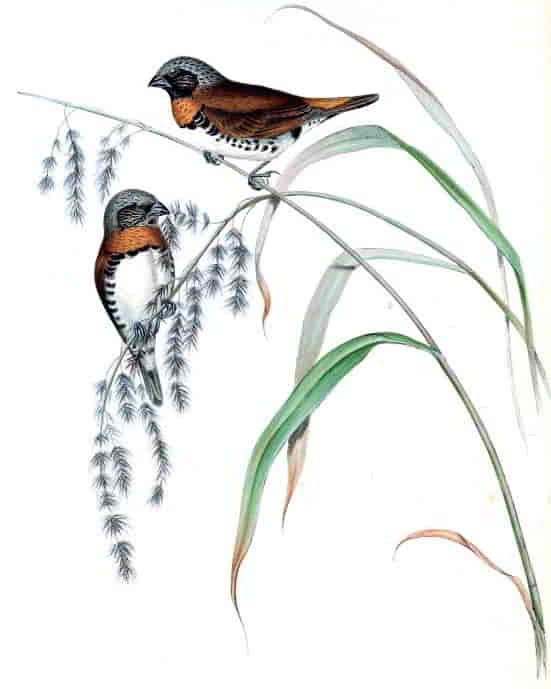
DONACOLA CASTANEOTHORAX: Gould.
J. Gould and H. C. Richter delt. C. Hullmandel Imp.
DONACOLA CASTANEOTHORAX, Gould.
Chestnut-breasted Finch.
Amadina castaneothorax, Gould in Syn. Birds of Australia, Part II.
Judging from the extreme rarity of this species in European collections, its true locality can scarcely as yet have been visited by naturalists. I observed several specimens in the Museum at Sydney; these, as well as those I possess, were obtained at Moreton Bay; the productions of which part of Australia are less known than might have been expected, considering how long it has been colonized. I had not the good fortune to meet with this bird in a state of nature, but I have been informed that it frequents reed-beds on the banks of rivers and lagoons, and that it much resembles the Bearded Tit (Calamophila biarmicus) of Europe, in the alertness with which it passes up and down the upright stems of the reeds, from the lower part to the very top, a habit for which the lengthened and curved form of its claws seems well adapted.
The sexes appear to differ but little in colouring; in some individuals, however, the cheeks and throat are black instead of brown, a character doubtless dependent on age or season.
I have not as yet seen this bird from the northern or western coast.
Crown of the head and back of the neck grey, the centre of each feather being brown; cheeks, throat and ear-coverts blackish brown in some specimens, each feather slightly tipped with pale buff; upper surface and wings reddish brown; upper tail-coverts orange; tail brown, margined with paler brown; across the chest a broad band of pale chestnut, bounded below by a line of black, which gradually widens towards the flanks, along which it is continued for some distance; the remainder of the feathers on this part white, with a spot of blackish brown at the extremity of each; abdomen white; thighs black; under tail-coverts white, with a spot of blackish brown at the extremity of each; bill black; feet brown.
The figures are of the natural size.
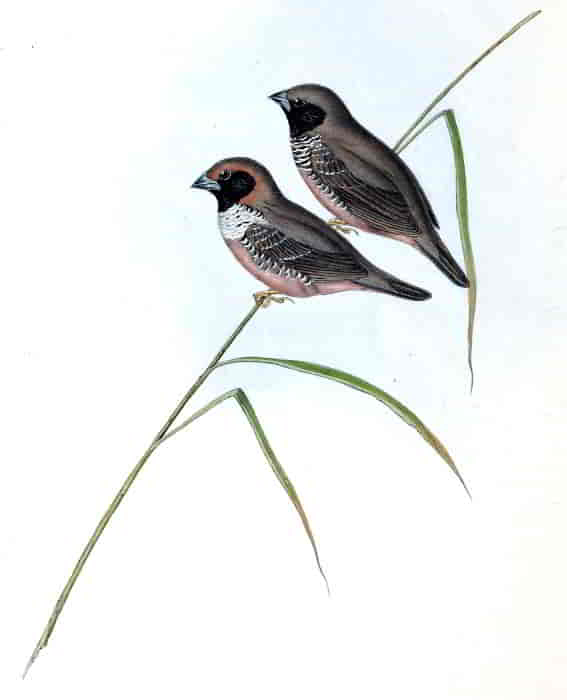
DONACOLA PECTORALIS: Gould
J. Gould and H. C. Richter delt. C. Hullmandel Imp.
DONACOLA PECTORALIS, Gould.
White-breasted Finch.
Amadina pectoralis, Gould in Proc. of Zool. Soc., Part VIII. p. 127.
For two beautiful specimens of this entirely new Finch I am indebted to E. Dring, Esq., of the Beagle, who procured them on the north-west coast of Australia: no notes of their habits or economy having been forwarded with the specimens, I am unable to give any particulars respecting them.
In structure and in the general disposition of its markings, the White-breasted Finch offers a considerable resemblance to the Donacola castaneothorax of the eastern coast, and in all probability they are analogues of each other, in accordance with a law which appears very generally to prevail among the birds of Australia; each great division of this vast country having its own peculiar species.
Crown of the head, all the upper surface and wings delicate greyish brown; the tips of the wing-coverts very minutely spotted with white; tail blackish brown; throat and ear-coverts glossy blackish purple; chest crossed by a band of feathers, black at the base, largely tipped with white; abdomen and under tail-coverts vinous grey; flanks ornamented with a few feathers similar to those crossing the breast; bill bluish horn-colour; feet flesh-colour.
The figures in the Plate are of the natural size, and are supposed to represent the two sexes; the principal figure the male.
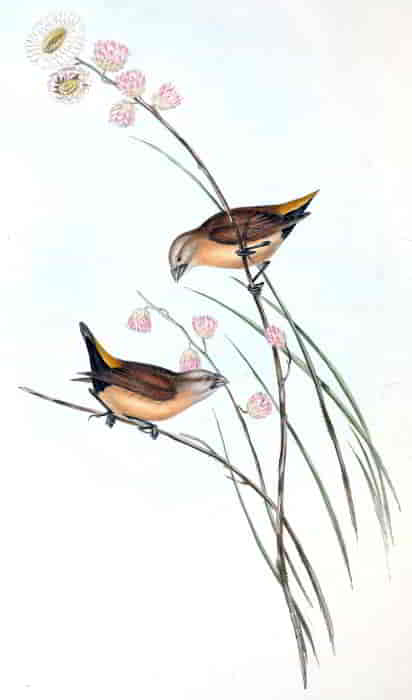
DONACOLA FLAVIPRYMNA: Gould.
J. Gould and H. C. Richter del et lith. Hullmandel & Walton Imp.
DONACOLA FLAVIPRYMNA, Gould.
Yellow-rumped Finch.
Donacola flaviprymna, Gould in Proc. of Zool. Soc., part xiii. p. 80.
A single specimen, and the only one I have ever seen of this pretty Finch, was presented to me by Benjamin Bynoe, Esq., Surgeon, R.N., who procured it on the banks of the Victoria River during the late surveying voyage of H.M.S. Beagle. It is very nearly allied to the Donacola castaneothorax, but is specifically distinct from that as well as from every other known species of this now numerous tribe of birds. I regret to add that nothing whatever is known of its habits or mode of life; but in these respects it doubtless as closely assimilates to its congeners as it does in form.
Head pale fawn-colour; back and wings light chestnut-brown; under surface buff; upper tail-coverts wax-yellow; under tail-coverts black; tail brown.
The figures are of the natural size.
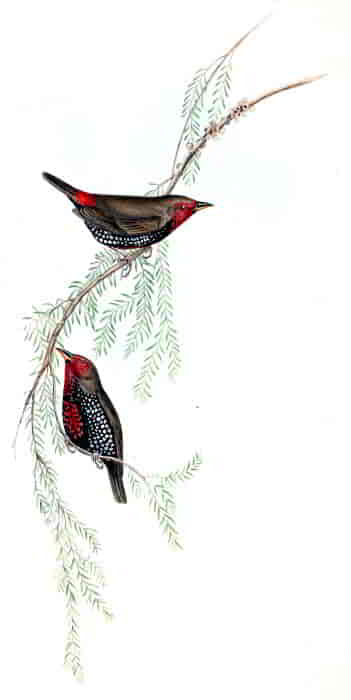
EMBLEMA PICTA: Gould.
J. Gould and H. C. Richter delt. C. Hullmandel Imp.
EMBLEMA PICTA, Gould.
Painted Finch.
Emblema picta, Gould in Proc. of Zool. Soc., 1842.
This beautiful Finch is a native of the north-west coast of Australia, where it was procured by B. Bynoe, Esq. The single individual sent me by that gentleman, and which I have drawn in two different positions, was unaccompanied by any account whatever of its habits and economy; but we may reasonably infer from the lengthened and pointed form of its bill, that the kind of food upon which it subsists will be somewhat different from that of the other Australian Finches. My readers will not fail to observe how singular is the disposition of the colouring in the present bird, the under parts being extremely beautiful, while on the upper, which is generally the most highly ornamented, a more than ordinary degree of plainness prevails.
Face and throat deep vermilion red; the base of all the feathers of the throat black, giving that part a mingled appearance of black and red; crown of the head, all the upper surface and wings brown; rump deep vermilion red; tail dark brown; chest and all the under surface jet-black, the flanks numerously spotted with white, and the centre of the abdomen dashed with deep vermilion red; feet light red; upper mandible black, under mandible scarlet, with a triangular patch of black at the base.
The figures are of the natural size.

